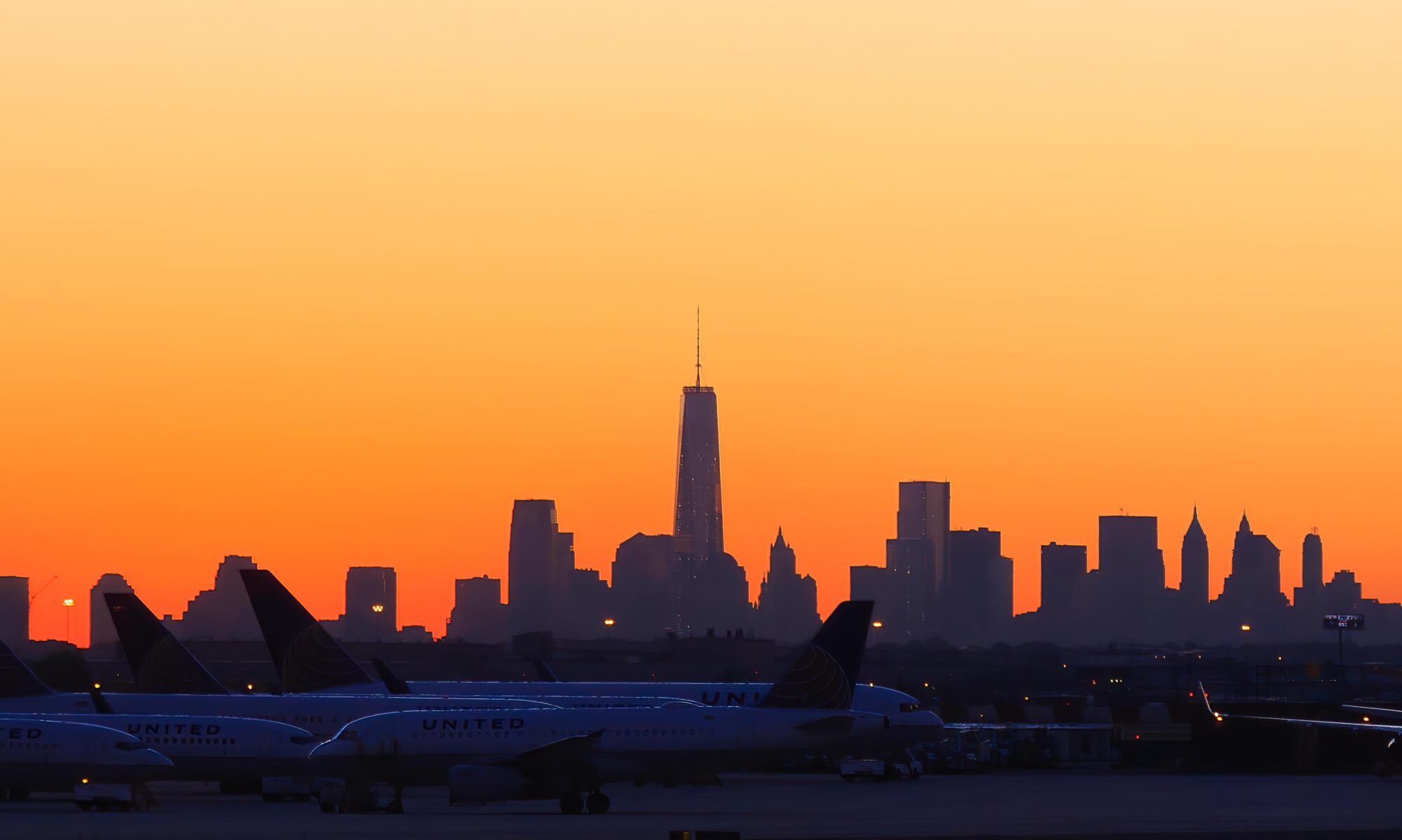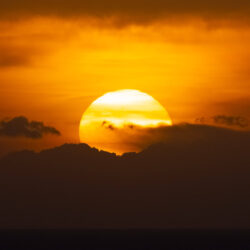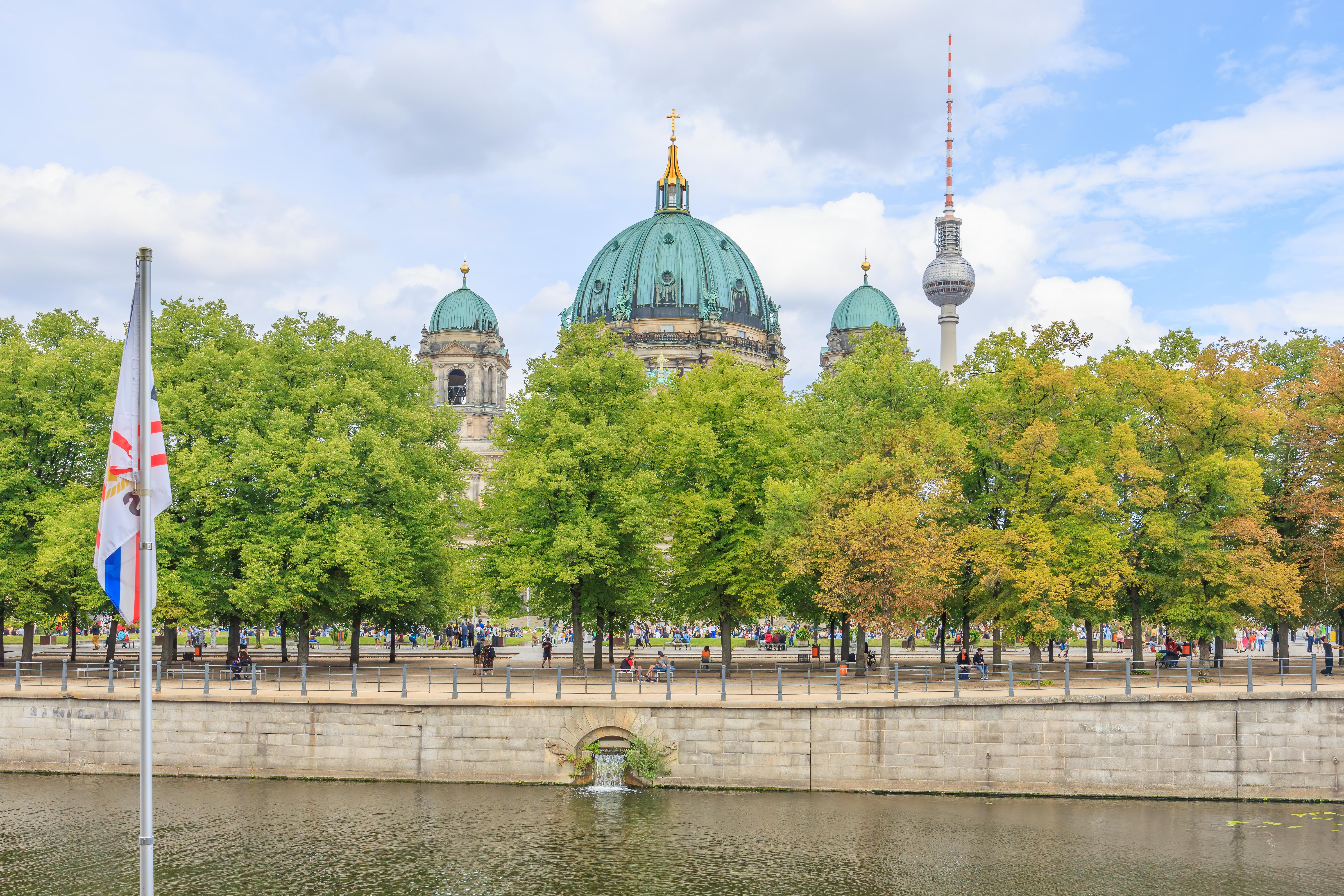After taking the ICE to Berlin, we dropped off our bags at The Westin Grand and started to walk to the east on Unter den Linden (Under the Linden). We walked to the Berliner Dom (Berlin Cathedral) before backtracking by U-Bahn. We unexpectedly encountered Christopher Street Day, a large pride event that was going on today. We spent a little bit of time at the event before walking through the nearby Memorial to the Murdered Jews of Europe. We then kept on walking to Potsdamer Platz where we saw our first Berlin Wall segments. We then took another brief U-Bahn ride followed by a short walk back to our hotel to end the day.
Nürnberg to Berlin by ICE
Our impression of the German public transportation system is that it is supposed to be highly efficient, almost as good as the Swiss or Japanese. Certainly better than mass transit in American which, generally speaking, isn’t even worth talking about. Overall, we’ve had pretty poor luck with German trains. There always seems to be some sort of issue or delay.
This time, we found out early in the morning after waking up that our train was cancelled. There seemed to be a replacement train at the exact same scheduled time but it wasn’t clear how to change our tickets for the new train. German laws are supposed to be quite good in terms of handling delays and cancellations but as foreigners we have no real idea what we’re supposed to do. In this case, we decided to leave the hotel earlier than planned to visit the Deutsche Bahn Reisezentrum (Travel Center) to sort things out.
It turned out that there were other train cancellations and delays, and the Reisezentrum wasn’t open yet. There was a line at a smaller customer service desk so we lined up for that. After talking to the representative there, it turns out no rebooking was required, though there would be no reserved seats available.
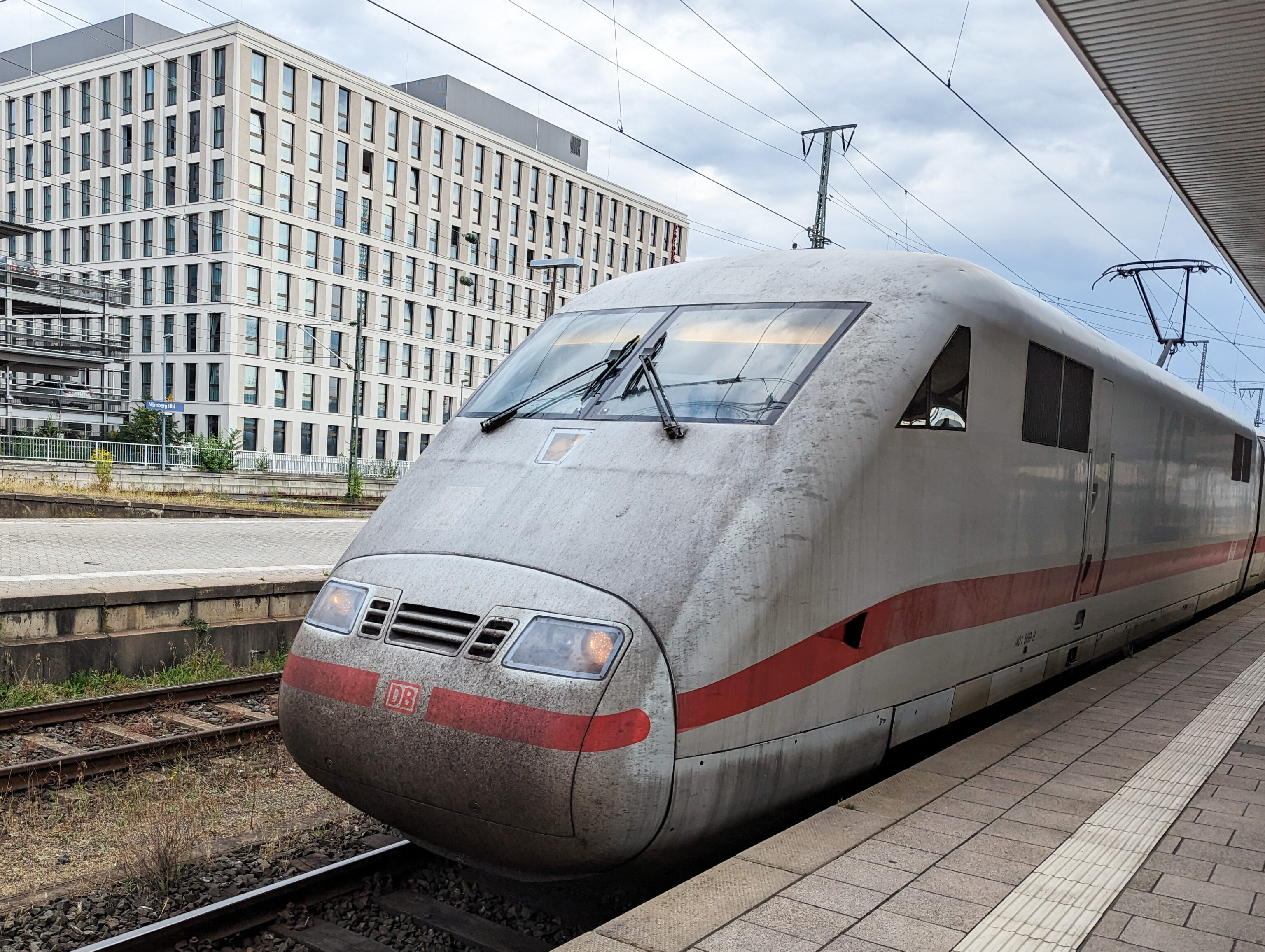
It was quite busy on the platform as we waited for our train to arrive. We decided to move to the end where there were less people. The German platforms don’t provide exact stopping locations like the Japanese Shinkansen but they at least have digital signs that indicate the train length and approximate car locations. Once the train arrived, it was pretty packed. We walked to try to find an empty pair of seats as all existing seat reservations were useless. This replacement train was a different type or configuration (train people refer to this as a consist?) so the car numbers and seats were different.
We lucked out that there was a family who had a baby carriage. There was only one place to put the carriage near their seats. It was in a part of the train where there was a pair of seats on one side but just one seat on the opposite, leaving a wider aisle. The baby carriage was parked there and was blocking an empty pair of seats. The family said something to us in German, we didn’t understand all the words but we did understand frei, or free. We took the pair of seats next to the baby carriage. Thank you, friendly German family!
Unter den Linden
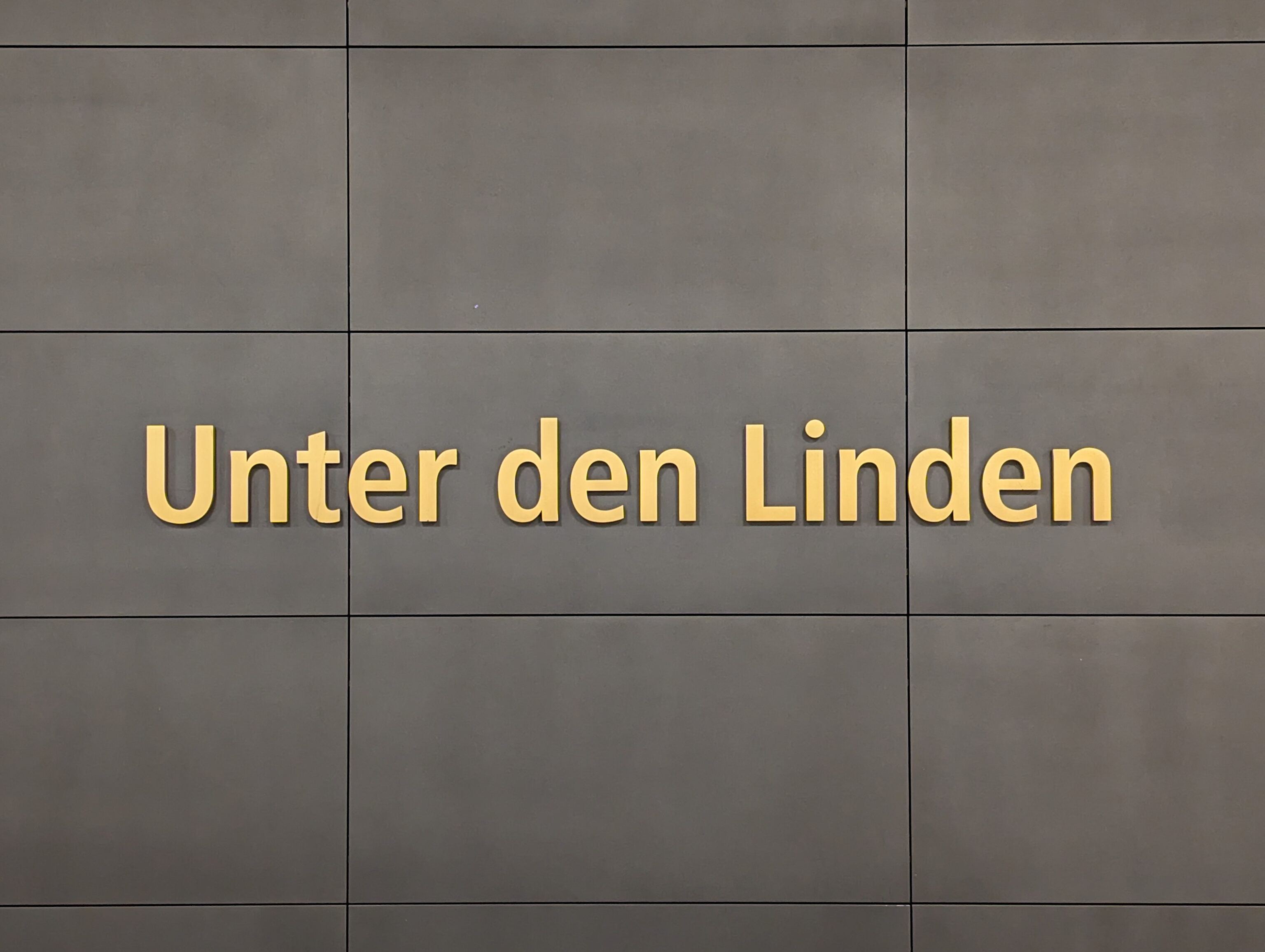
After arriving at the Berlin Hauptbahnhof an hour late due to unknown issues, we took a short U-Bahn ride on the U5 line to Unter den Linden (Under the Linden). The name of the station, and the street it is on, refers to the linden trees that line the path.
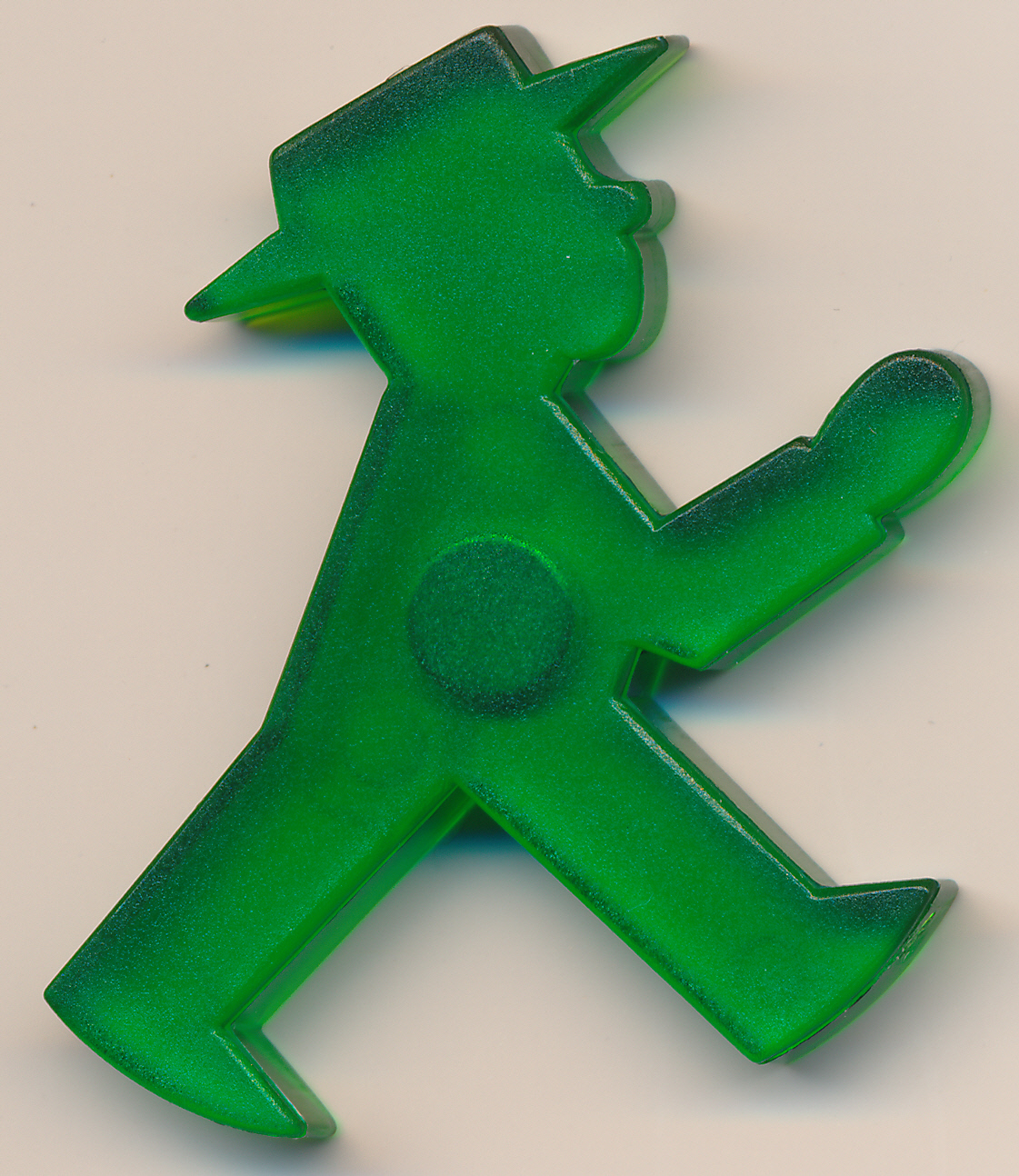
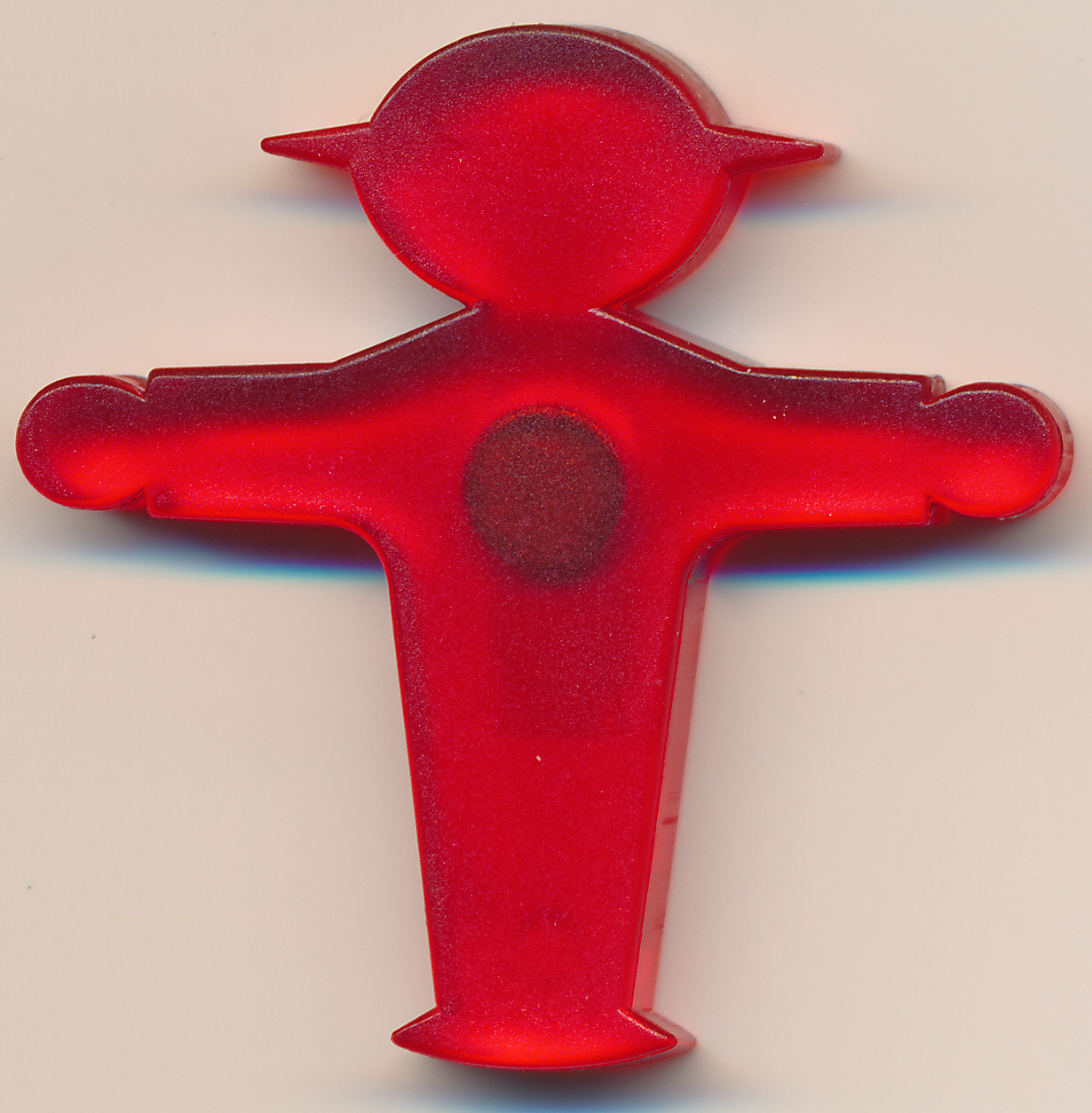
We got our first look at the Berlin pedestrian traffic lights with the East German ampelmännchen (traffic light men) and the Ampelmann store right at the same corner. These little men have become something of a symbol for Berlin and are well documented on the Ampelmann website’s brand history page. The first light with the ampelmännchen was right here at the corner of Unter den Linden and Friedrichstraße.
Our hotel, The Westin Grand Berlin, was one street away on the same block. Our room wasn’t ready yet so we left our bags and headed back out.
We were hungry so decided to get lunch. We picked a nearby restaurant on Unter den Linden, Nante Eck.
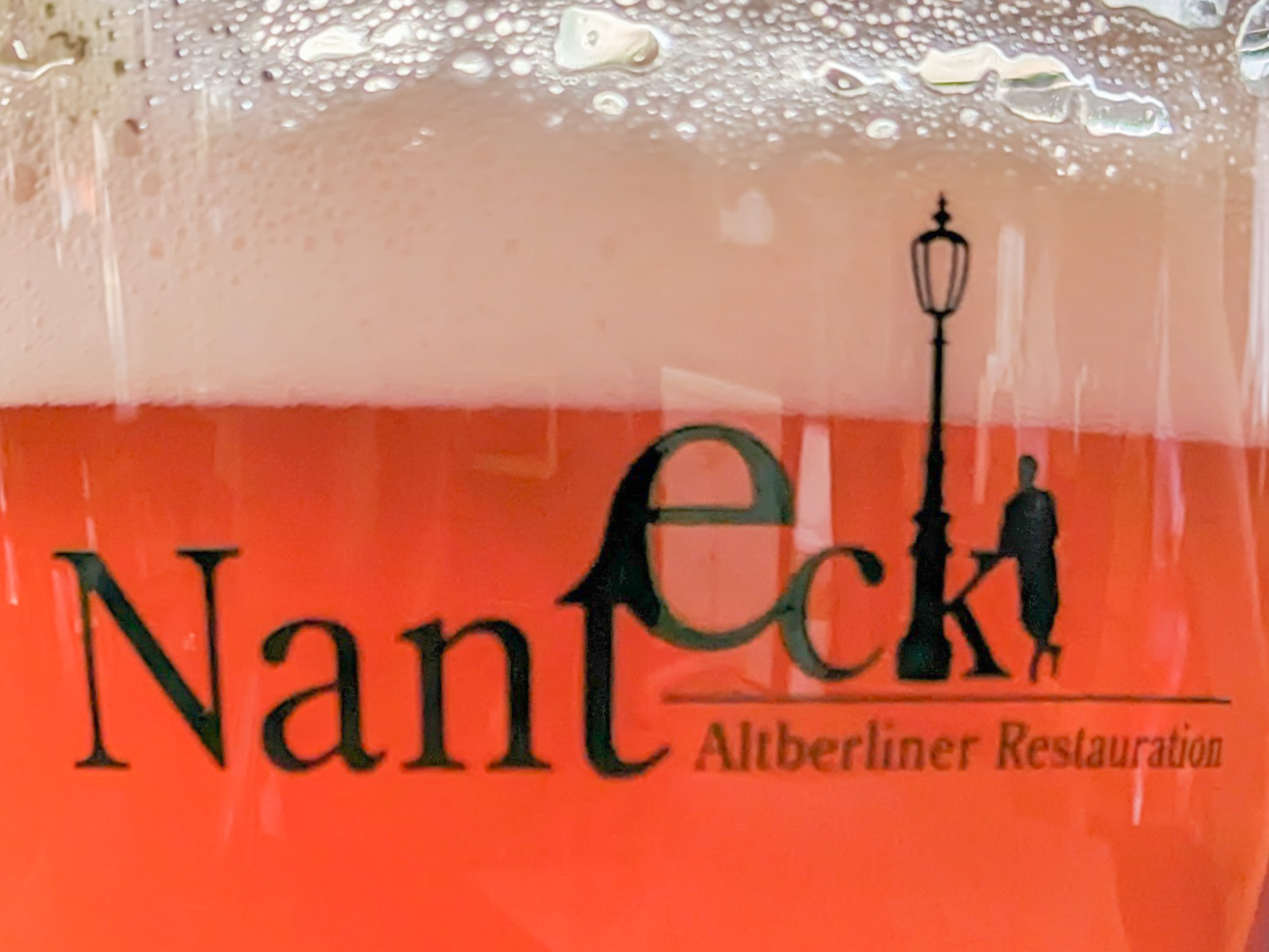
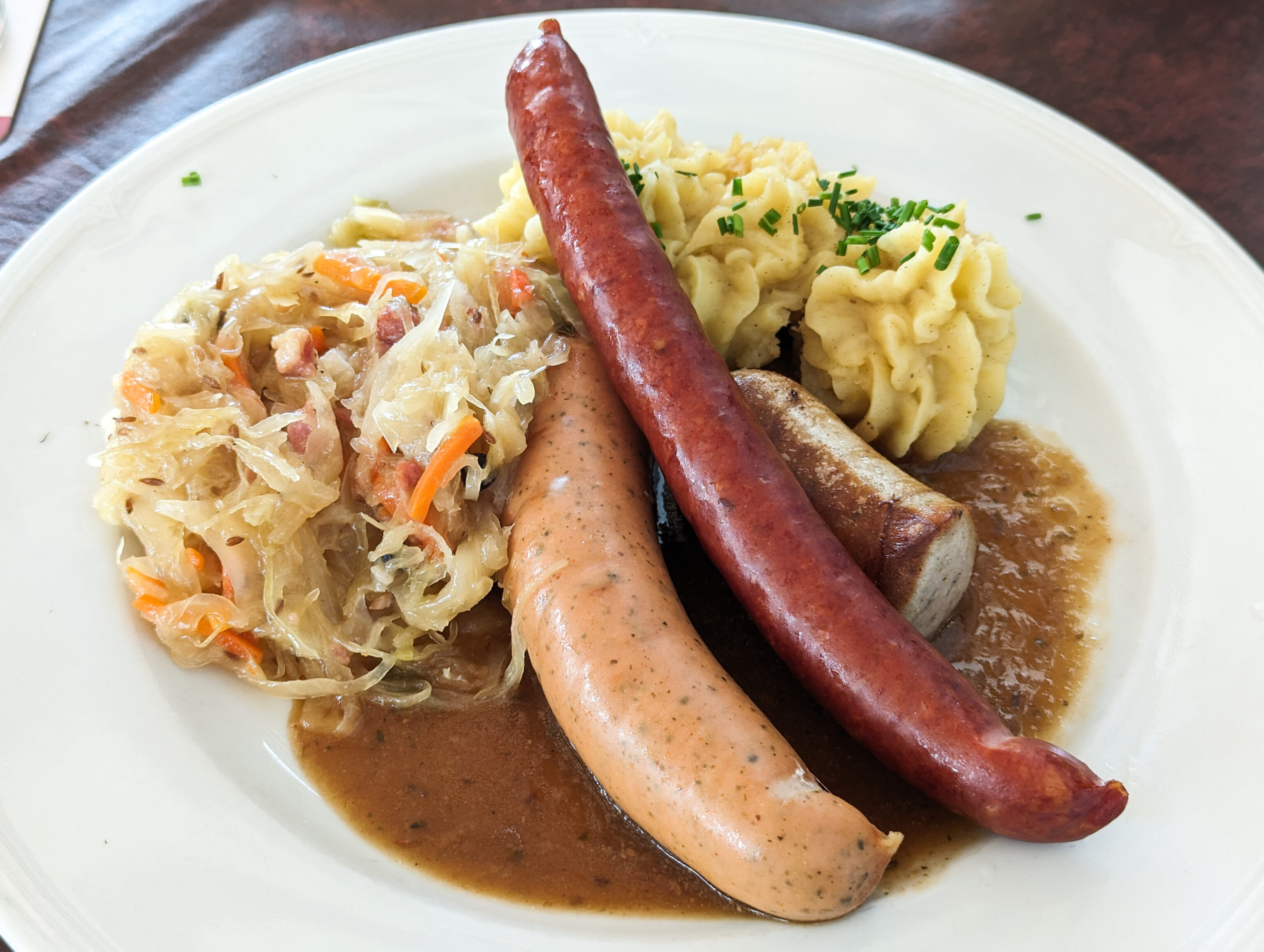
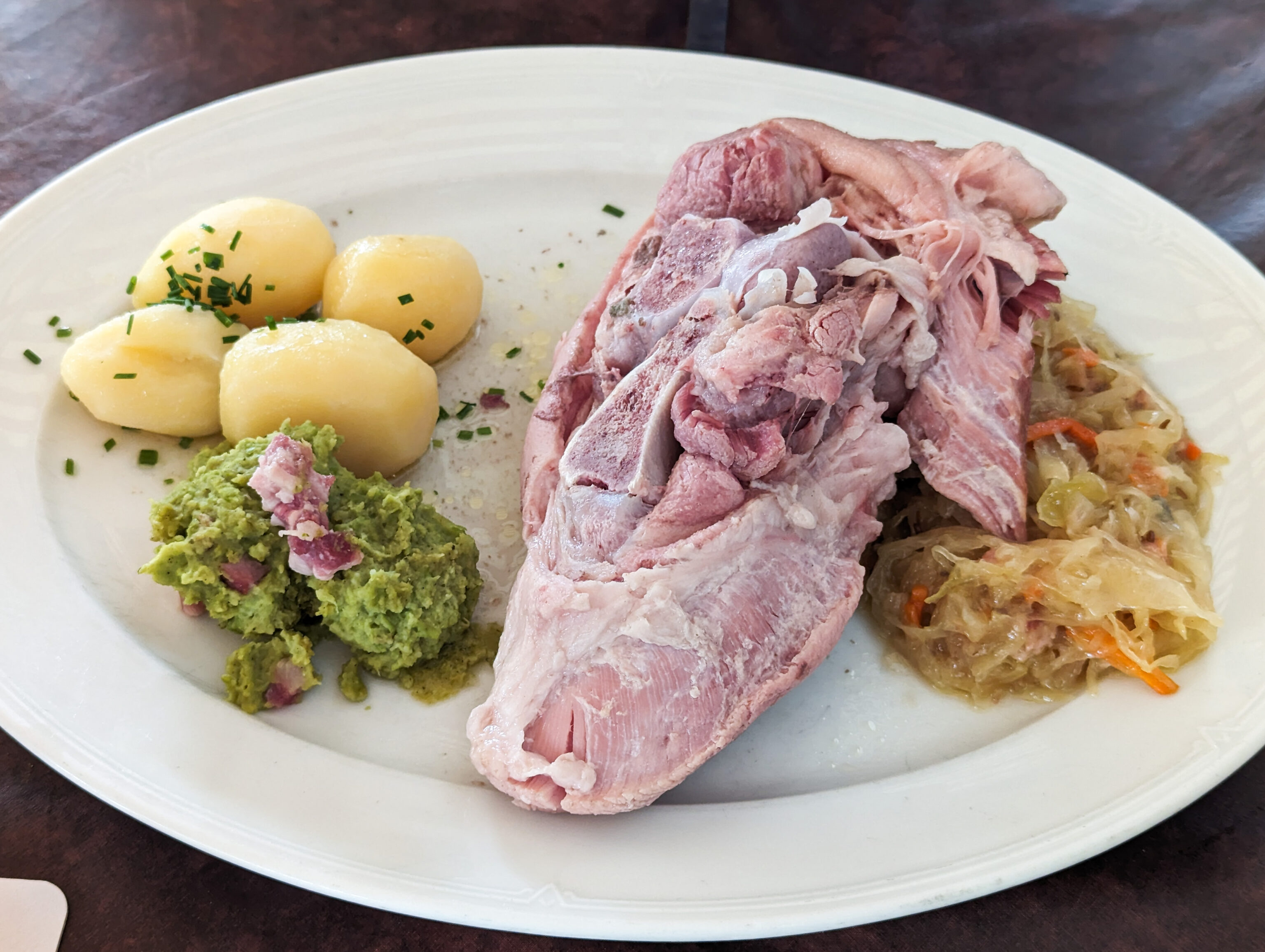
As usual for Germany, a rather filling meal! Everything was good. The pork knuckle tasted much better than it looks and was very tender. And, the shot of raspberry flavoring really helped to make the beer drinkable ![]()
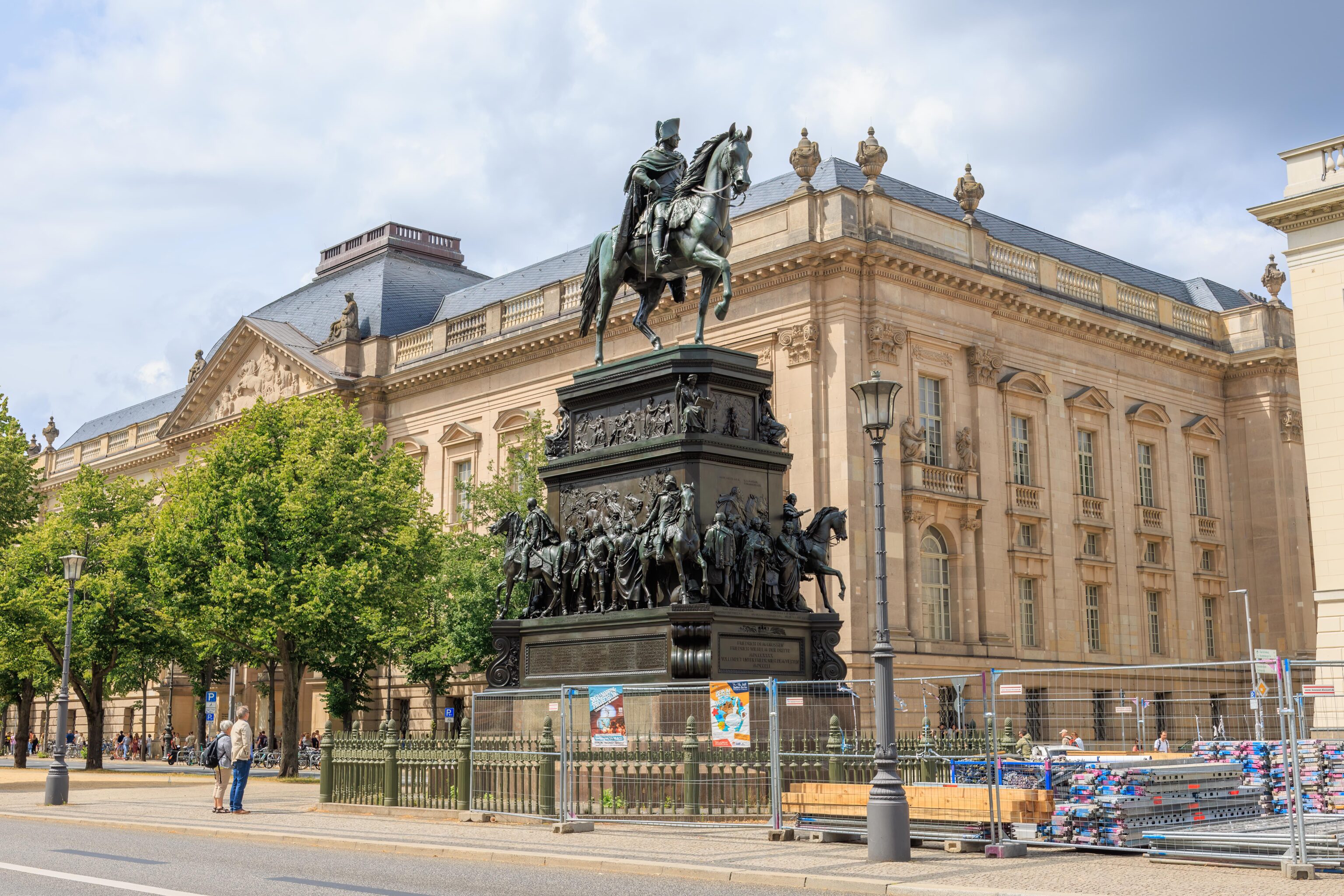
After eating, we started walking to the east. We noticed the Reiterstandbild Friedrichs des Großen (Equestrian Statue of Frederick the Great). The statue itself has some interesting history documented on its Wikipedia page. Frederick the Great was King Frederick II of Prussia. King of Prussia in Pennsylvania is named after an inn which was named after him.
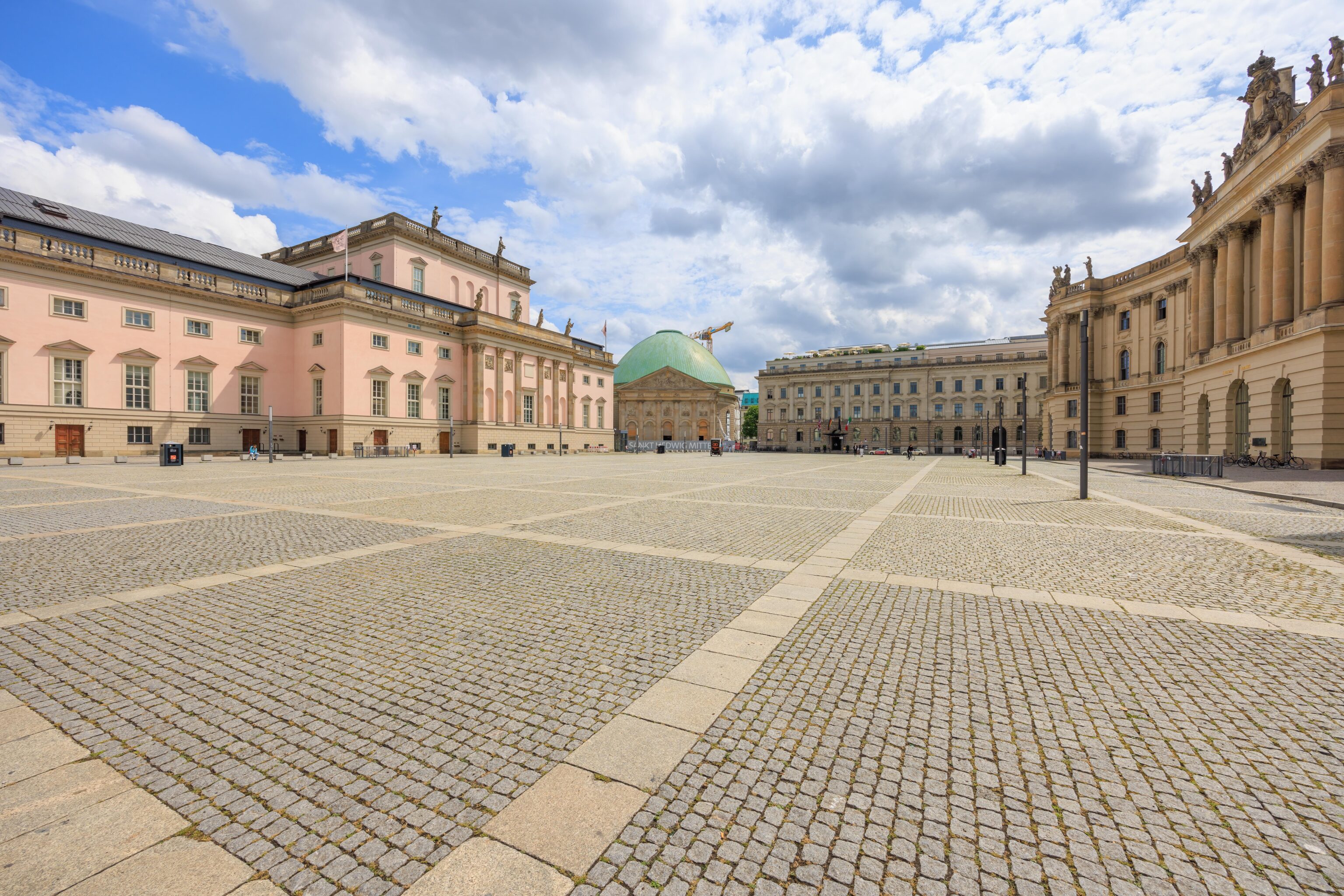
The statue is right by the Bebelplatz, a large plaza with buildings on three sides and Unter den Linden on the fourth.
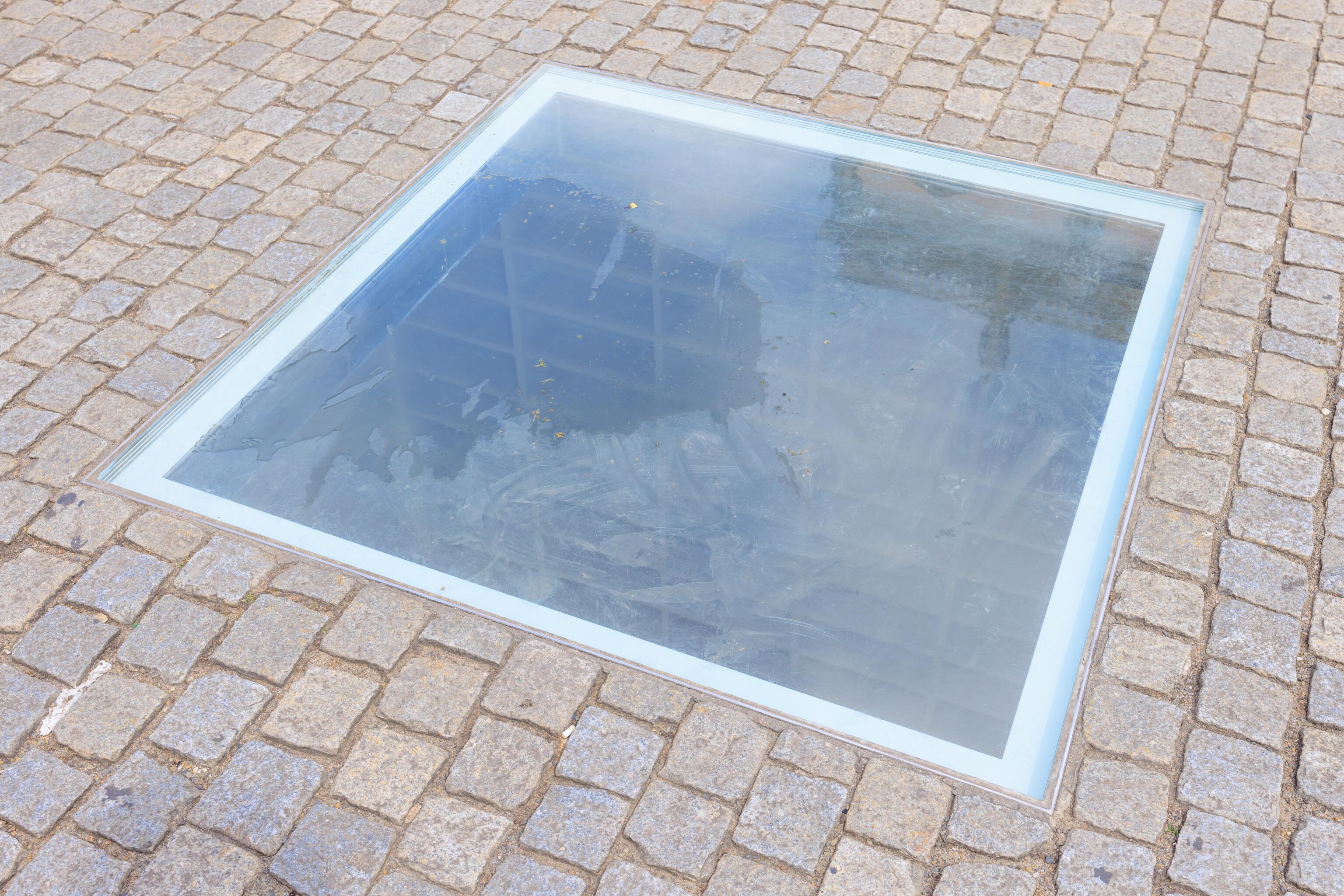
This plaza was the site of a Nazi book burning event in 1933. There is a memorial in the middle of the plaza where the burning took place. It is very easy to miss as it is underground, viewed via a pane of glass. The glass was pretty dirty at the time. And with the bright sunlight, it was hard to see through it. Inside, there is a room surrounded by empty bookshelves.
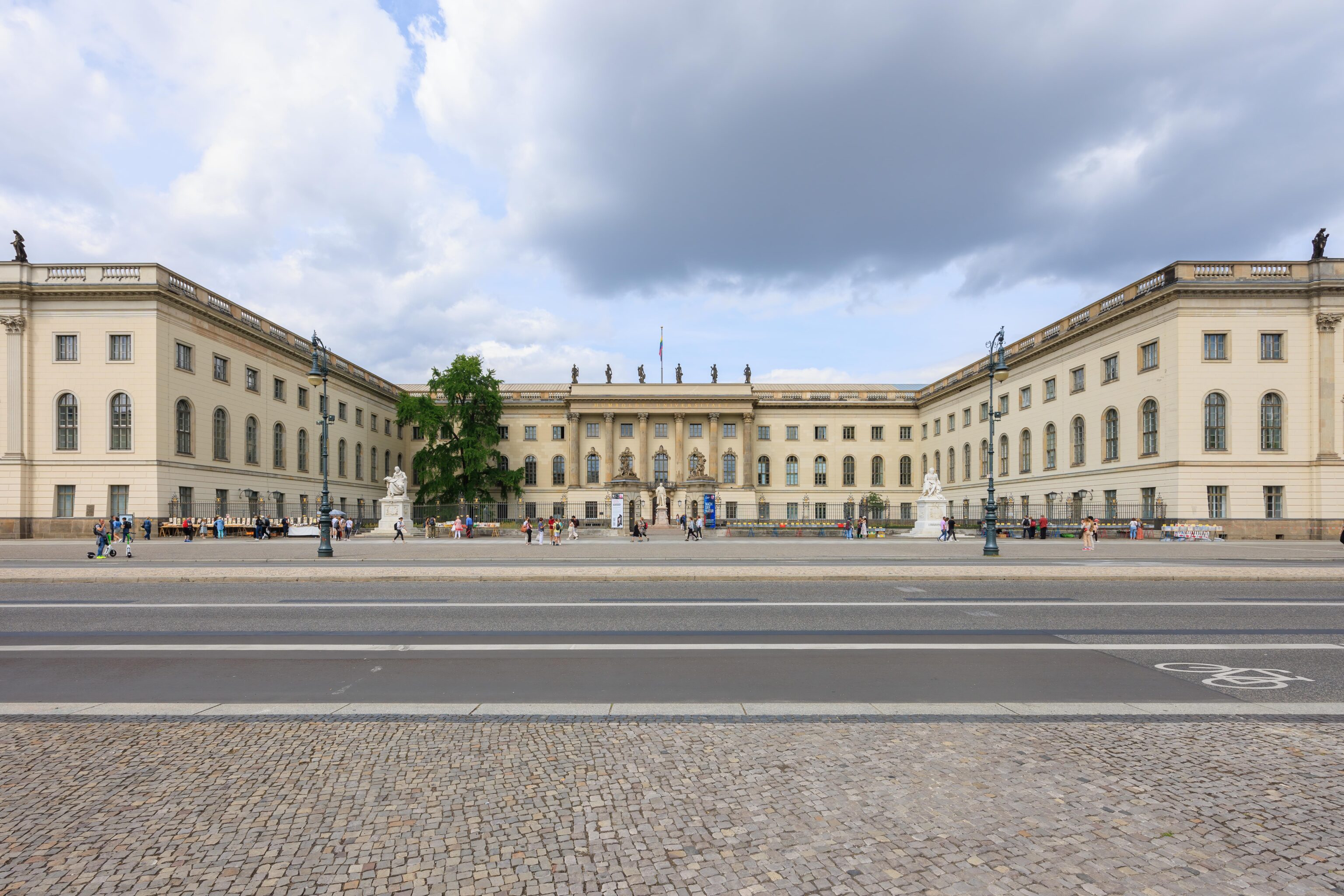
The Bebelplatz sits on the campus of Humboldt University, named after its founder, Wilhelm von Humboldt, the German Minister of Education. The university originally had a different name but was renamed by East Germany after the war. Humbodlt County in California, and the bay the county is named after, are both named for Alexander von Humboldt, an explorer and the brother of Wilhelm von Humboldt.
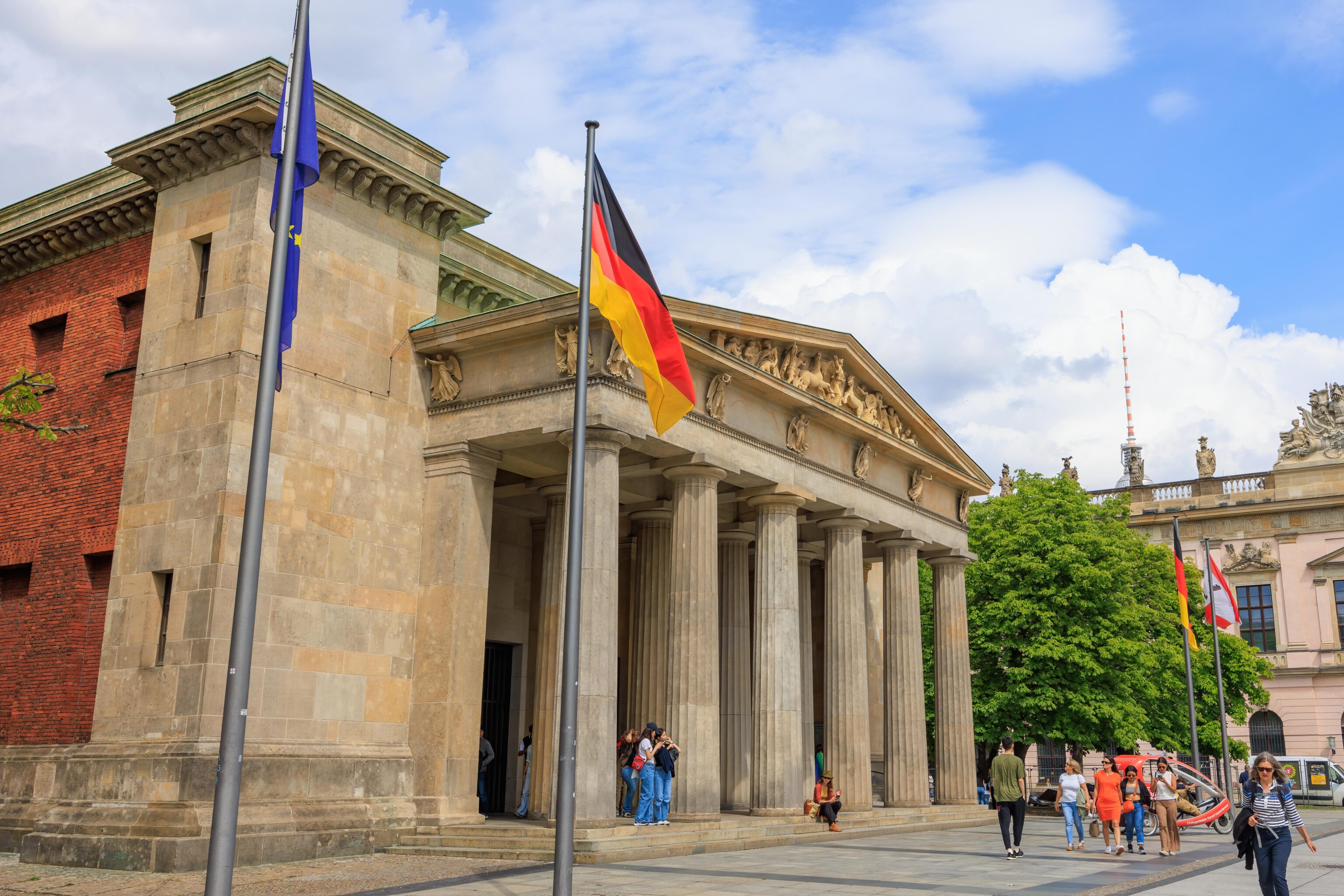
Our next destination, Neue Wache (New Guardhouse), was across the street, next to the main building of Humboldt University. This building contains the Central Memorial of the Federal Republic of Germany to the Victims of War and Dictatorship. Phew. That is a long name. While the building is much older and formerly served as a guardhouse, it has contained memorials since 1931.
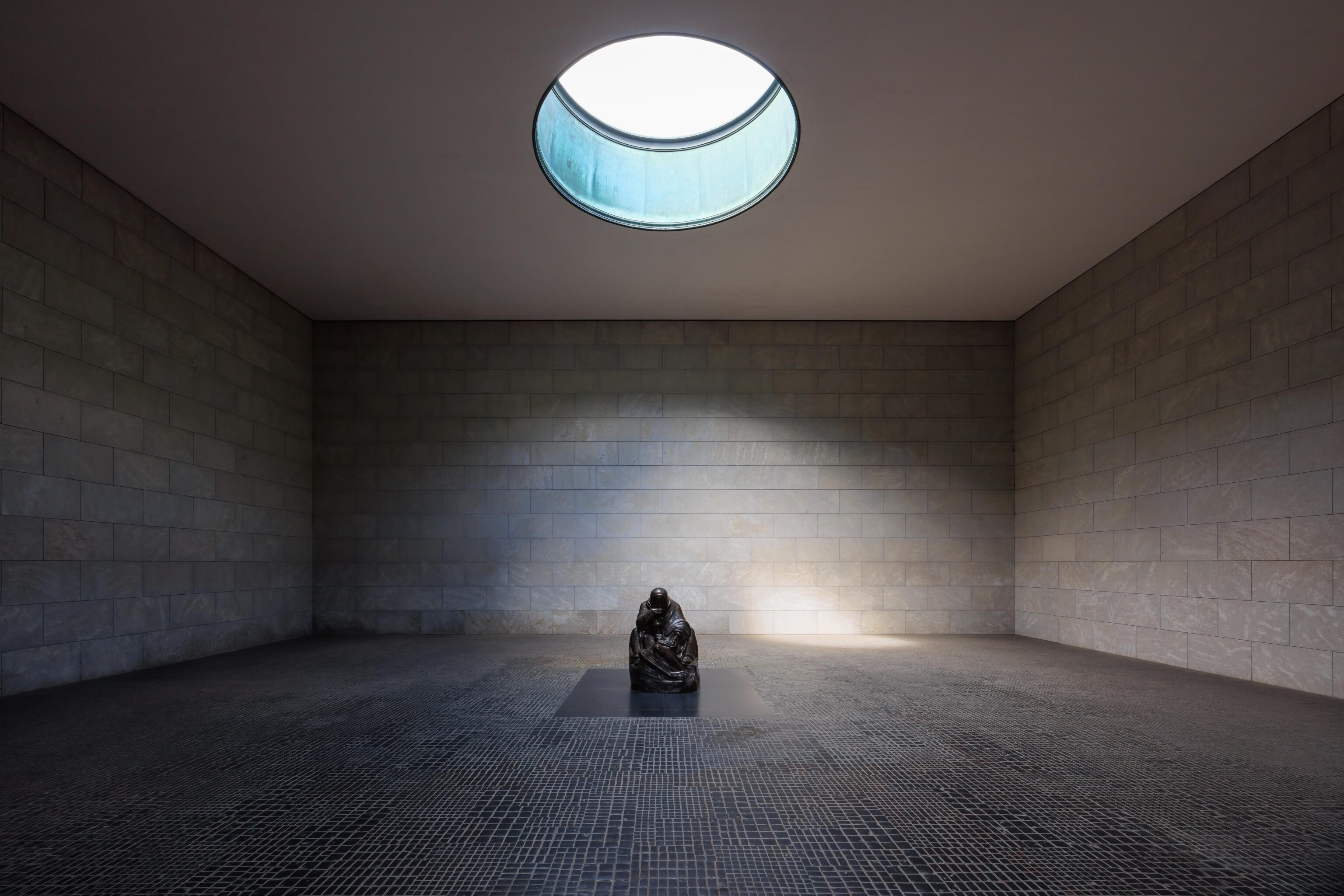
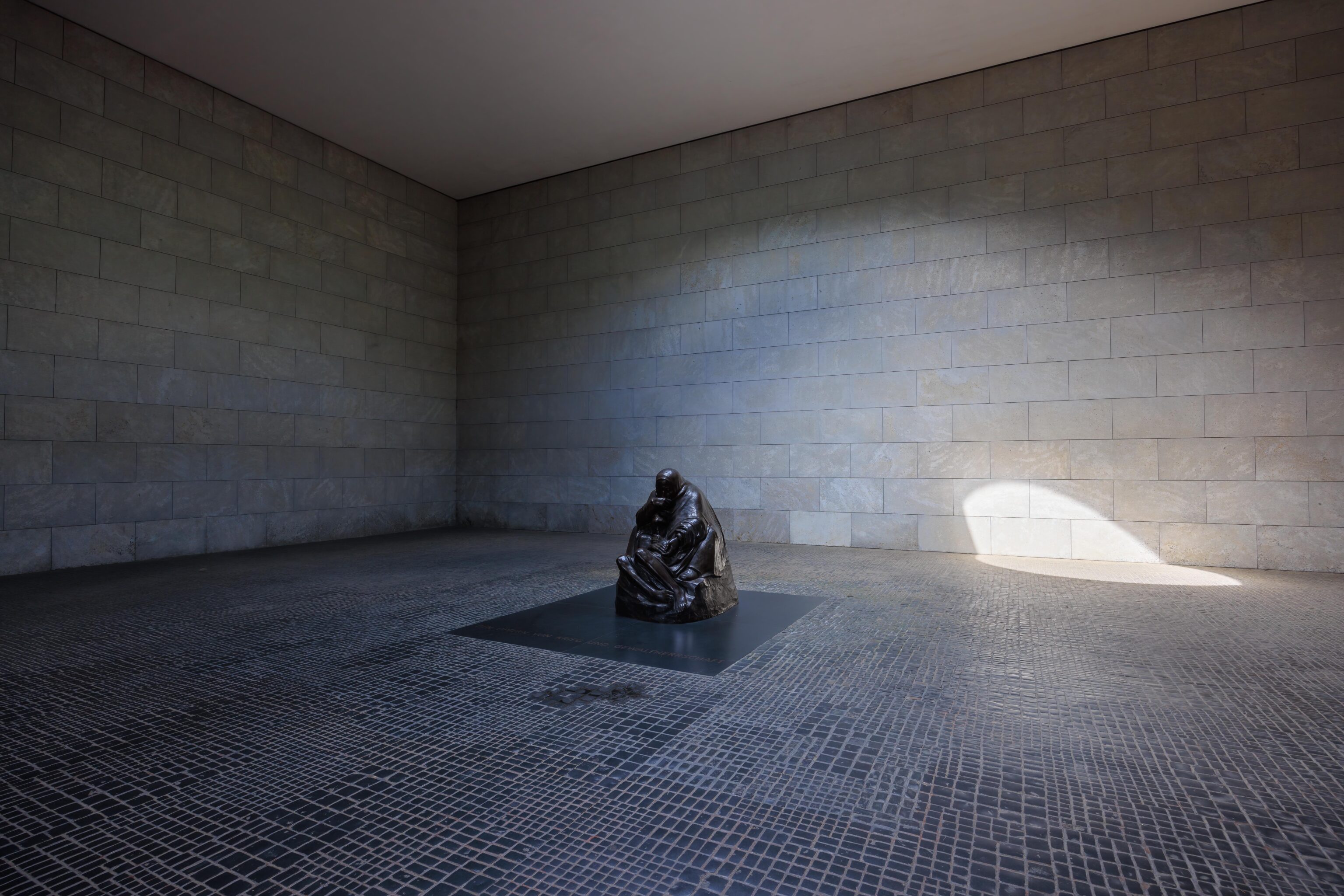
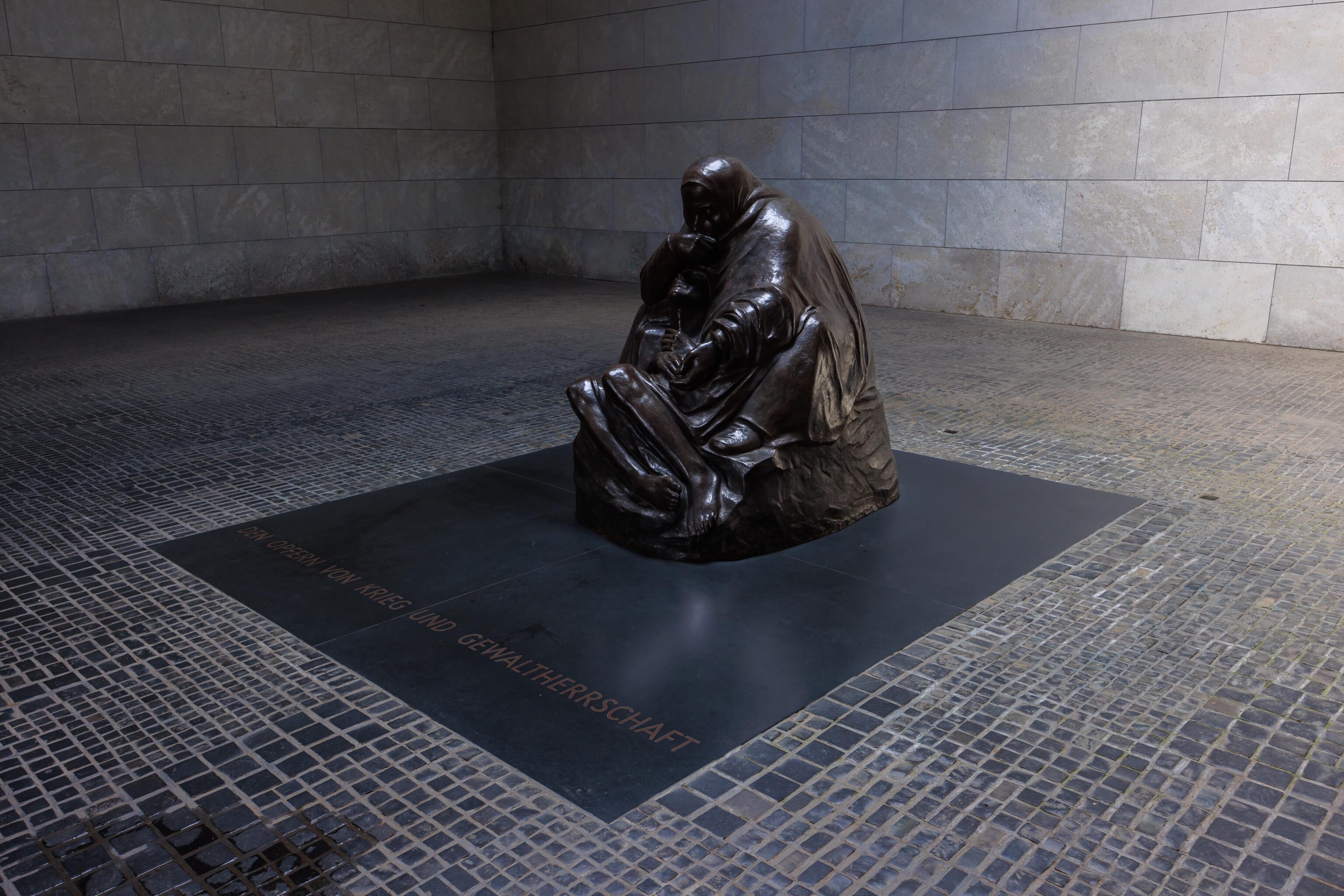
The memorial is simply an empty room with a statue, Mother with her Dead Son. There is a large circular opening above, though its not clear if the placement ever allows the sun to shine directly upon the statue.
There are plaques on the outside of the building by the doors with text in German. Translations are provided, including to English:
THE NEUE WACHE (NEW GUARDHOUSE) WAS BUILT IN THE YEARS 1816 TO 1818 ON BEHALF OF THE PRUSSIAN KING, FREDERICK WILLIAM III, ACCORDING TO A DESIGN BY KARL FRIEDRICH SCHINKEL. FROM 1818 UNTIL 1918 THE ROYAL PALACE GUARD- WAS LOCATED HERE. IN 1931 THE PRUSSIAN GOVERNMENT HAD THE GUARDHOUSE REDESIGNED. HEINRICH TESSENOW CREATED A "MEMORIAL TO THOSE WHO FELL IN THE WORLD WAR". IN THE CENTRE OF THE ROOM, WHICH WAS DESIGNED TO INVITE REFLECTION, STOOD A BLOCK OF GRANITE WITH A SILVER WREATH OF OAK LEAVES. SHORTLY BEFORE THE END OF THE SECOND WORLD WAR THE NEUE WACHE WAS SEVERELY DAMAGED BY BOMBS. FROM 1960 THE RESTORED BUILDING SERVED THE GDR AS A "MEMORIAL TO THE VICTIMS OF FASCISM AND MILITARISM". IN 1969 AN ETERNAL FLAME WAS LIT IN THE MIDDLE OF THE ROOM. IN 1969 THE MORTAL REMAINS OF AN UNKNOWN SOLDIER AND AN UNKNOWN CONCENTRATION CAMP PRISONER WERE LAID TO REST HERE. THEY ARE SURROUNDED BY EARTH FROM THE BATTLEFIELDS OF THE SECOND WORLD WAR AND FROM CONCENTRATION CAMPS. SINCE 1993 THE NEUE WACHE HAS SERVED AS THE CENTRAL MEMORIAL OF THE FEDERAL REPUBLIC OF GERMANY. THE INTERIOR DESIGN FROM THE TIME OF THE WEIMAR REPUBLIC WAS LARGELY RESTORED. AN ENLARGED REPLICA OF THE SCULPTURE BY KÄTHE KOLLWITZ KNOWN AS "MOTHER WITH HER DEAD SON" STANDS IN THE CENTRE OF THE MEMORIAL. IT WAS MADE BY HARALD HAACKE. THE NEUE WACHE IS THE PLACE WHERE WE COMMEMORATE THE VICTIMS OF WAR AND TYRANNY. WE HONOUR THE MEMORY OF THE PEOPLES WHO SUFFERED THROUGH WAR. WE REMEMBER THEIR CITIZENS WHO WERE PERSECUTED AND WHO LOST THEIR LIVES. WE REMEMBER THOSE KILLED IN ACTION IN THE WORLD WARS. WE REMEMBER THE INNOCENT WHO LOST THEIR LIVES AS A RESULT OF WAR IN THEIR HOMELAND, IN CAPTIVITY AND THROUGH EXPULSION. WE REMEMBER THE MILLIONS OF JEWS WHO WERE MURDERED. WE REMEMBER THE SINTI AND ROMA WHO WERE MURDERED. WE REMEMBER ALL THOSE WHO WERE KILLED BECAUSE OF THEIR ORIGIN, HOMOSEXUALITY, SICKNESS OR INFIRMITY. WE REMEMBER ALL WHO WERE MURDERED WHOSE RIGHT TO LIFE WAS DENIED. WE REMEMBER THE PEOPLE WHO HAD TO DIE BECAUSE OF THEIR RELIGIOUS OR POLITICAL CONVICTIONS. WE REMEMBER ALL THOSE WHO WERE VICTIMS OF TYRANNY AND MET THEIR DEATH, THOUGH INNOCENT. WE REMEMBER THE WOMEN AND MEN WHO SACRIFICED THEIR LIVES IN RESISTANCE TO DESPOTIC RULE. WE HONOUR ALL WHO PREFERRED TO DIE RATHER THAN ACT AGAINST THEIR CONSCIENCE. WE HONOUR THE MEMORY OF THE WOMEN AND MEN WHO WERE PERSECUTED AND MURDERED BECAUSE THEY RESISTED TOTALITARIAN DICTATORSHIP AFTER 1945.
The text is in all capital letters because that is how it is written on the translation sign.
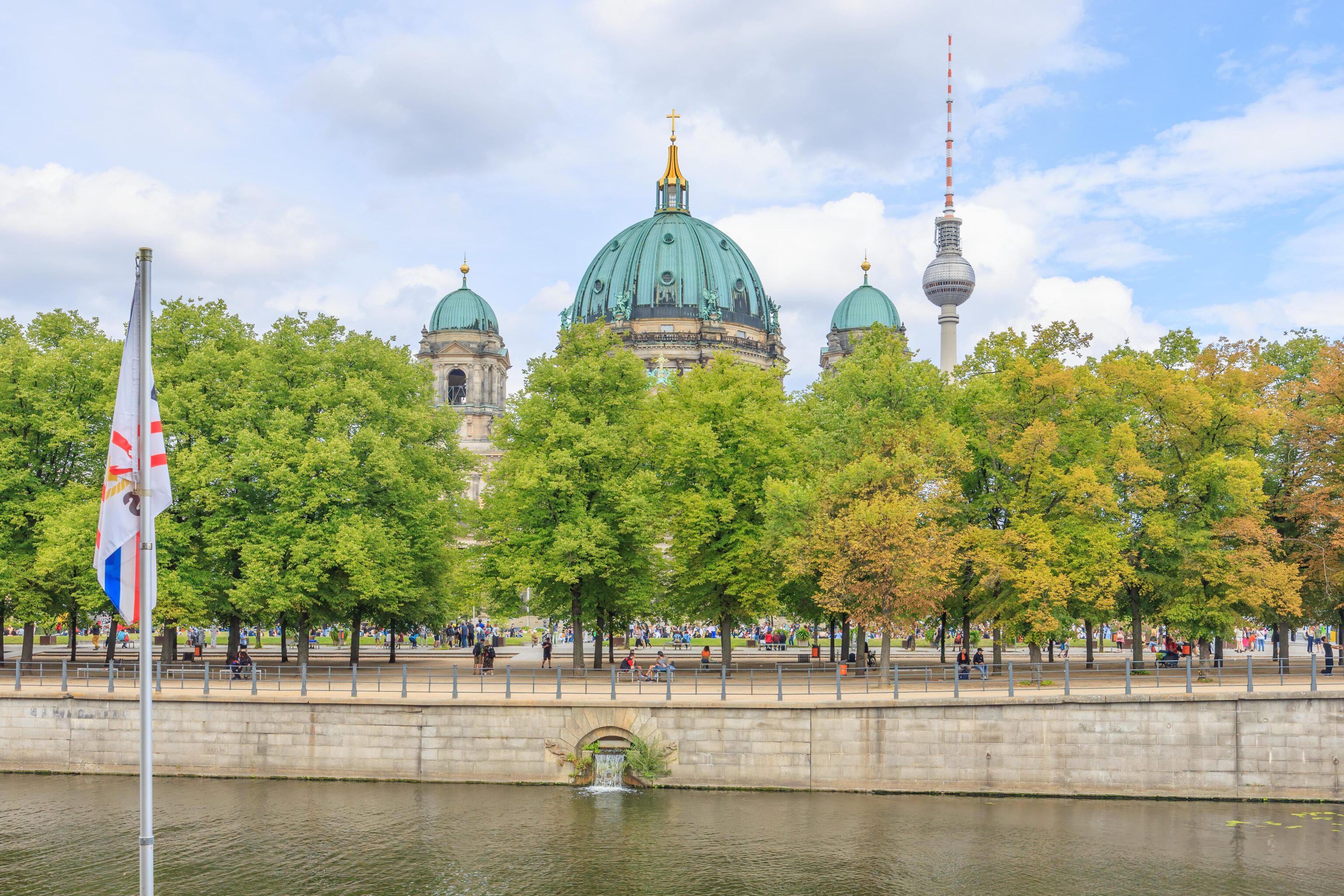
We continued walking to the east until reaching a river. Here, there is an island in the middle of the Spree, a river. The island is the Museum Island. It has museums. And a cathedral, the Berliner Dom (Berlin Cathedral). The tower in the background, the Berliner Fernsehturm (Berlin TV Tower), is not on the island.
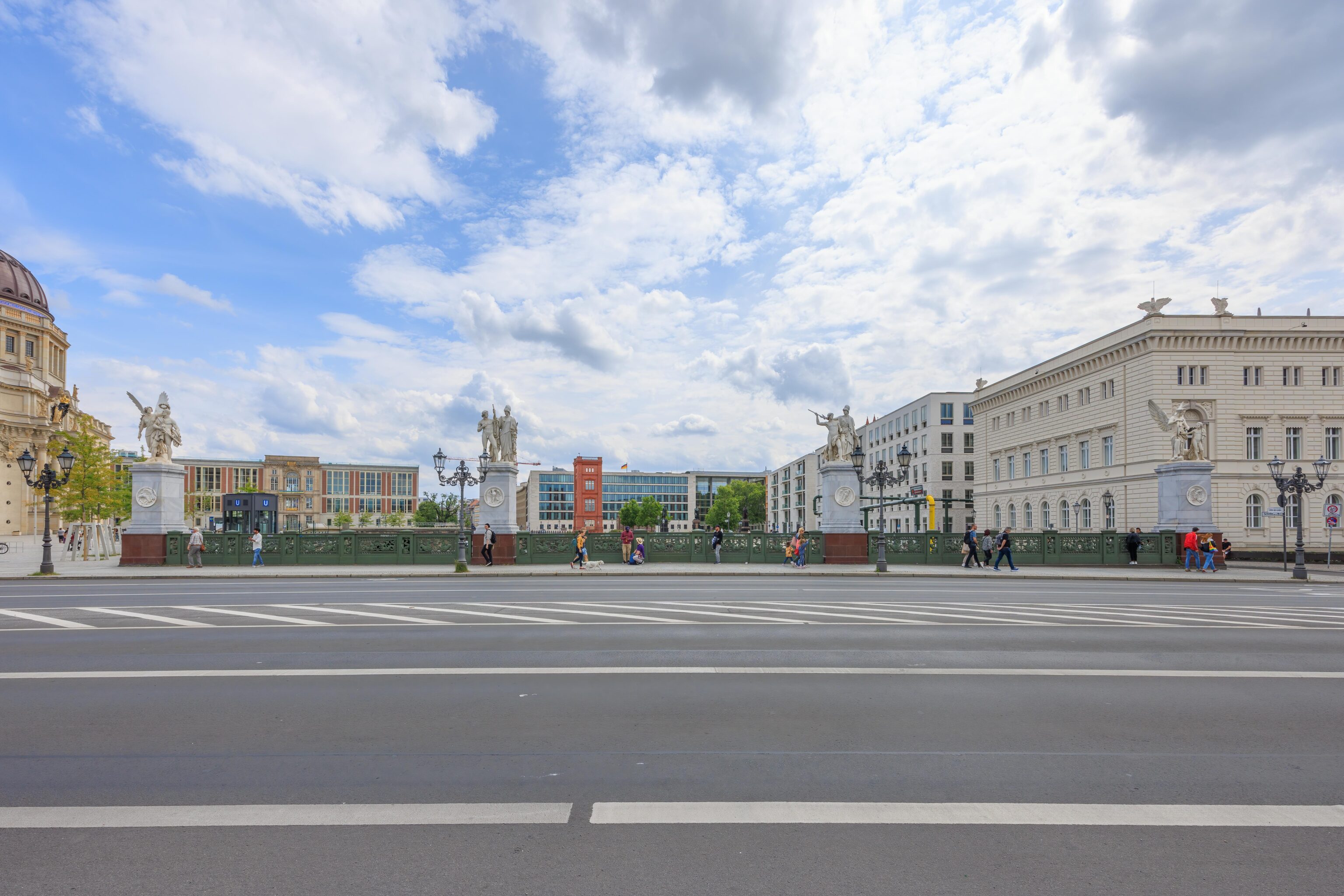
The bridge, the Schlossbrücke, is lined with four statues on either side. It is named after the adjacent former palace, a tiny portion of which is visible on the left.
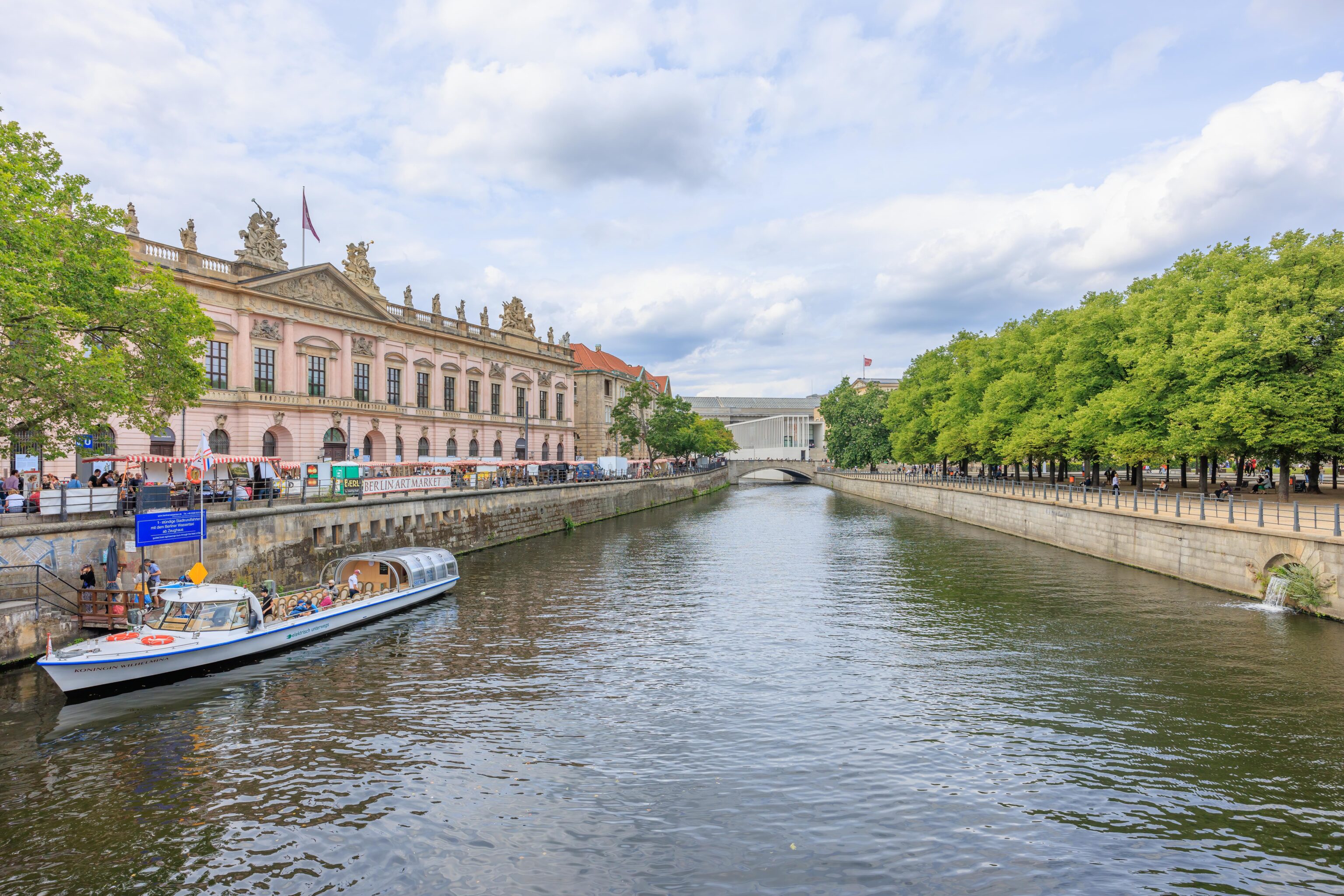
The pink building on the left is German Historical Museum, which we did not visit. The park on the right is the Lustgarten (Pleasure Garden). While some German words and names make sense in English without translation, this is not one of those names as the English implication is very different!
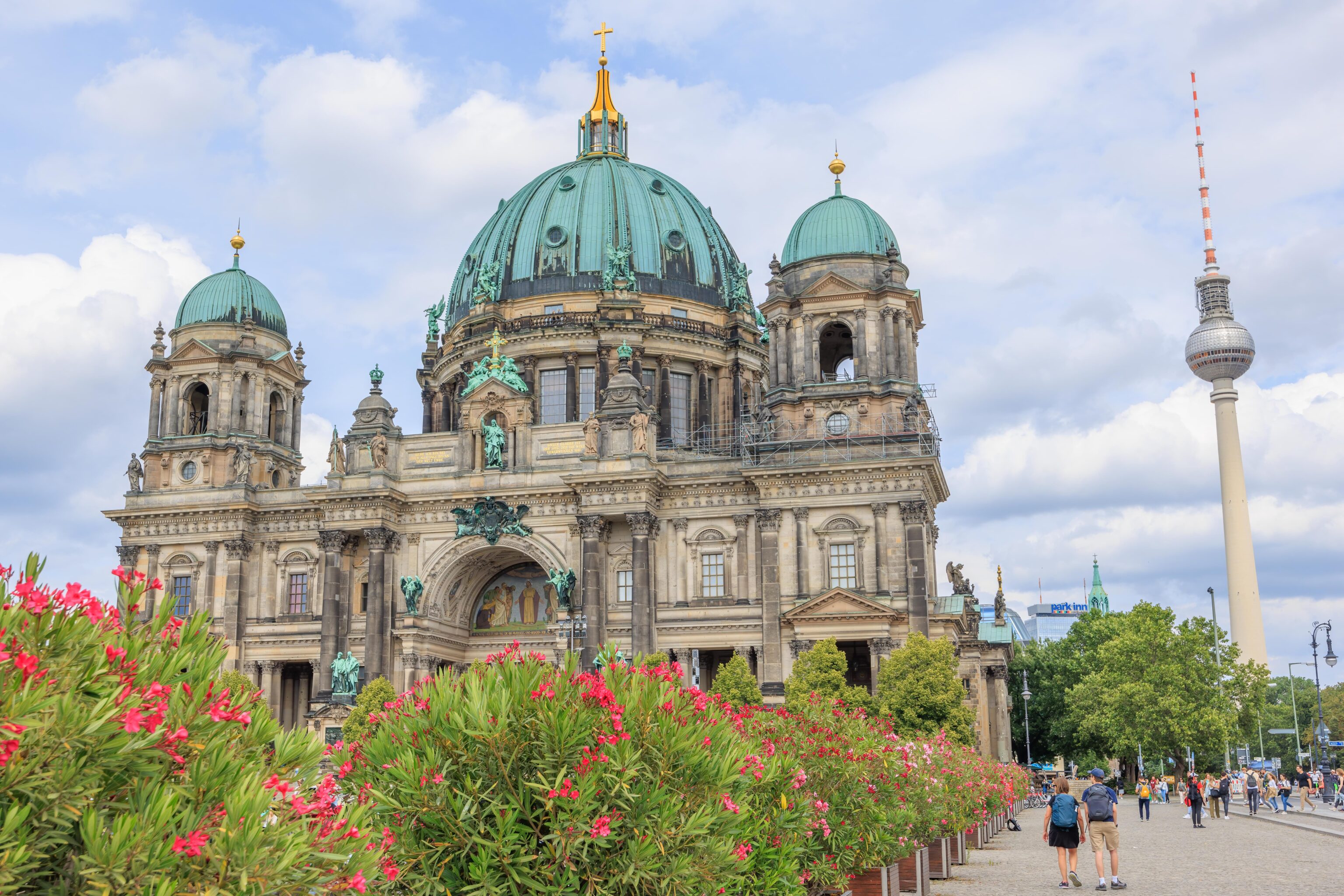
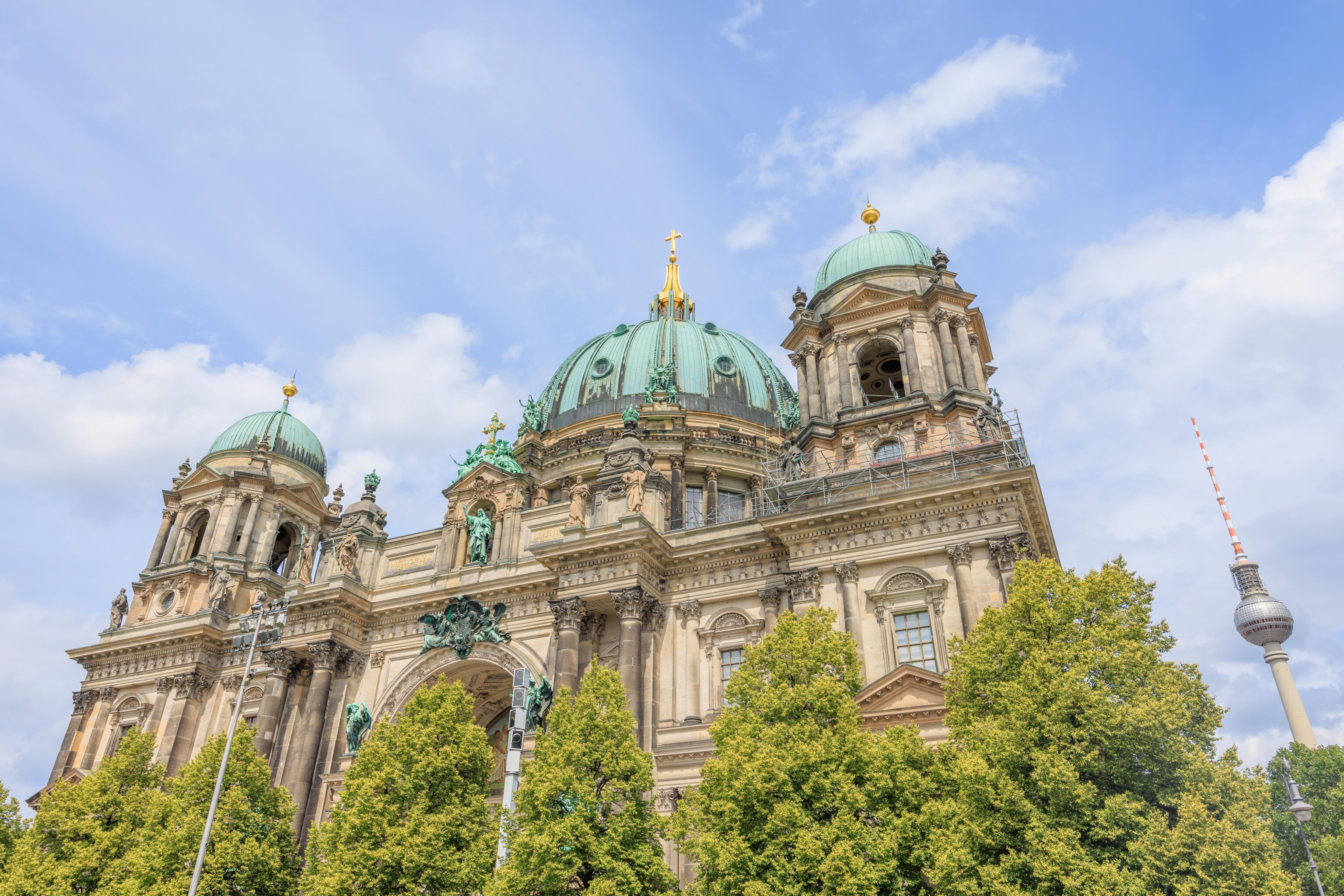
We decided to head to the Berliner Dom. The German word dom is often used to mean cathedral but in this case, it is not. The Wikipedia article has a great explanation:
The term Dom denotes a collegiate church (equivalent to the Italian duomo, or the English "Minster"); however, as most cathedrals are also collegiate churches, the term "Dom" has become the common term for a cathedral in German, though they are not synonymous. Berlin Cathedral has never been a cathedral in the actual sense of that term since it has never been the seat of a bishop. The bishop of the Evangelical Church in Berlin-Brandenburg (under this name 1945–2003) is based at St. Mary's Church and Kaiser Wilhelm Memorial Church in Berlin.
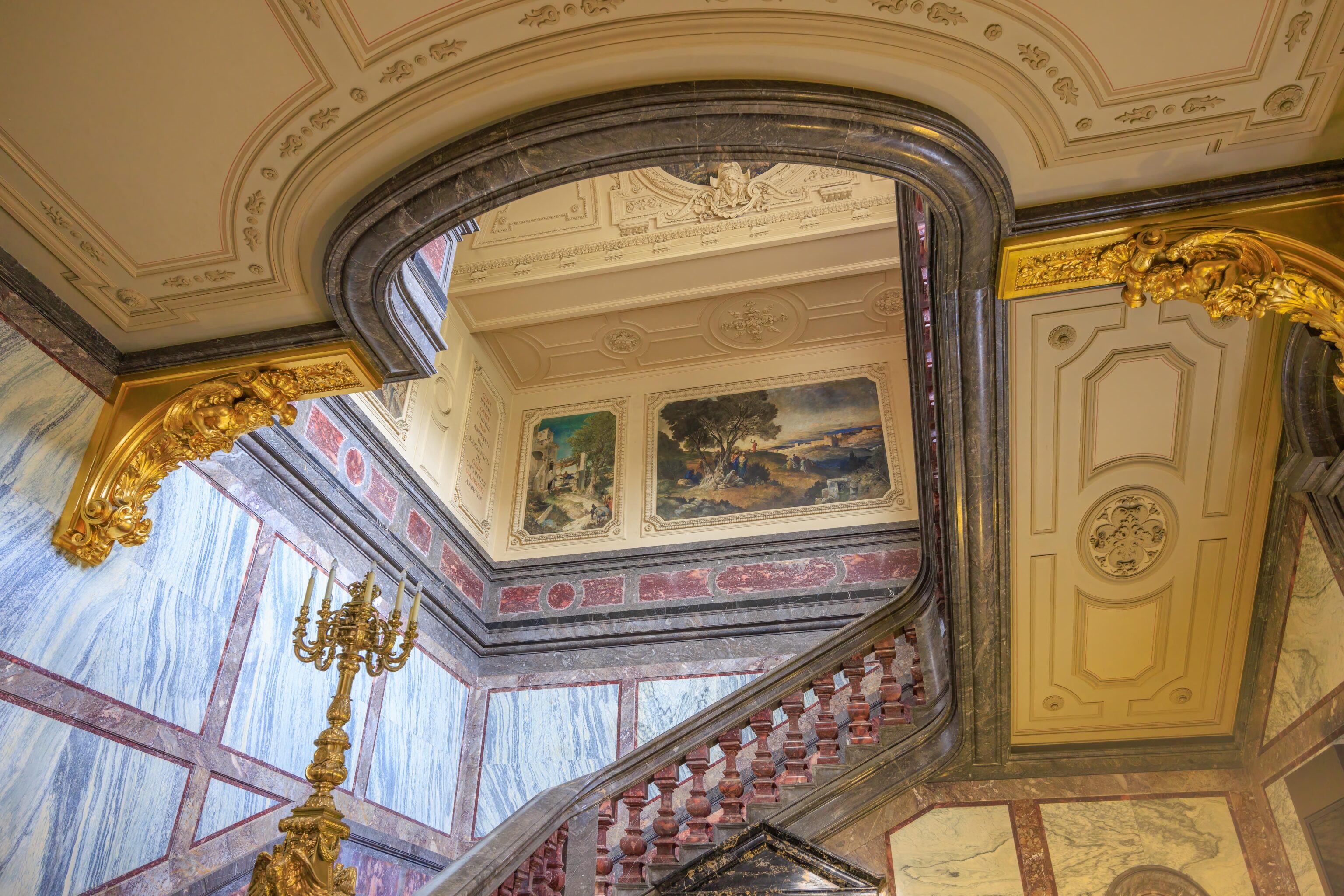
There is a small ticket counter on the right side of the building. The line moved extremely slowly due to there being only one employee.
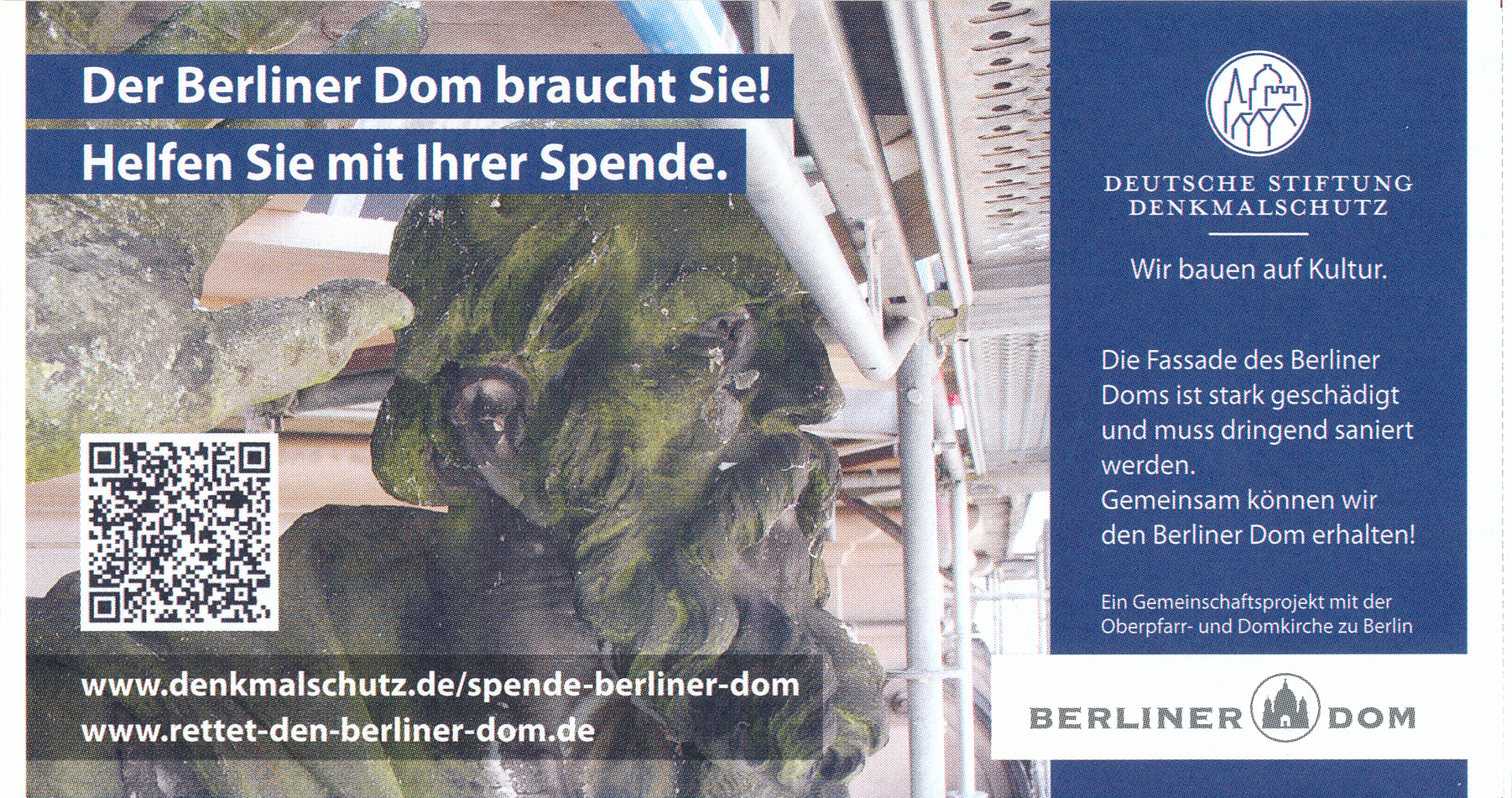
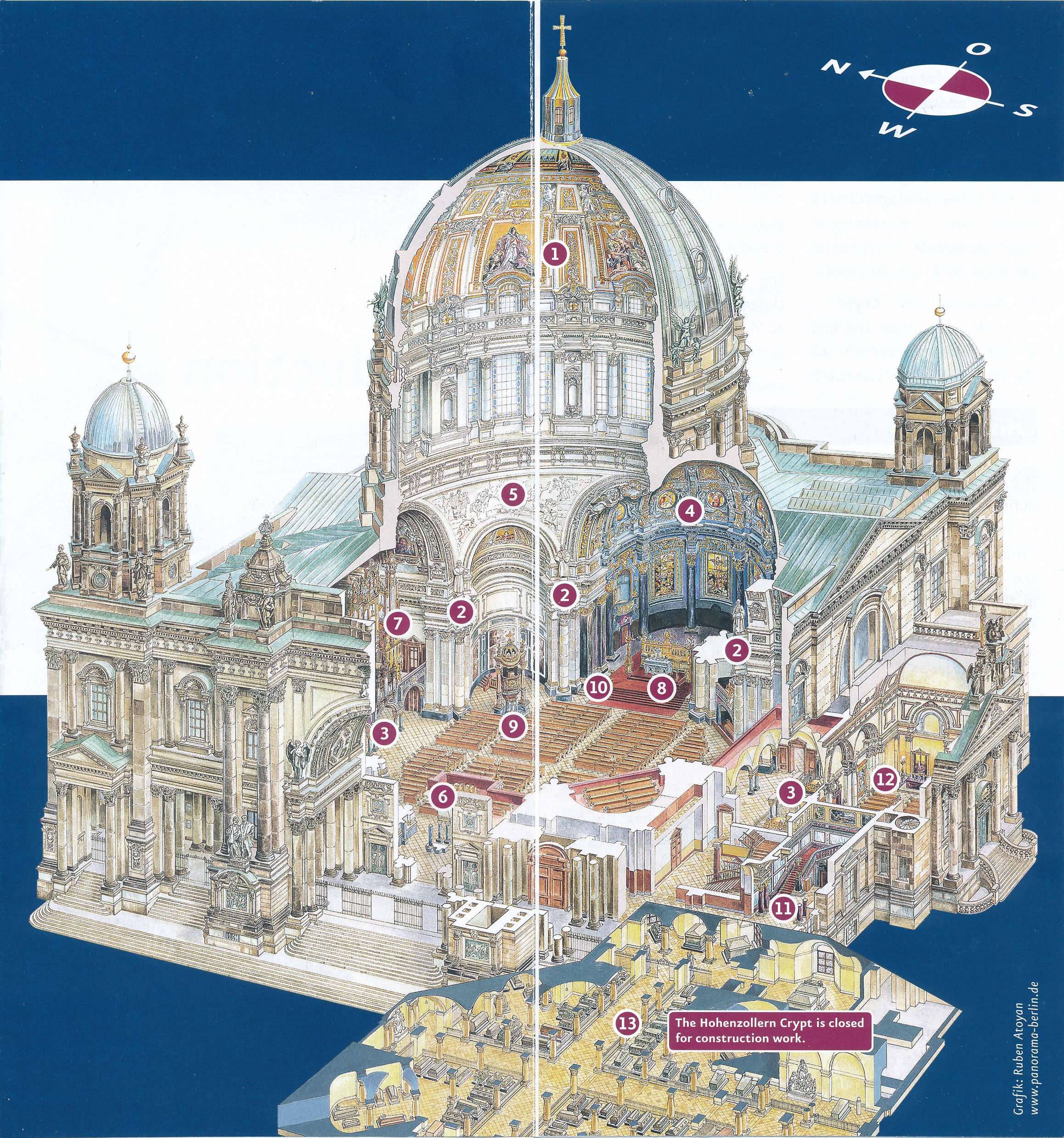
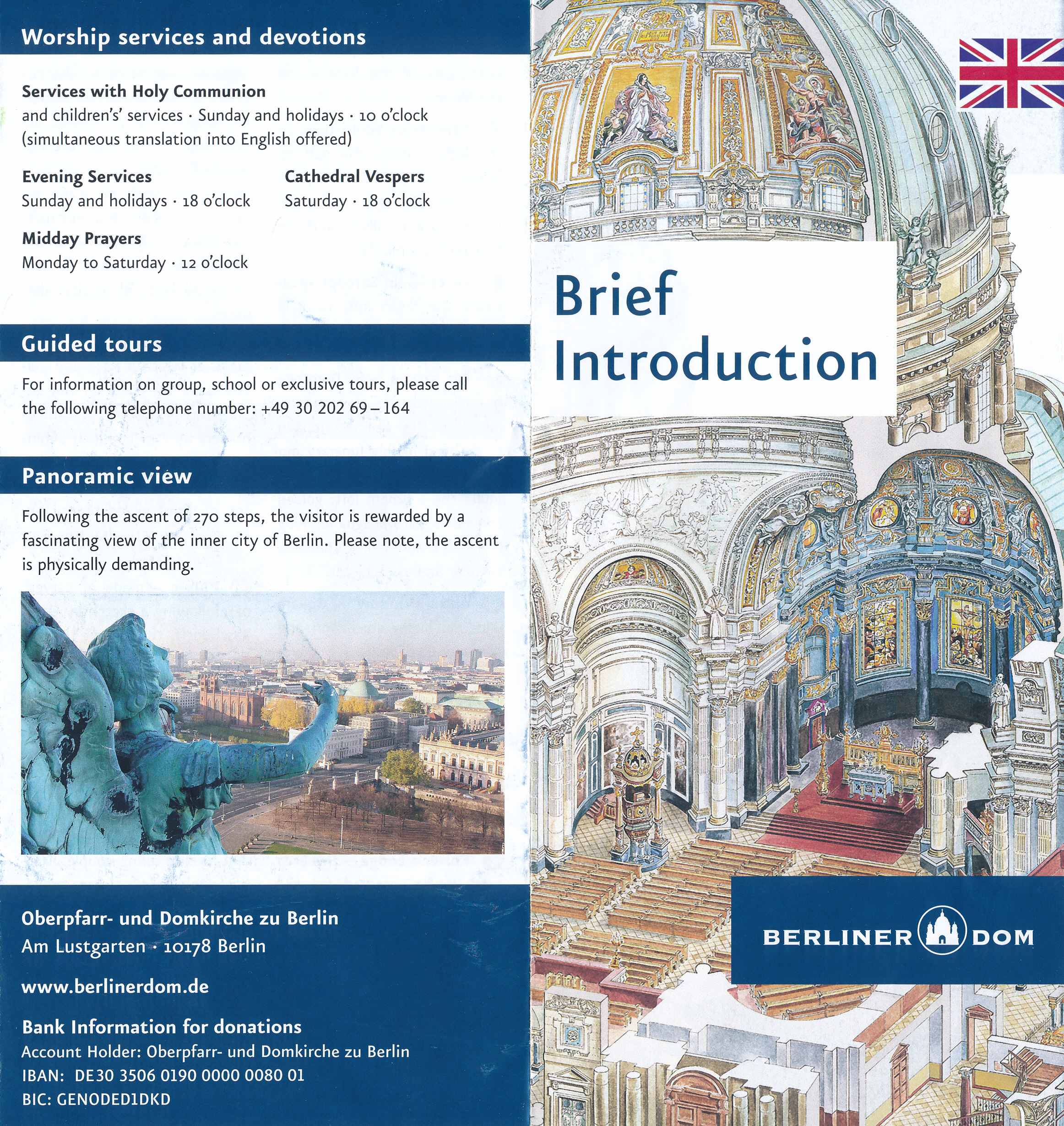
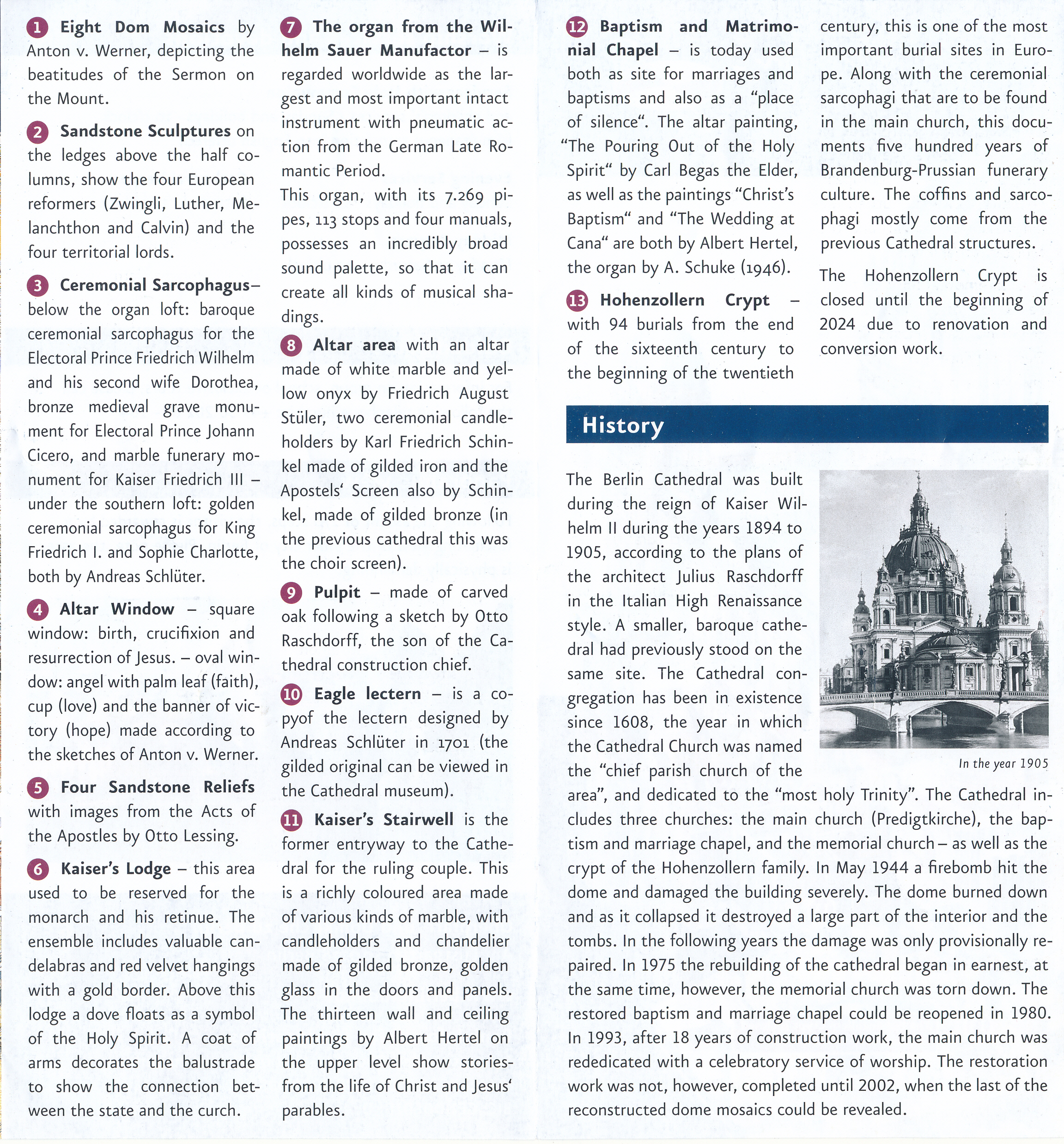
Soon though, we got our ticket and English brochure and were on our way!
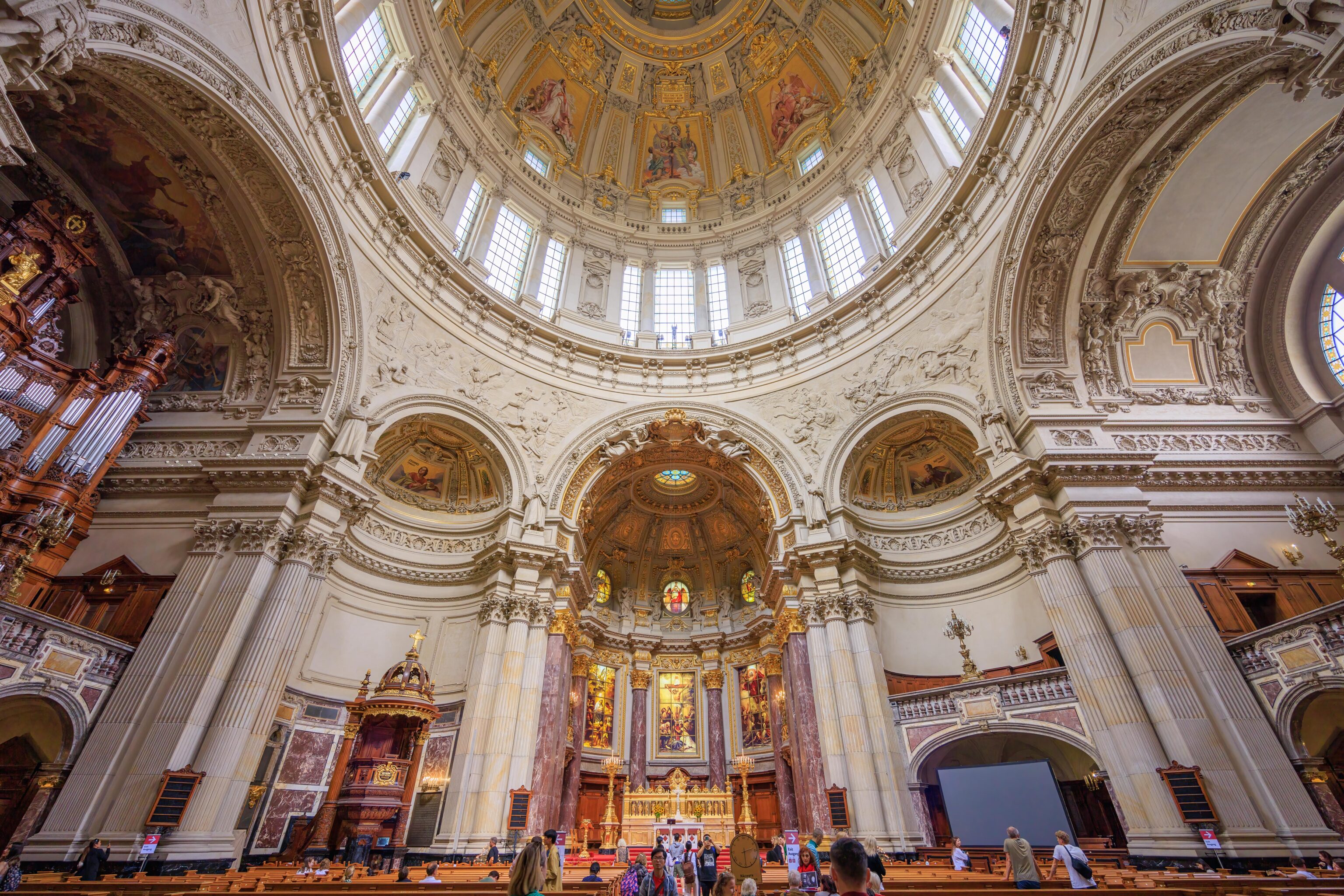
This church is very different from the others that we’ve been in. The building is, more or less, a square. The interior is one giant room a dome and no columns. It is very, very impressive. The interior is largely illuminated by sunlight coming in from the dome. Thus, the light levels change as clouds move past the sun.
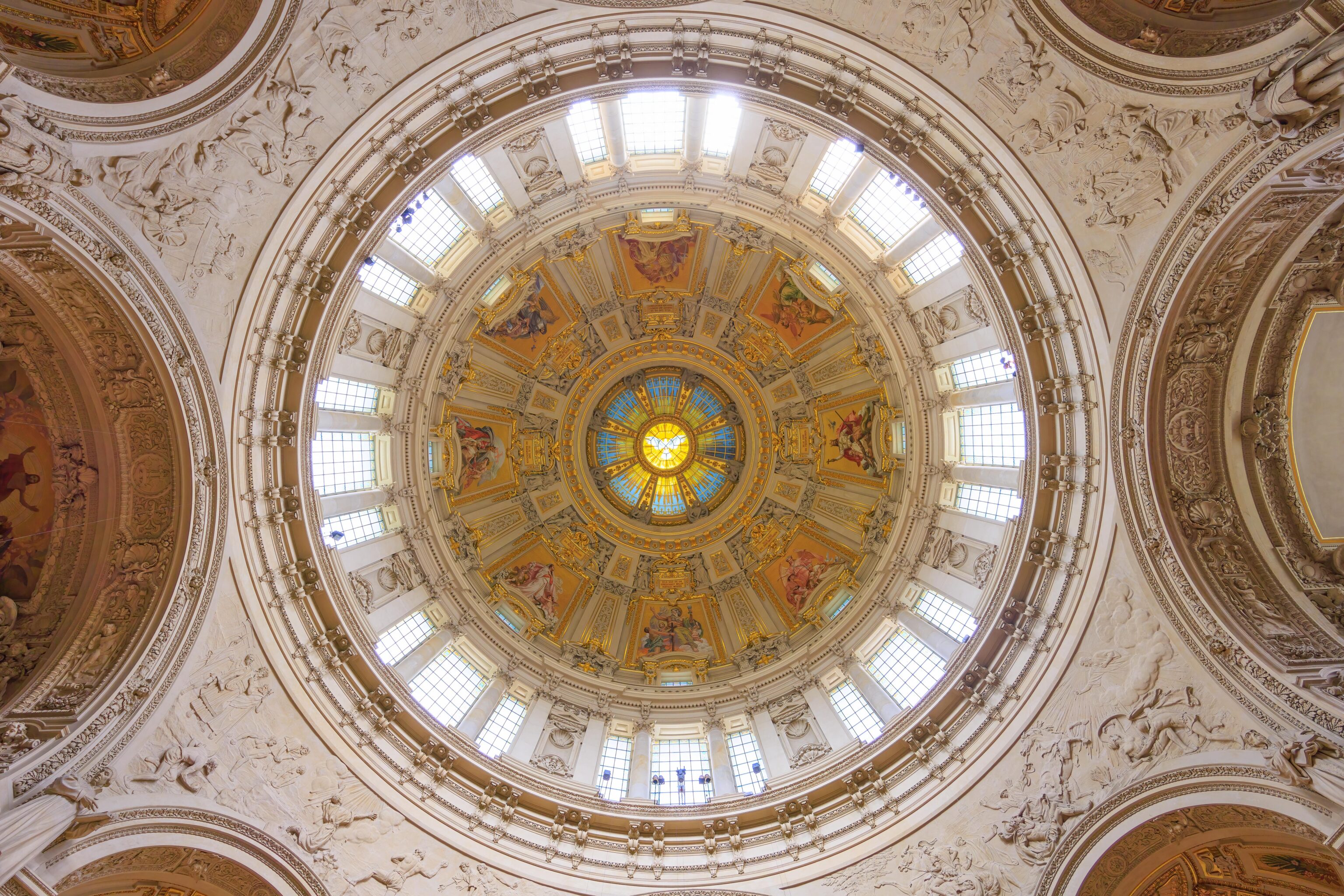
There is a dove at the center of the dome.
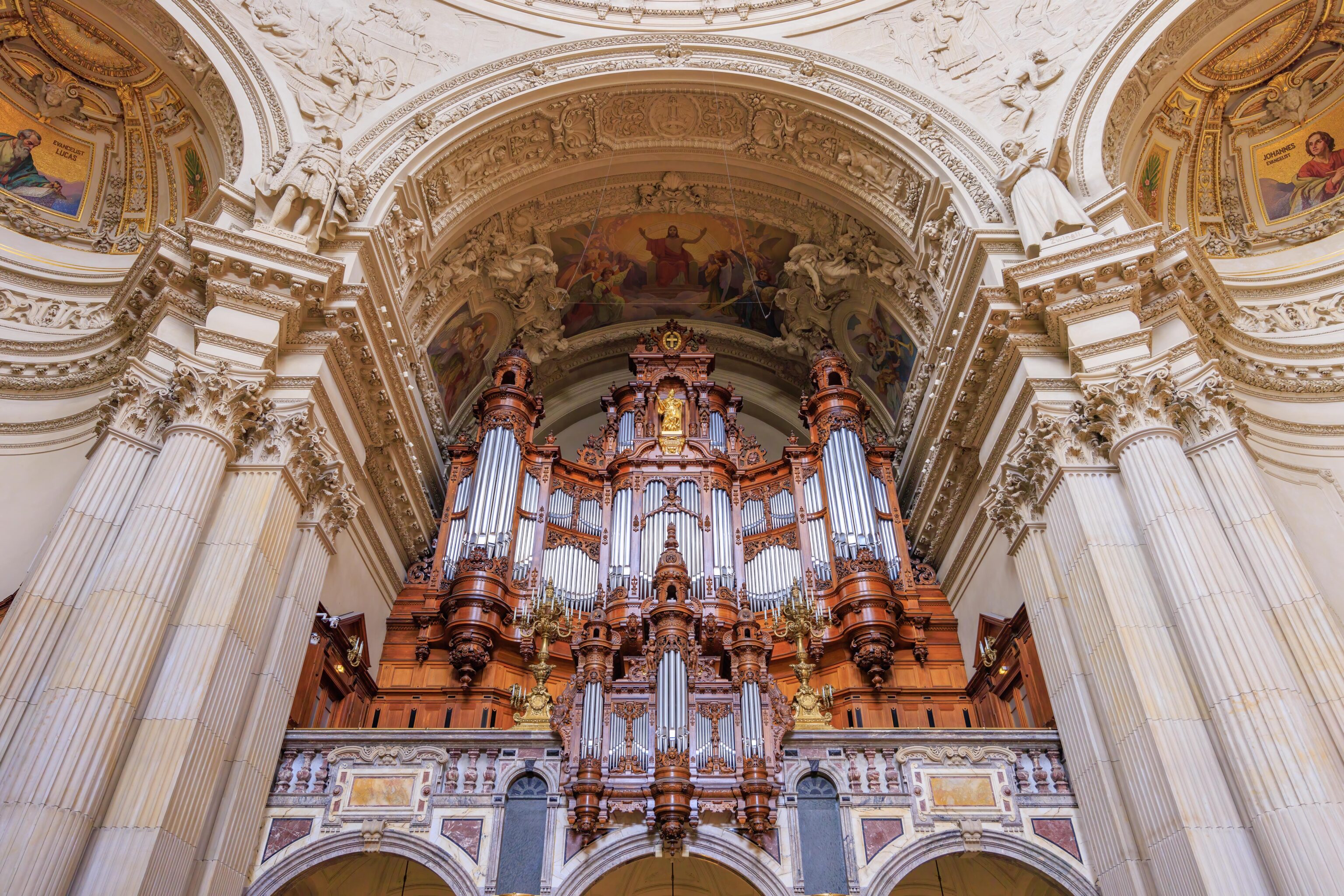
There is a huge organ.
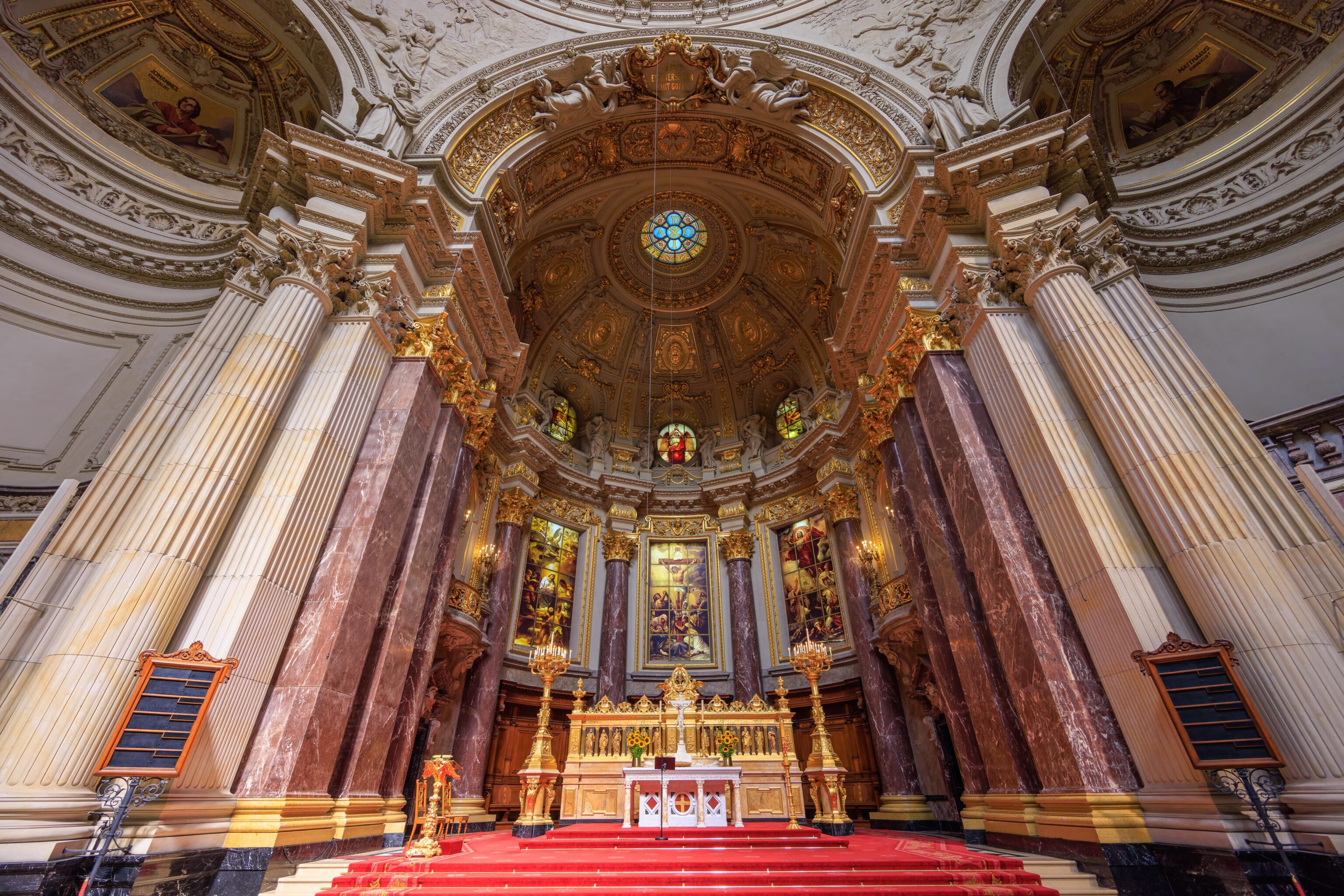
And of course, an altar.
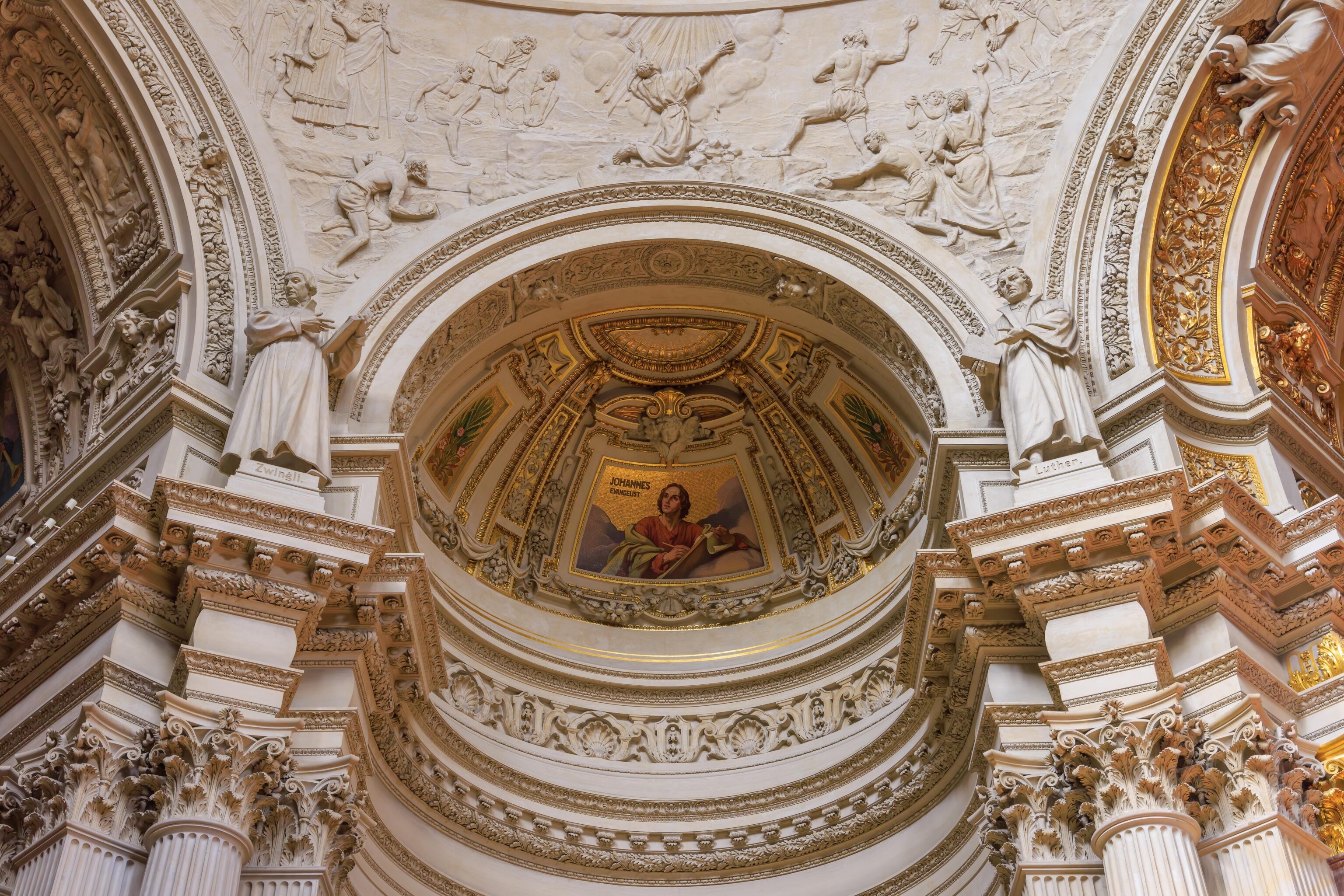
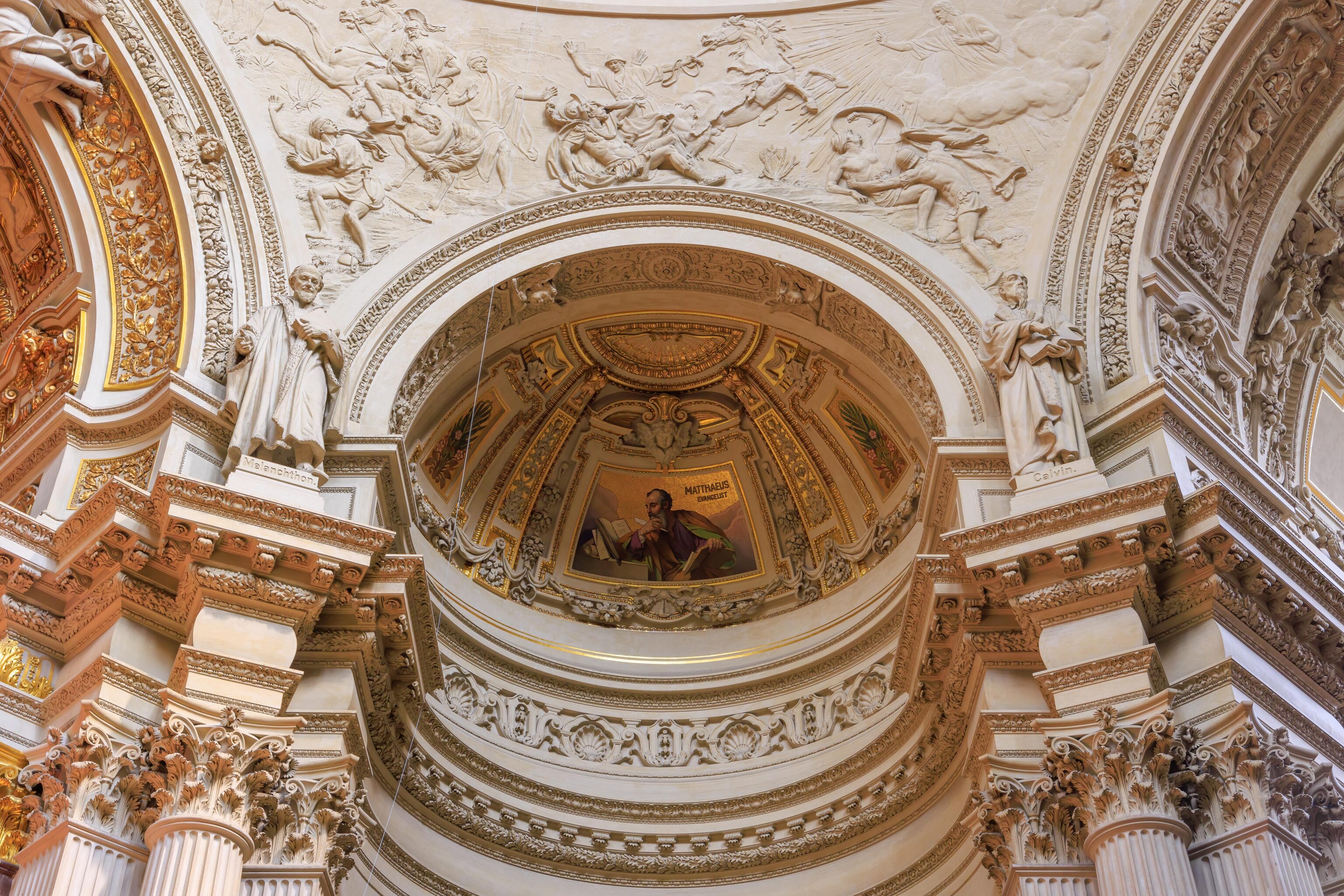
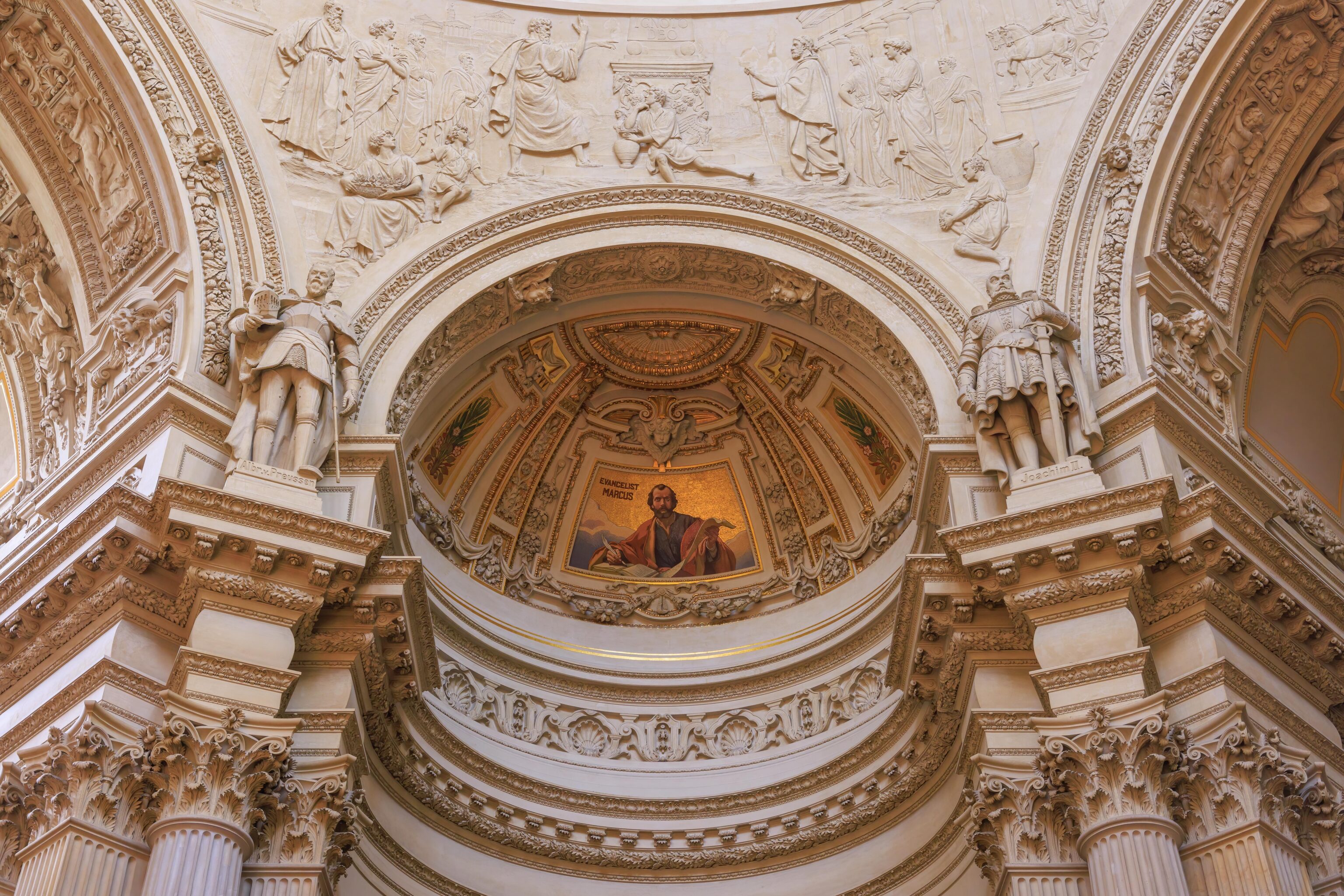
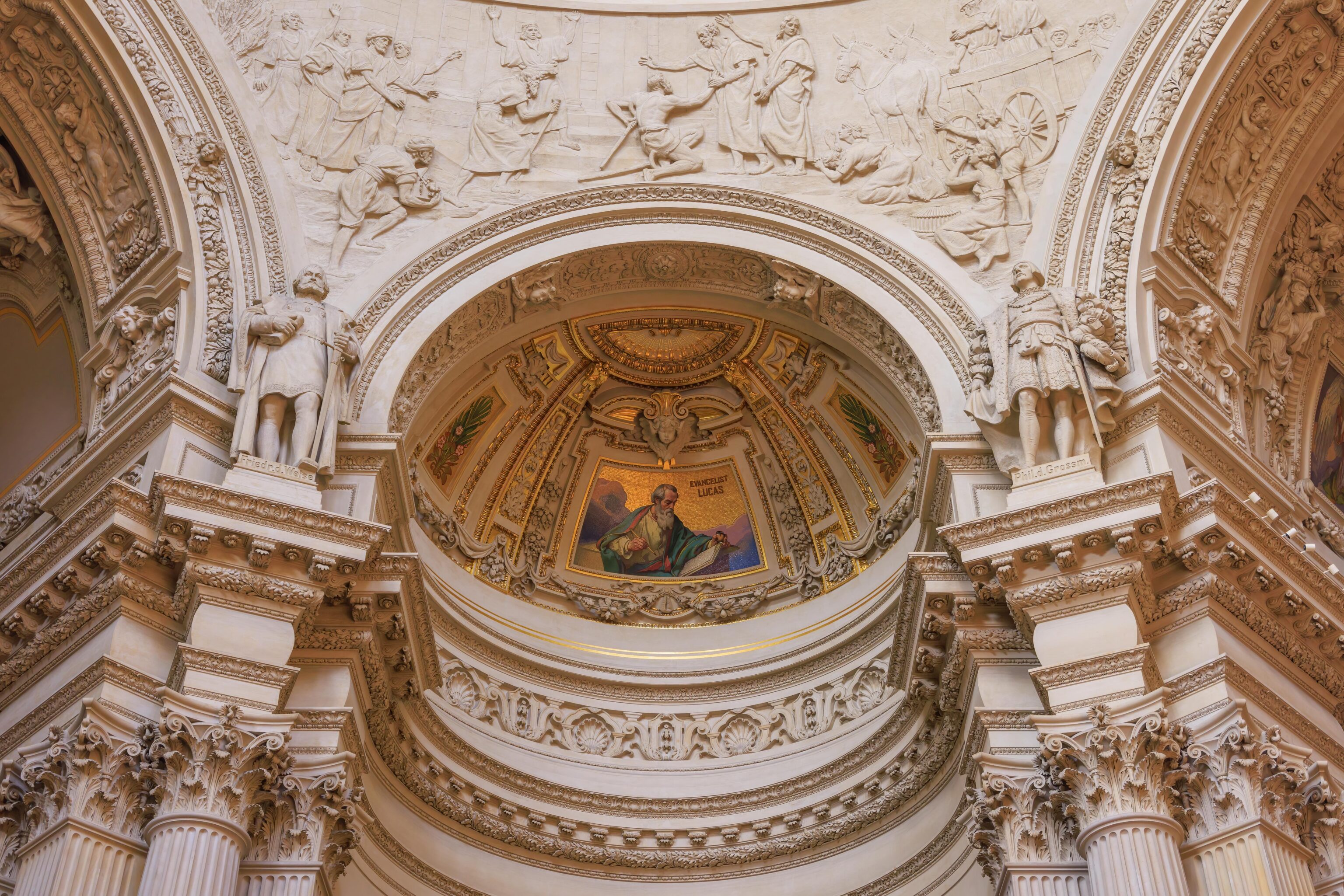
The four corners of the building hold depictions of the Four Evangelists.
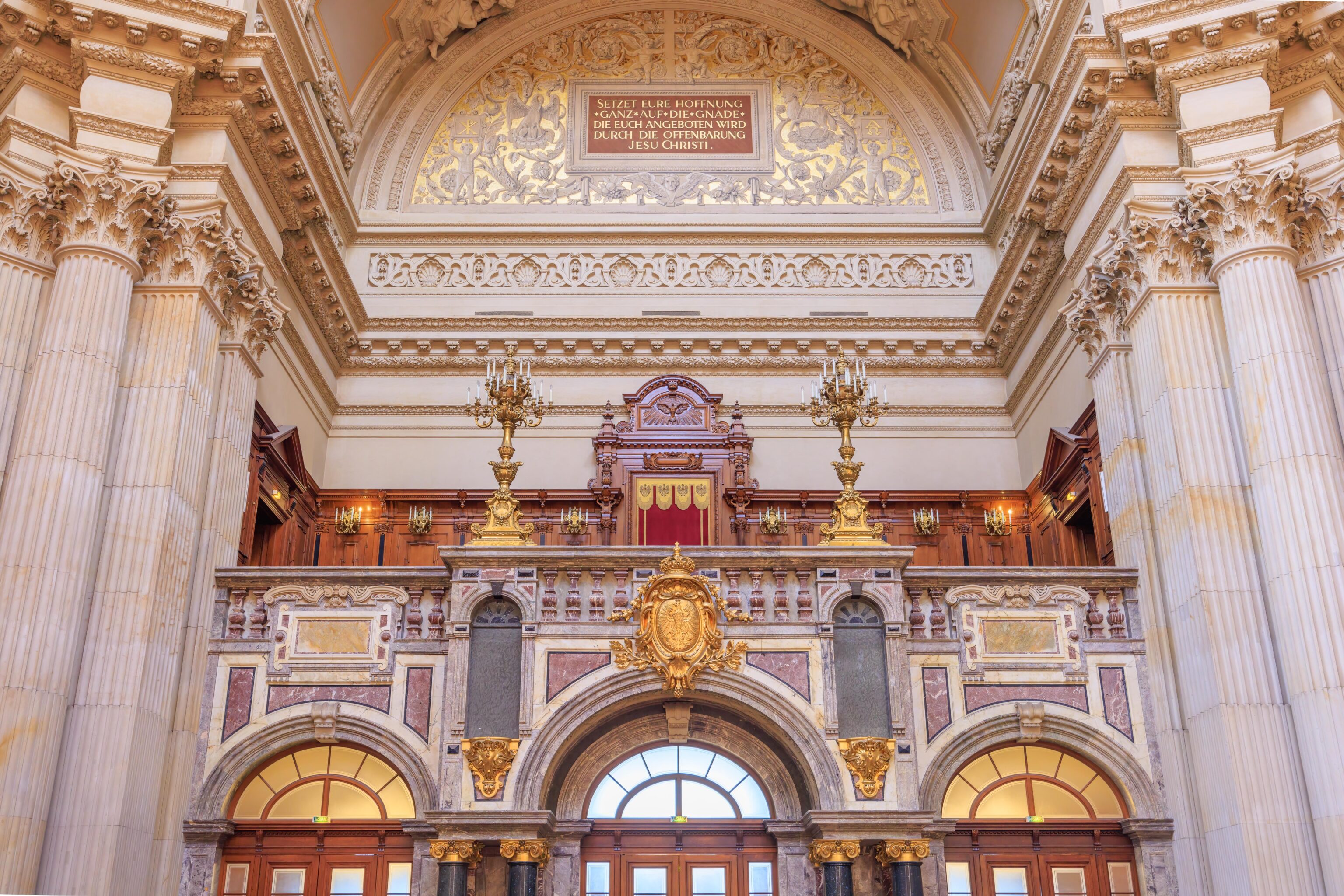
This is where the Kaiser (Emperor) would have sat during services. The Kaiser would have entered through the room which currently serves as the ticket office! The staircase in that room is referred to as the Imperial Staircase. We didn’t realize this at the time and figured that was just some random room they picked to stick the ticket desk in!
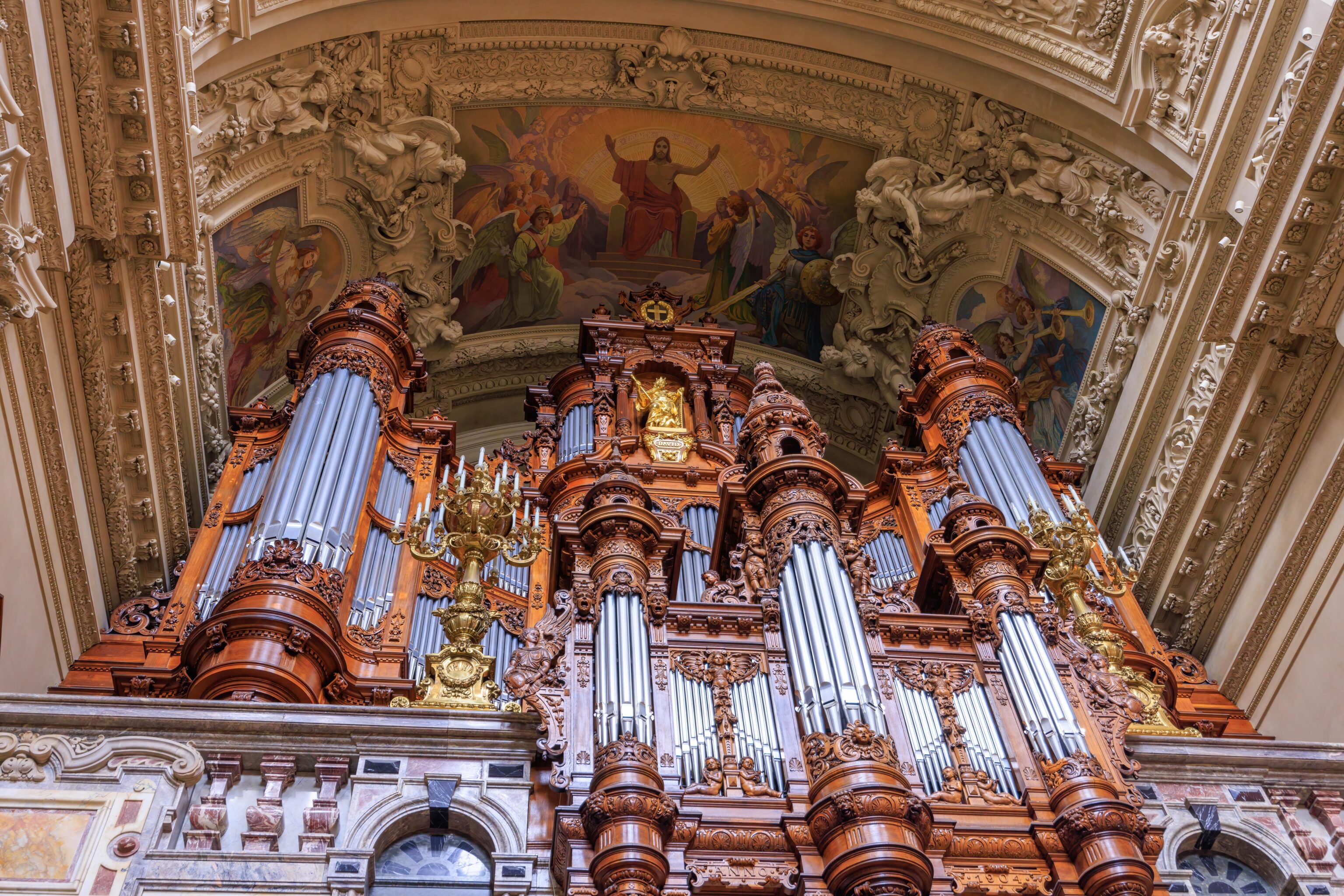
The organ once again, but from closer up where we can see above. The entire building is very ornate and richly decorated.
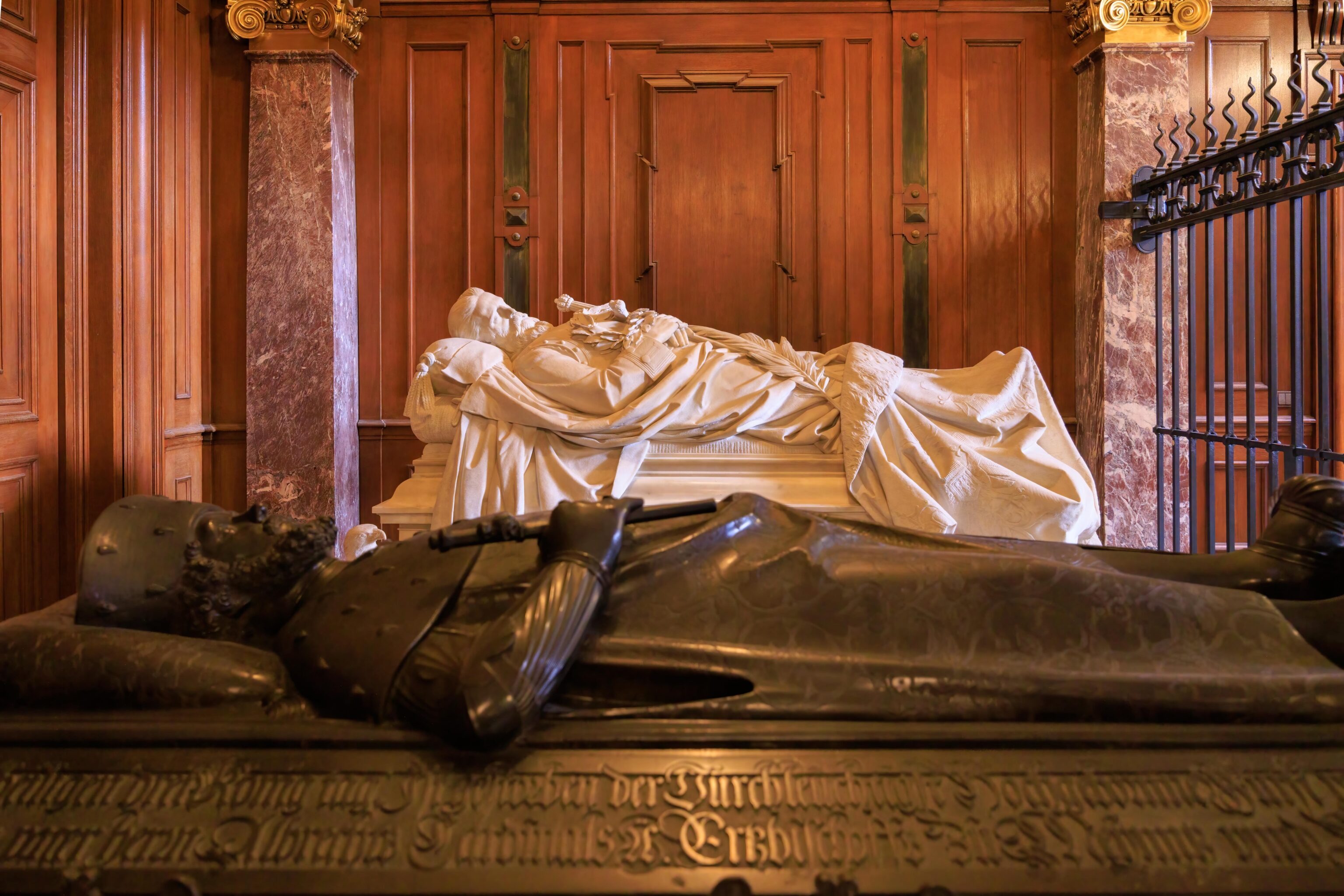
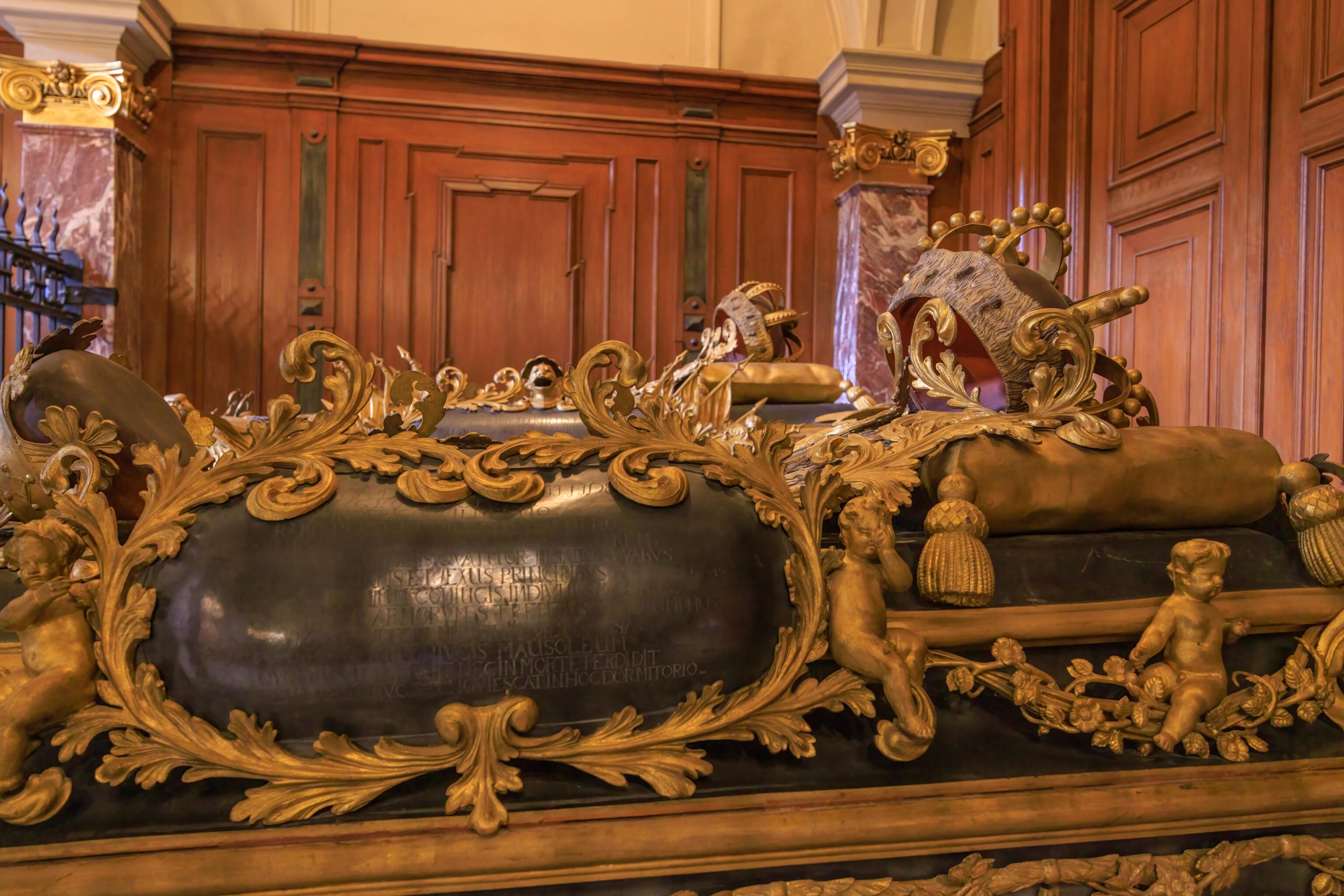
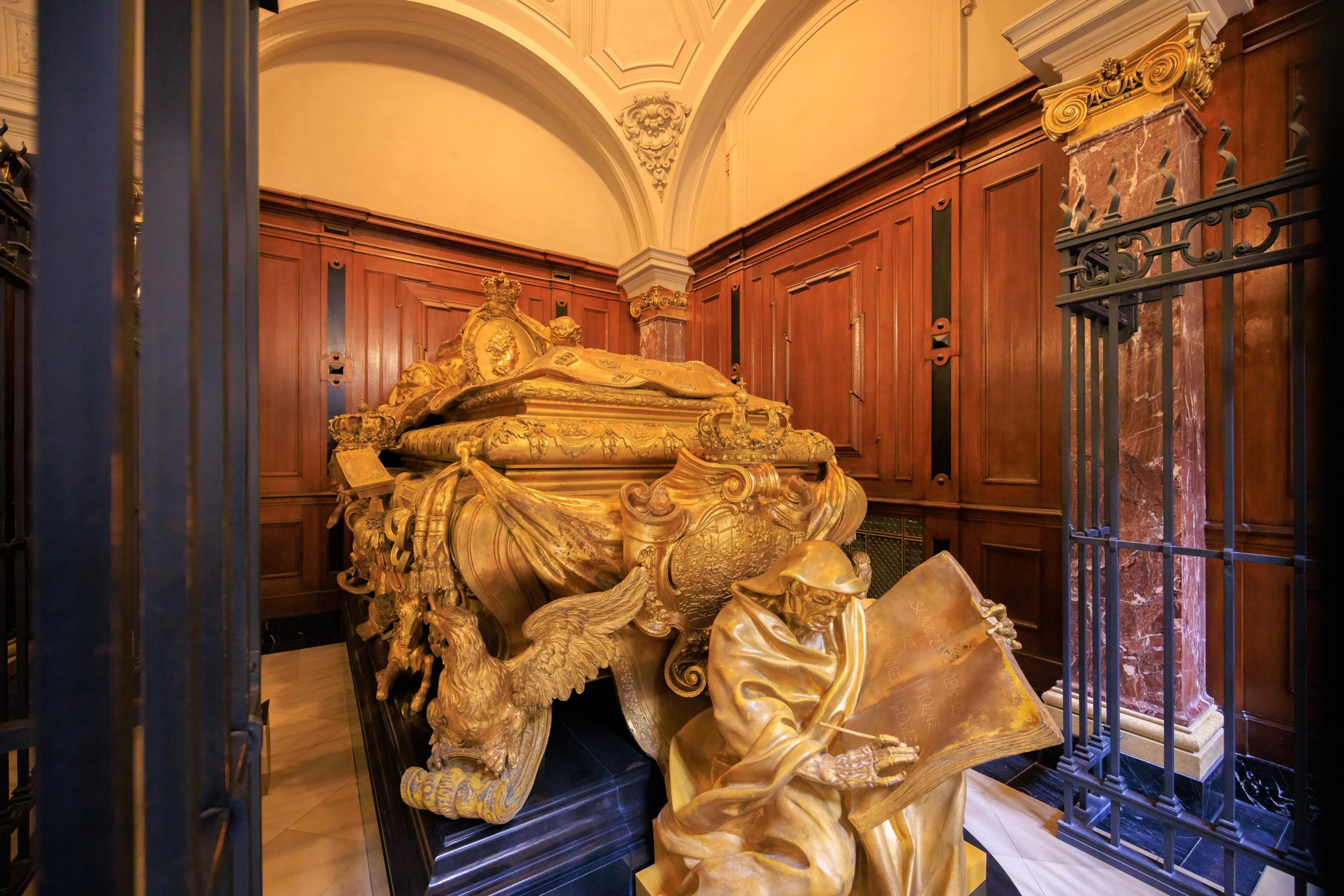
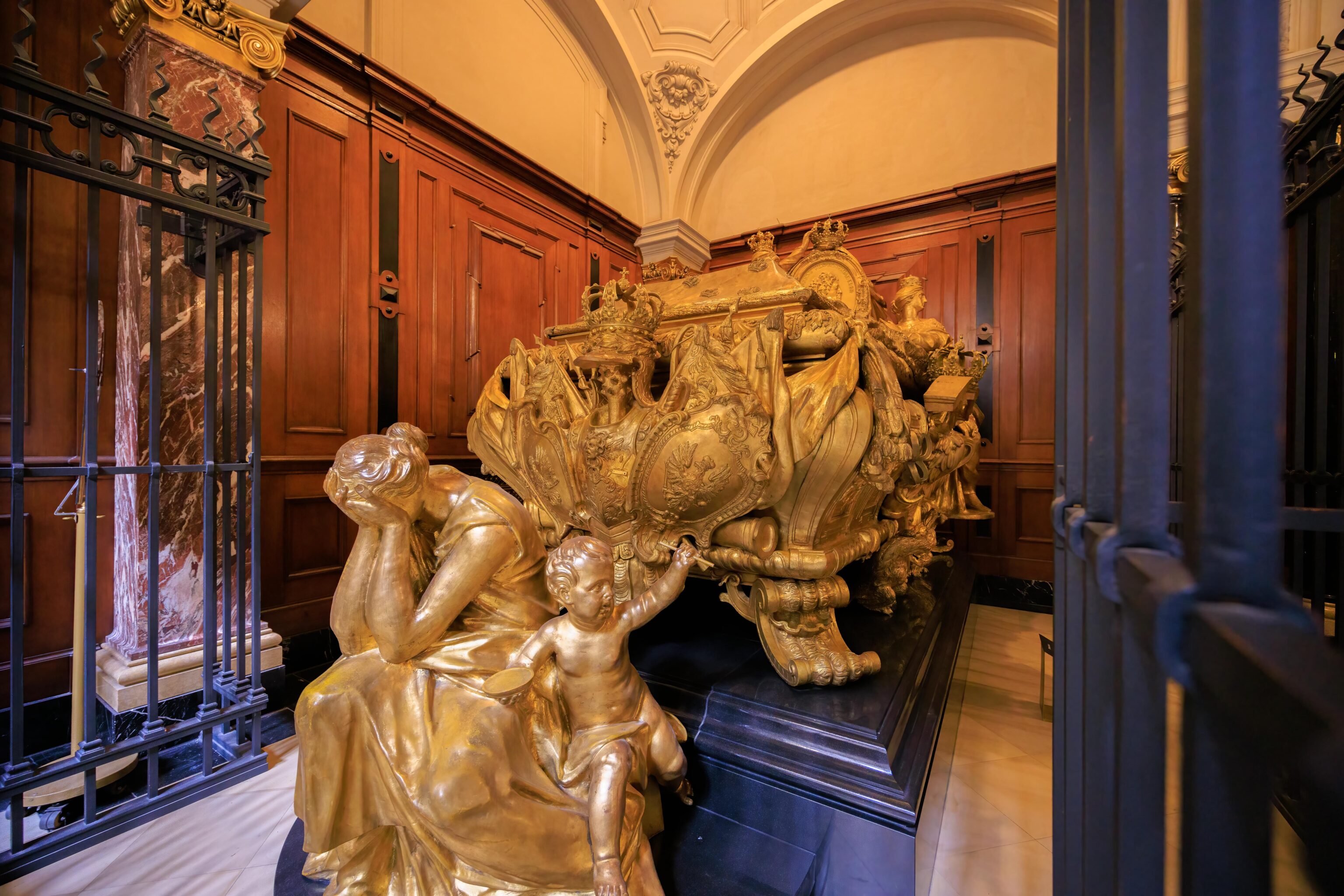
There are ceremonial sarcophagi on the main floor. One is for Frederick I, the first King of Prussia. There is another for Kaiser Friedrich III. There is also a crypt below with 94 burials, however, it is closed for renovations until 2024.
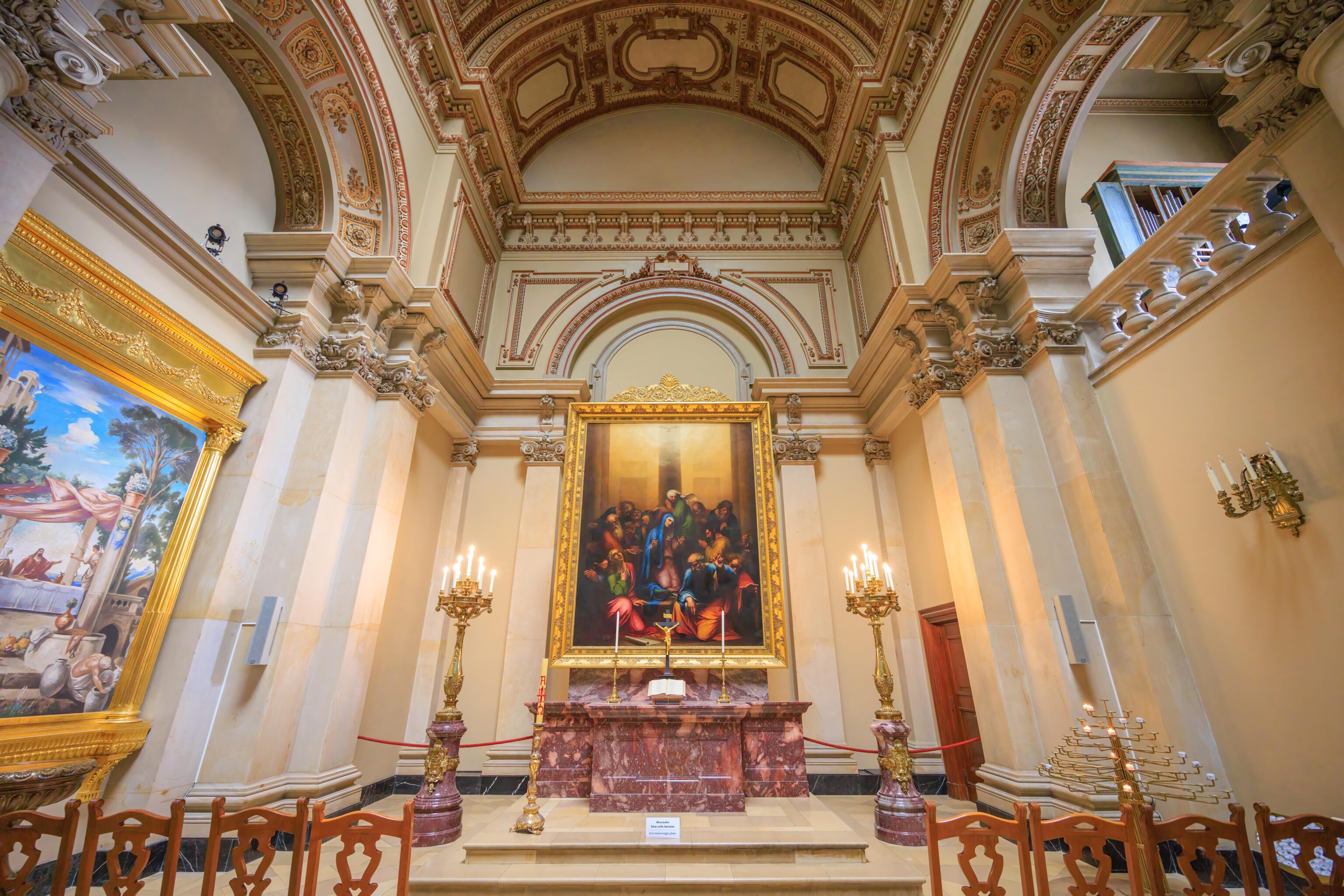
We passed by this chapel on our way out. The exit is downstairs, though does not pass through the crypt. There is an option to visit the dome, however, we did not.
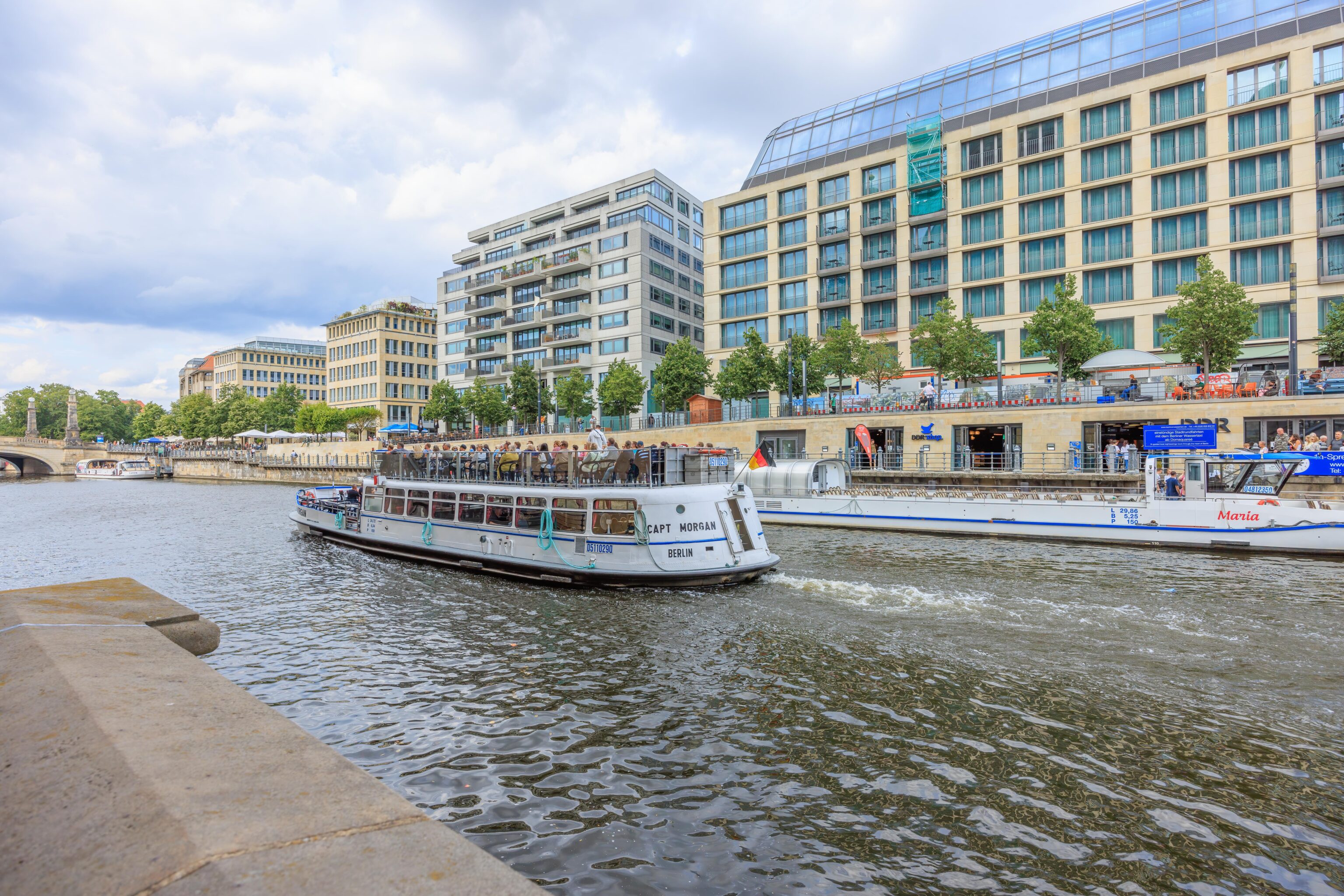
The exit is almost at river level, below street grade.
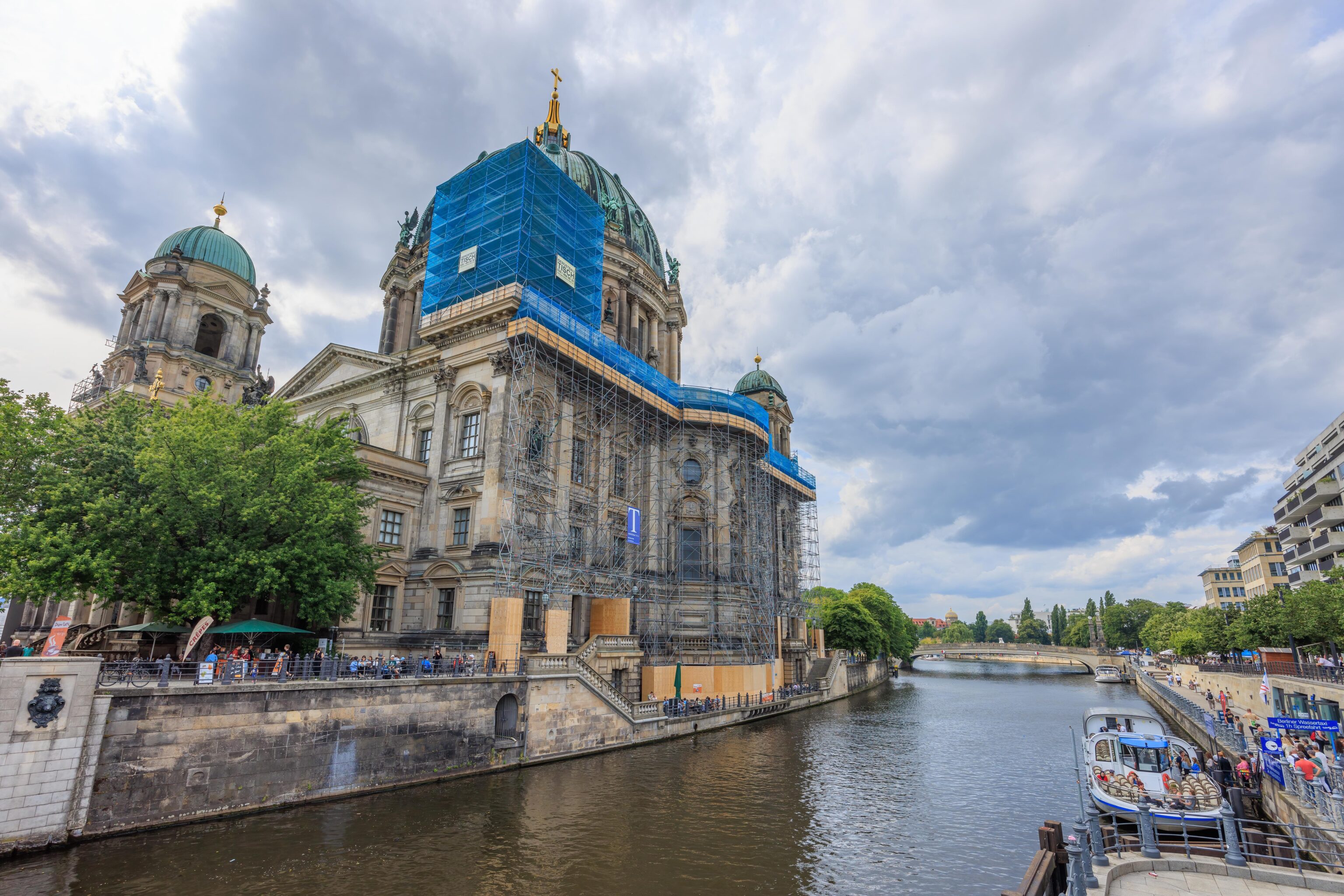
We crossed the Spree, leaving Museum Island, to take a look at the Berliner Dom from behind. It was covered in scaffolding due to renovations that were taking place.
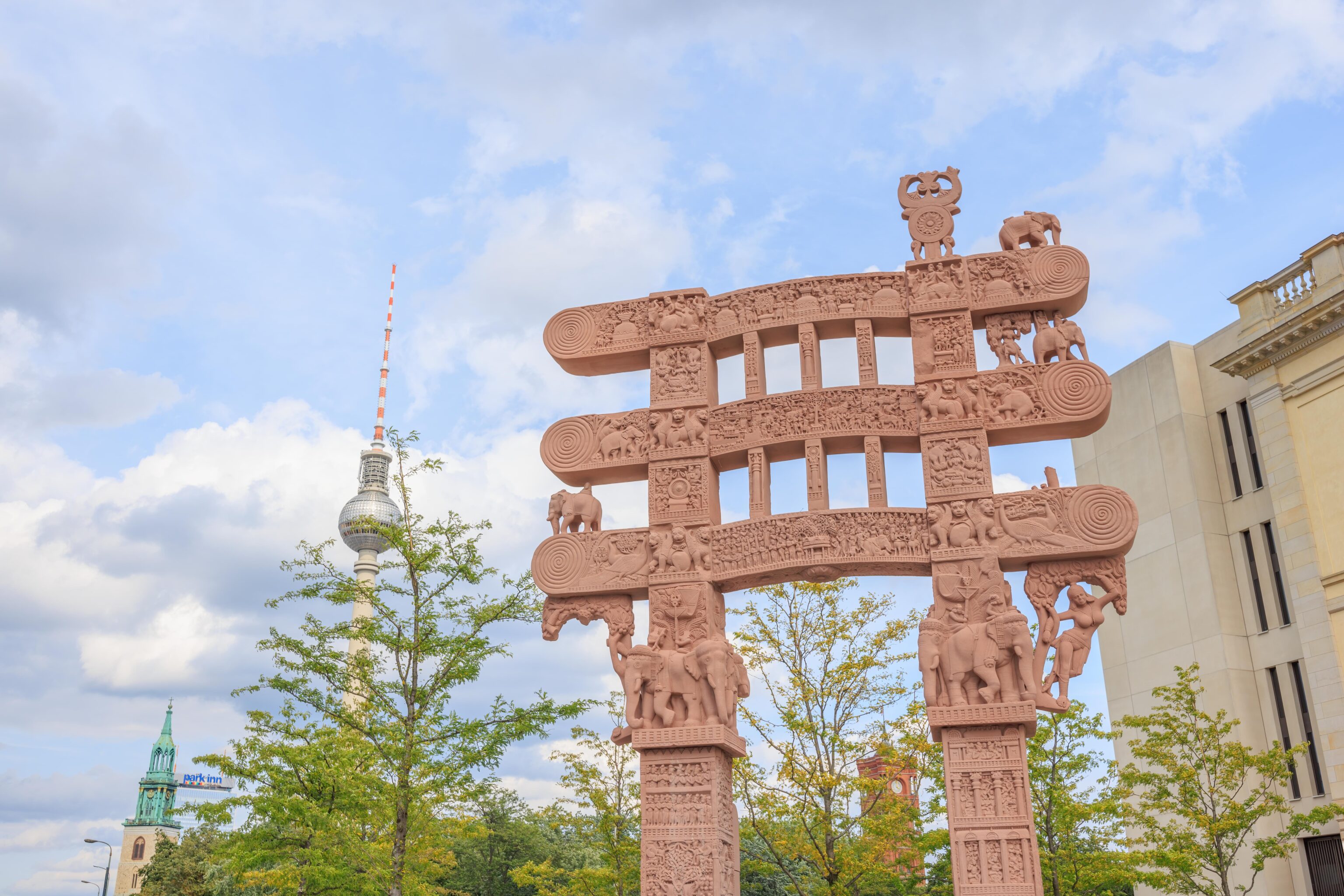
We returned to Museum Island and crossed the street to get a closer look at this. We couldn’t tell what it was and didn’t find any explanatory sign.
It is a replica of the Sanchi Gate and sits in front of the Humboldt Forum. It is new and was completed in December, 2022. The Humboldt Forum is the former Berlin Palace, also Stadtschloss (City Palace), which we mentioned briefly when writing about crossing the Schlossbrücke.
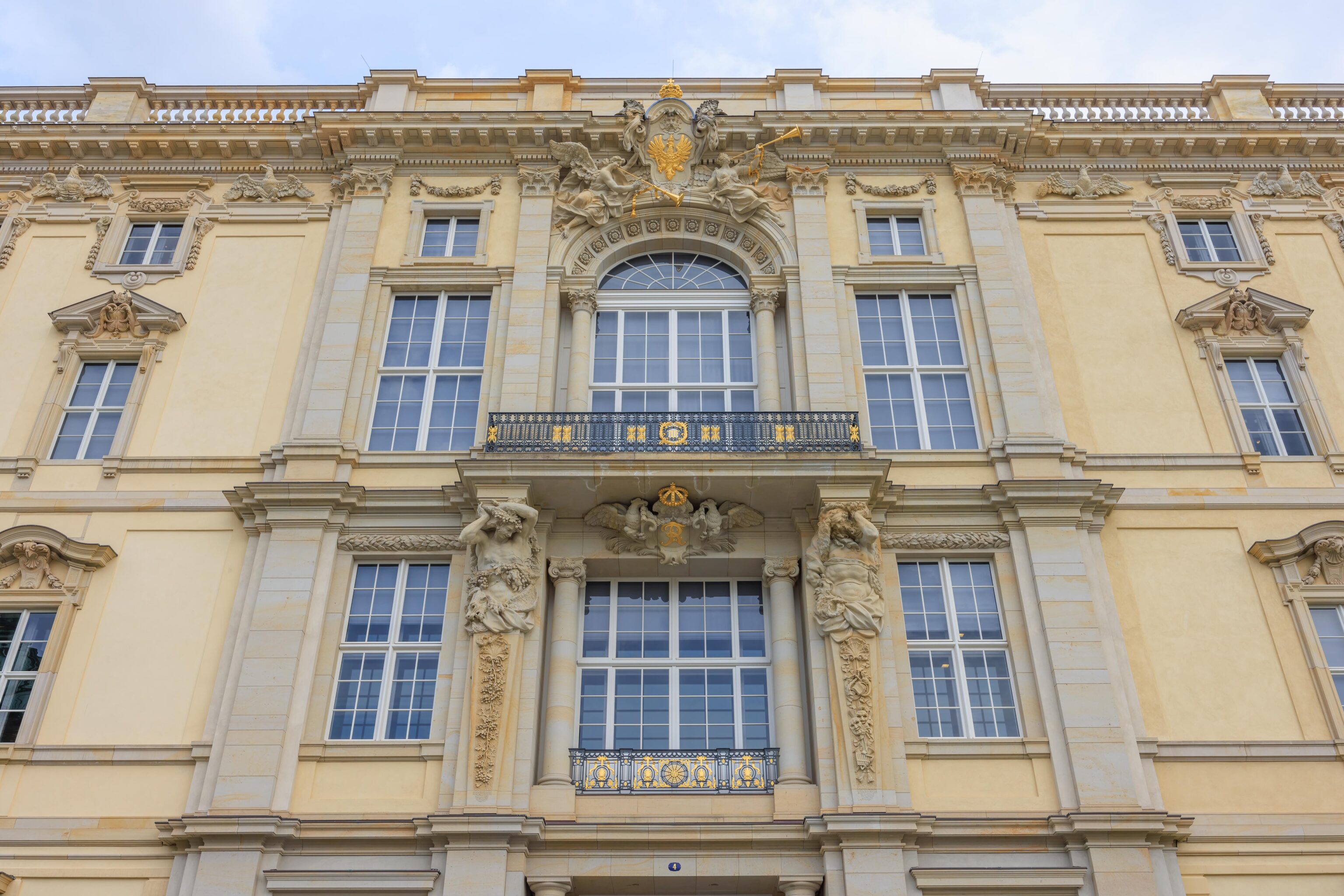
Just a random section of the Stadtschloss, showing some of the exterior decor.
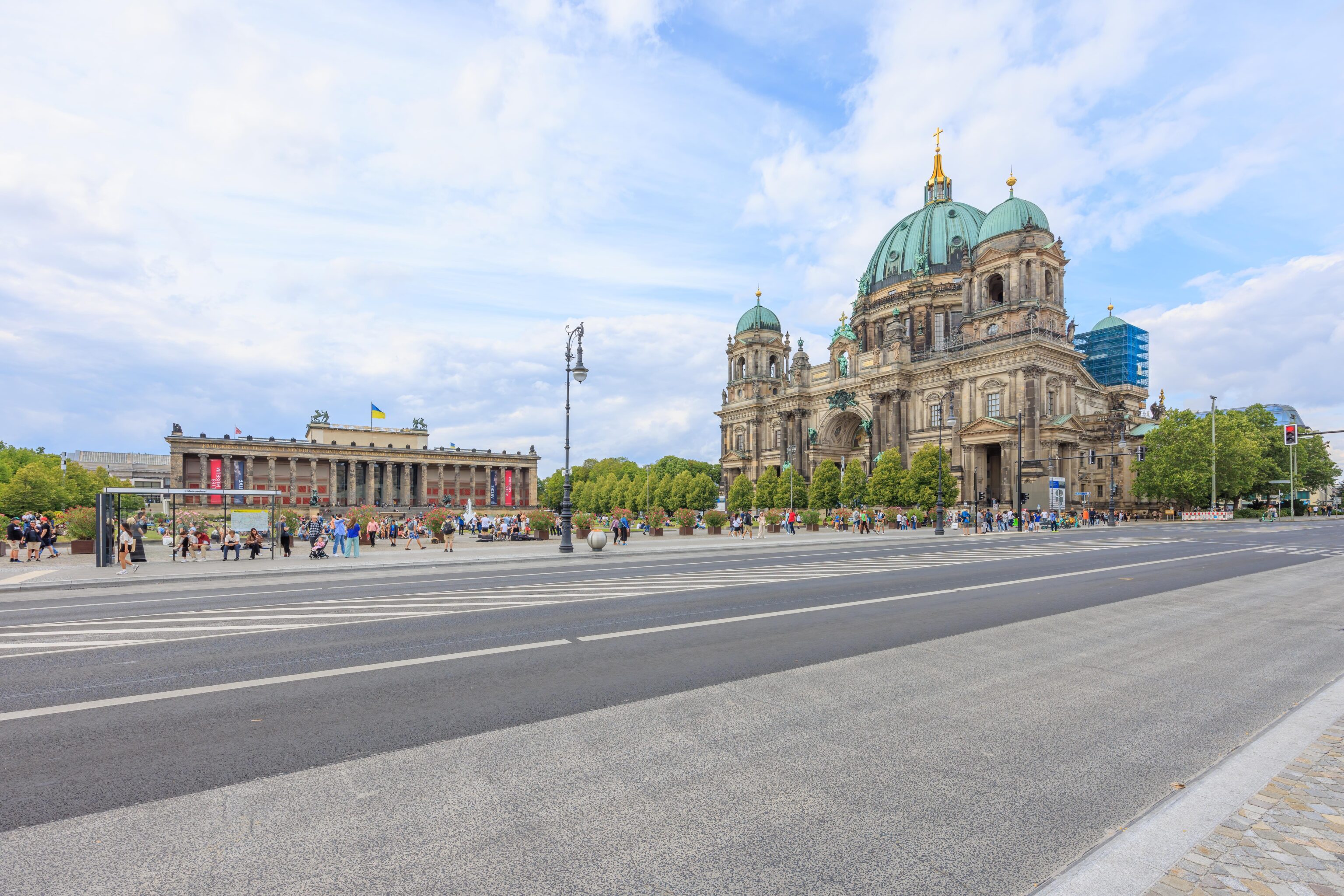
We headed west to the Museumsinsel (Museum Island) U-Bahn station. One entrance is right by the Schlossbrücke. This view is from around that entrance. Unfortunately, we didn’t photograph the Lustgarten from up close. It was quite a busy park with many people relaxing on the grass, street performers here and there, and many scammers tricking tourists with the shell game.
Christopher Street Day
We took the U-Bahn two stations to the west, bypassing Unter den Linden and exiting at Brandenburger Tor. Here, we encountered the Christopher Street Day pride celebration. We already wrote about it so will now skip ahead in time!
Around Potsdamer Platz
After checking out Christopher Street Day, we headed south to see the Memorial to the Murdered Jews of Europe.
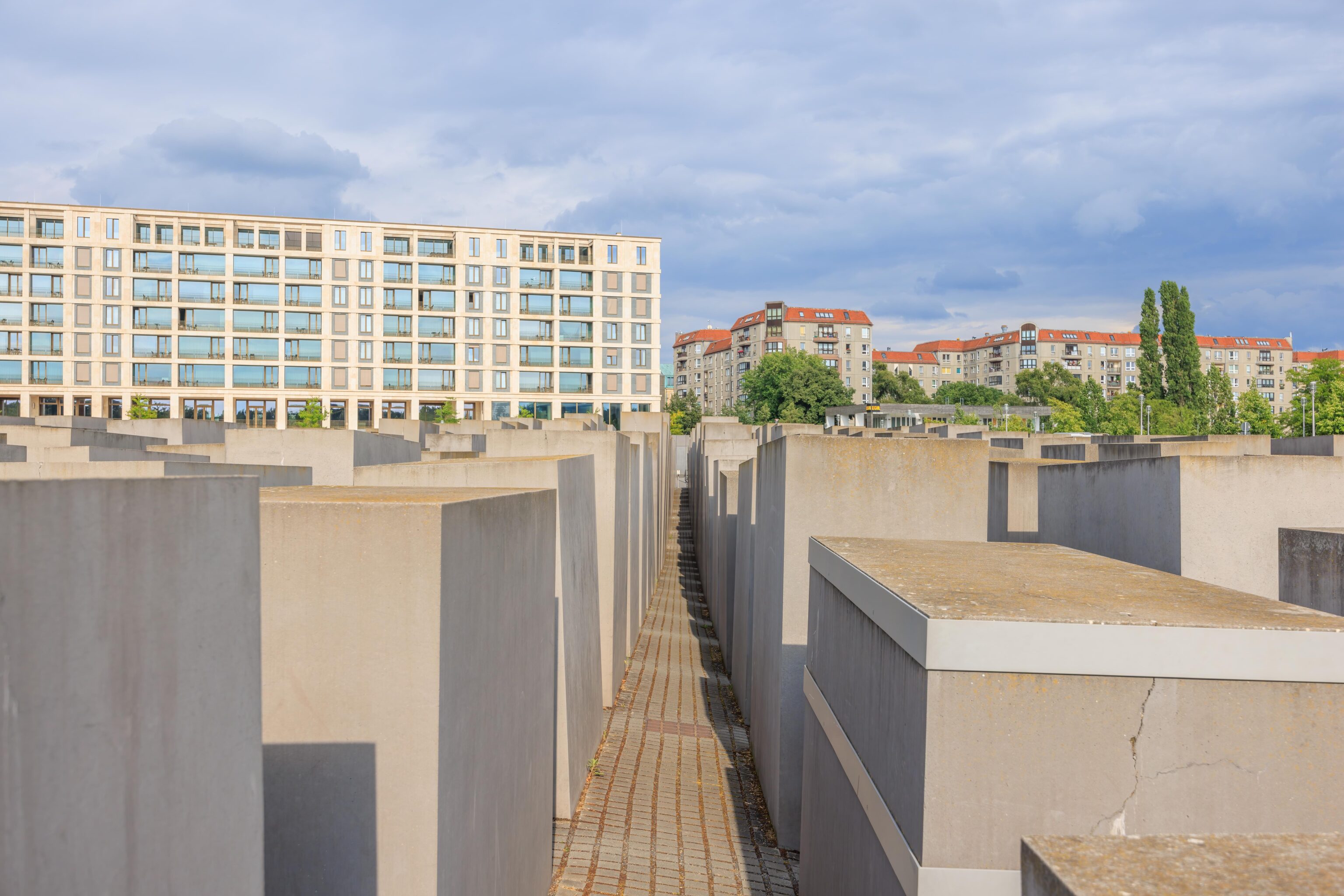
The memorial is essentially a grid of concrete blocks. The ground is sloped and dips down in the center.
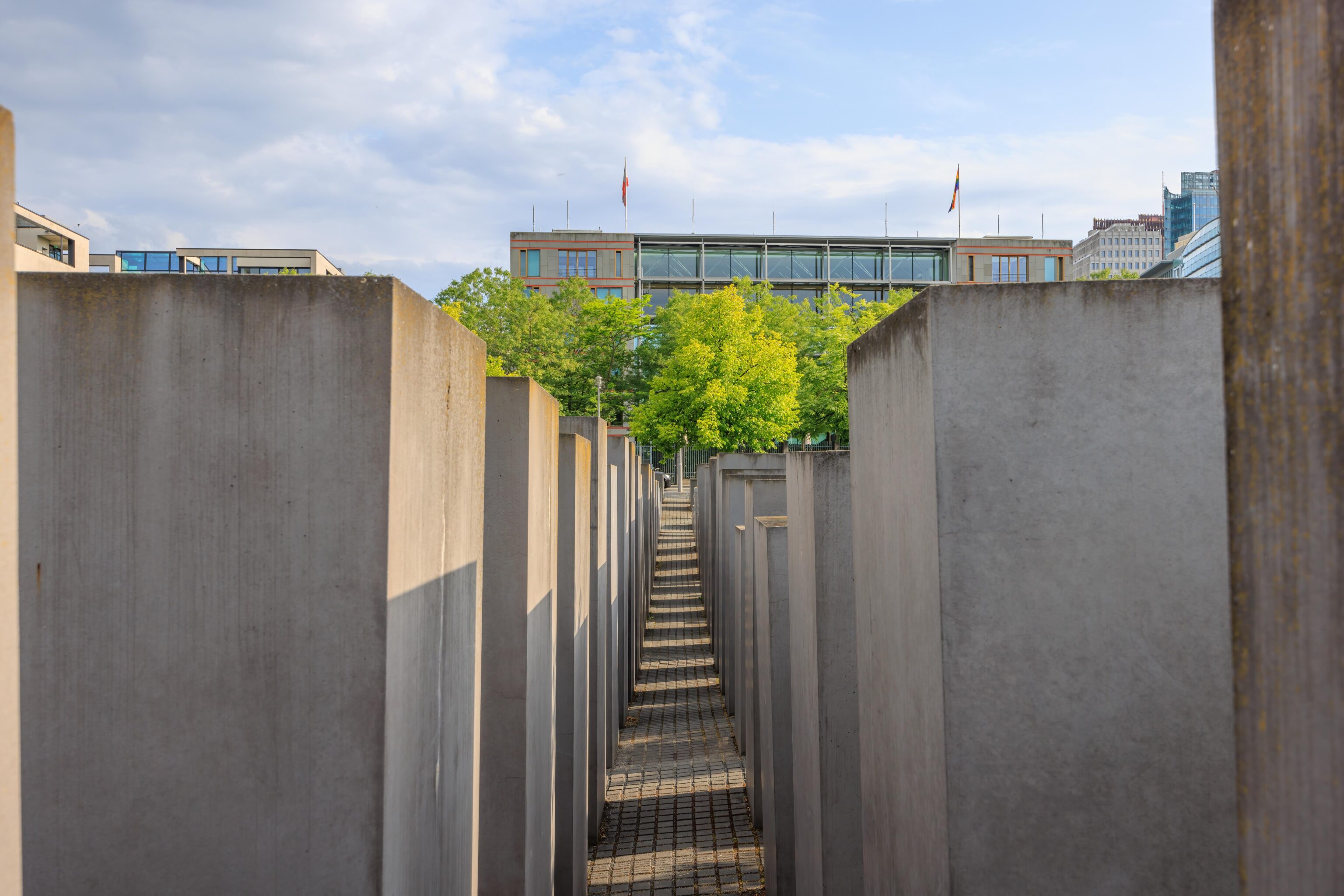
The blocks are all lined up perfectly but don’t all stand perfectly upright.
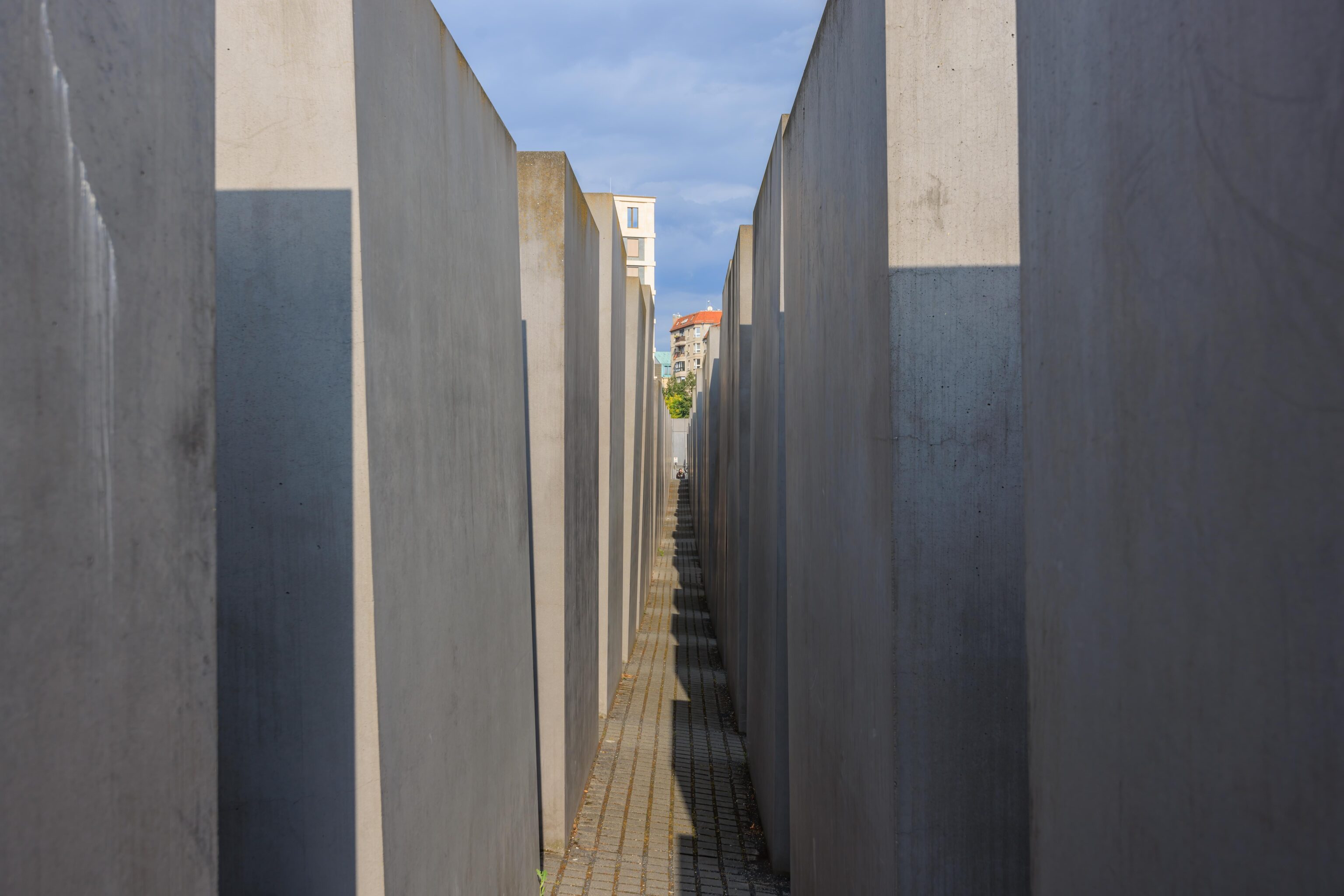
Once near the lowest point, one can only really see directly ahead, and to the side at junctions. The architect who designed the memorial, Peter Eisenman, provides a lengthy explanation about the memorial on its website.
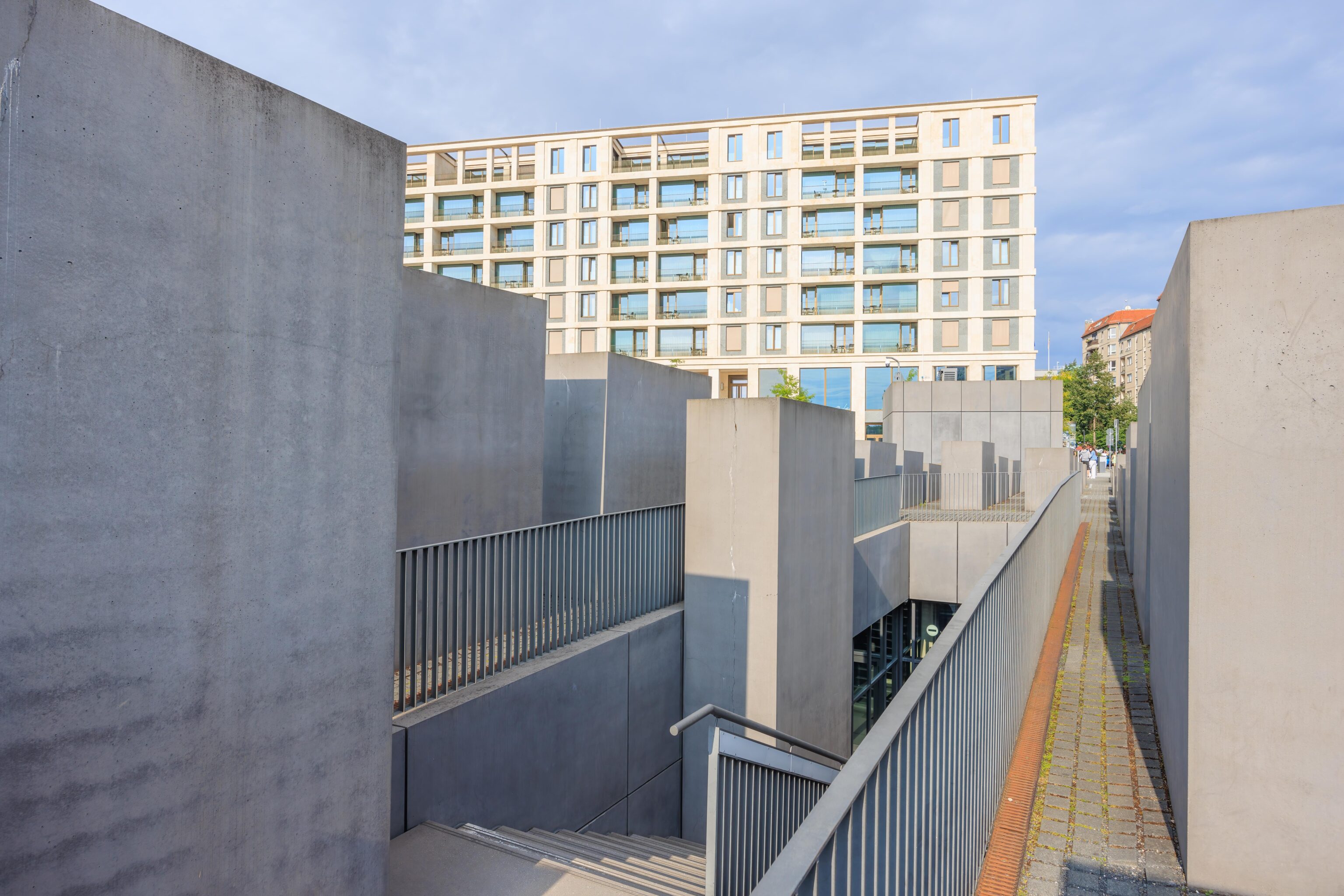
There is an underground exhibition space below the memorial. This is the exit. We didn’t visit due to the time. After exiting the memorial around the southeast corner, we walked south.
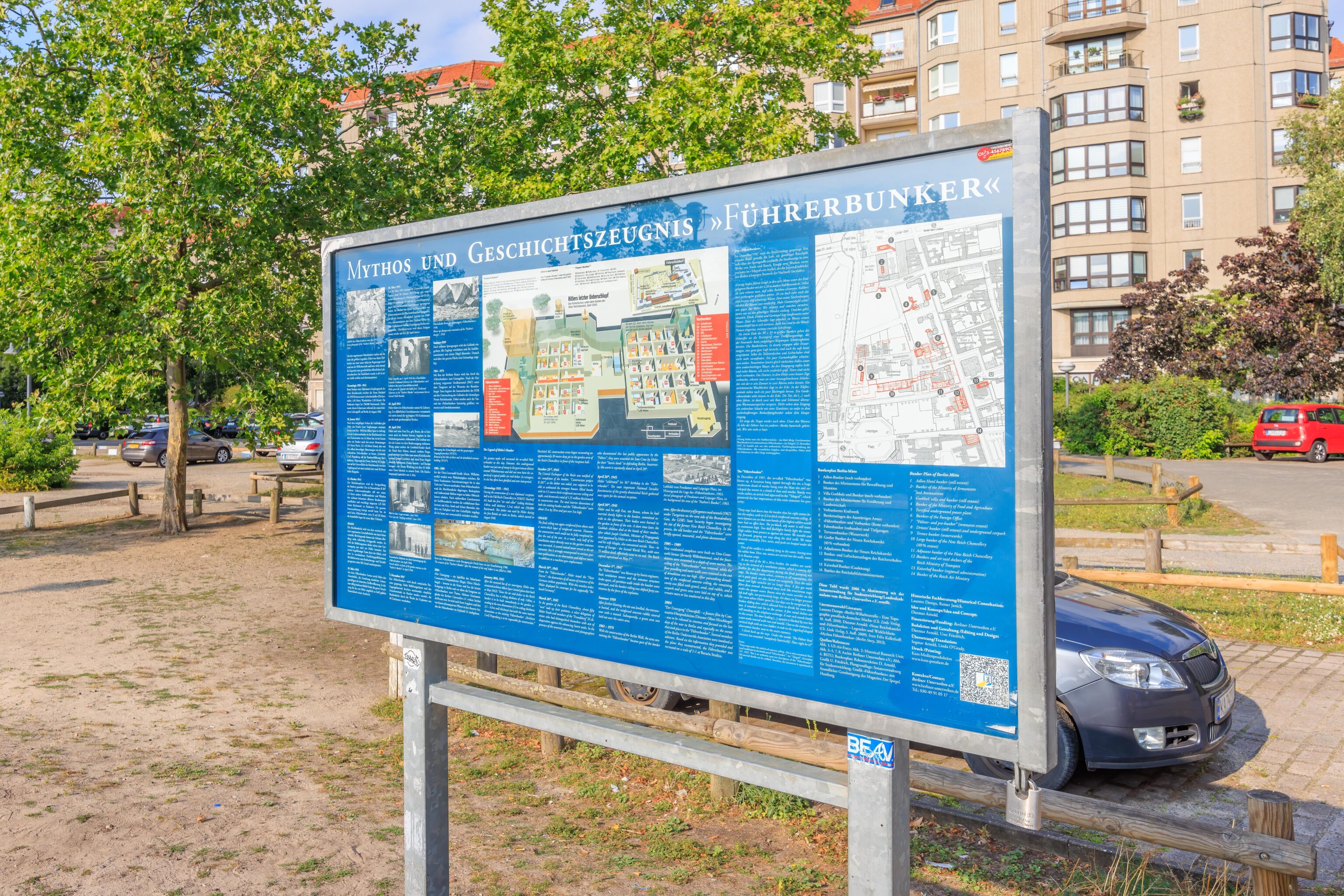
This sign is the only indication that there is some historical significance to the space currently occupied by a surface parking lot. This was the location of the Führerbunker, the bunker where Hitler shot himself and died, ultimately leading to an end to the war. The bunker was blown up by the Soviets soon after the war in 1947.
The sign has a QR code which seems to be a recent addition as there are photos of this sign which don’t have it. The smudges on the glass make the QR code unusable. But it is possible to try and make a photo of the sign more readable.
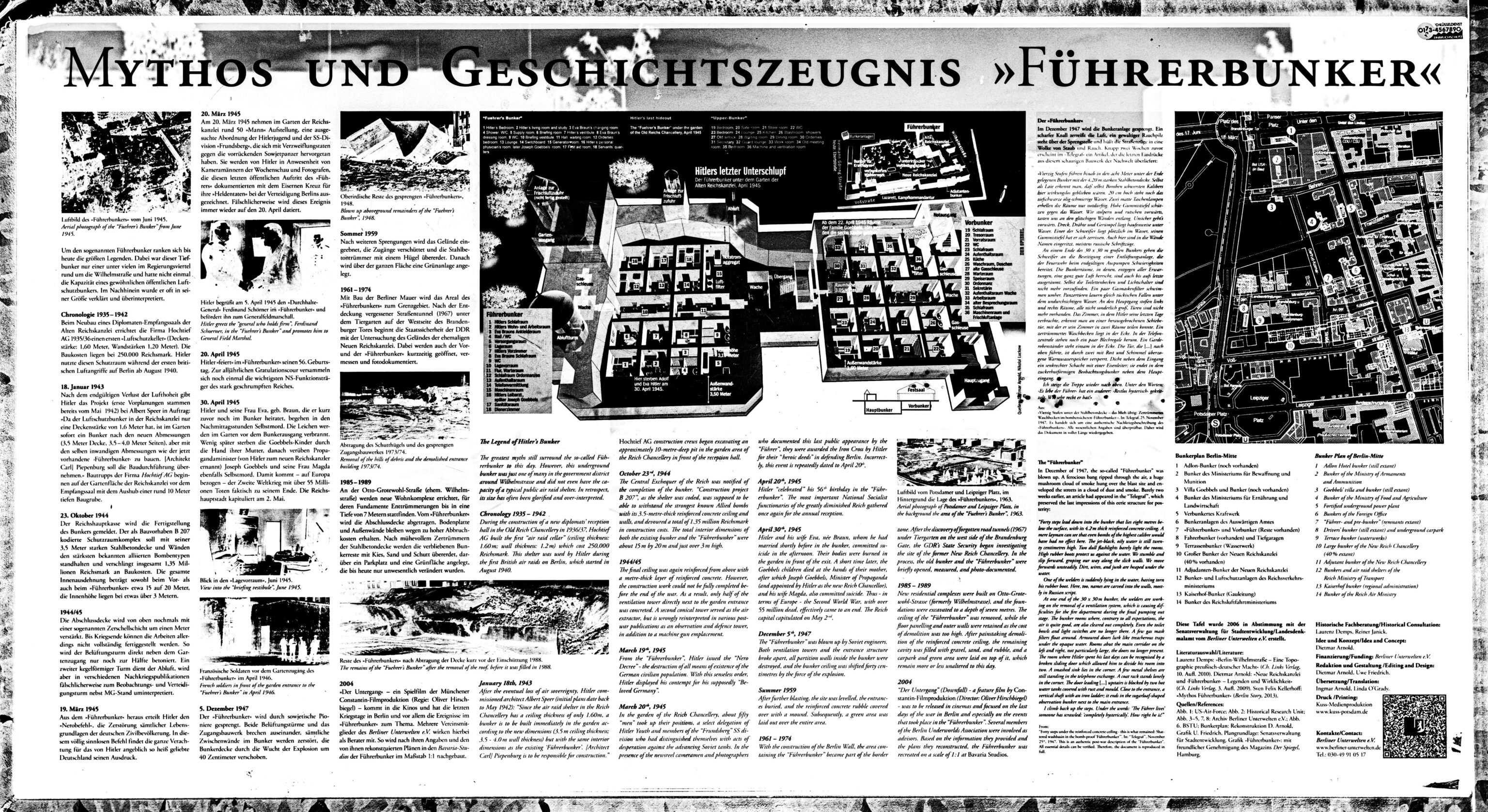
It is a very information dense sign with both German and English text. Much of it is a chronology of events at this site:
The Legend of Hitler's Bunker The greatest myths still surround the so-called Führerbunker to this day. However, this underground bunker was just one of many in the government district around Wilhelmstrasse and did not even have the capacity of a typical public air raid shelter. In retrospect, its size has often been glorified and over-interpreted. Chronology 1935-1942 During the construction of a new diplomats' reception ball in the Old Reich Chancellery in 1936/37, Hochtief AG built the first “air raid cellar" (ceiling thickness: 1.60m; wall thickness: 1.2m) which cost 250,000 Reichsmark. This shelter was used by Hitler during the first British air raids on Berlin, which started in August 1940. January 18th, 1943 After the eventual loss of air sovereignty, Hitler commissioned architect Albert Speer (initial plans date back to May 1942): "Since the air raid shelter in the Reich Chancellery has a ceiling thickness of only 1.60m, a bunker is to be built immediately in the garden according to the new dimensions (3.5m ceiling thickness; 3.5-4.0m wall thickness) but with the same interior dimensions as the existing Führerbunker. [Architect Carl Piepenburg is to be responsible for construction." Hochtief AG construction crews began excavating an approximately 10-metre-deep pit in the garden area of the Reich Chancellery in front of the reception hall. October 23rd, 1944 The Central Exchequer of the Reich was notified of the completion of the bunker. "Construction project B 207", as the shelter was coded, was supposed to be able to withstand the strongest known Allied bombs with its 3.5 metre thick reinforced concrete ceiling and walls, and devoured a total of 1.35 million Reichsmark in construction costs. The total interior dimensions of both the existing bunker and the "Führerbunker" were about 15 m by 20m and just over 3 m high. 1944/45 The final ceiling was again reinforced from above with a metre thick layer of reinforced concrete. However, the construction work could not be fully completed before the end of the war. As a result, only half of the ventilation tower directly next to the garden entrance was concreted. A second conical tower served as the air extractor, but is wrongly reinterpreted in various post-war publications as an observation and defence tower, in addition to a machine gun emplacement. March 19th, 1945 From the "Führerbunker", Hitler issued the "Nero Decree"- the destruction of all means of existence of the German civilian population. With this senseless order, Hitler displayed his contempt for his supposedly "Beloved Germany". March 20th, 1945 In the garden of the Reich Chancellery, about fifty "men" took up their positions, a select delegation of Hitler Youth and members of the "Frundsberg" SS division who had distinguished themselves with acts of desperation against the advancing Soviet tanks. In the presence of the newsreel cameramen and photographers who documented this last public appearance by the "Führer", they were awarded the Iron Cross by Hitler for their "heroic deeds" in defending Berlin. Incorrectly, this event is repeatedly dated to April 20". April 20th, 1945 Hitler "celebrated" his 56th birthday in the "Führerbunker". The most important National Socialist functionaries of the greatly diminished Reich gathered once again for the annual reception. April 30th, 1945 Hitler and his wife Eva, née Braun, whom he had married shortly before in the bunker, committed suicide in the afternoon. Their bodies were burned in the garden in front of the exit. A short time later, the Goebbels children died at the hands of their mother, after which Joseph Goebbels, Minister of Propaganda (and appointed by Hitler as the new Reich Chancellor), and his wife Magda, also committed suicide. Thus - in terms of Europe - the Second World War, with over 55 million dead, effectively came to an end. The Reich capital capitulated on May 2nd. December 5th, 1947 The "Führerbunker" was blown up by Soviet engineers. Both ventilation towers and the entrance structure broke apart, all partition walls inside the bunker were destroyed, and the bunker ceiling was shifted forty centimetres by the force of the explosion. Summer 1959 After further blasting, the site was levelled, the entrances buried, and the reinforced concrete rubble covered over with a mound. Subsequently, a green area was laid out over the entire area. 1961-1974 With the construction of the Berlin Wall, the area containing the "Führerbunker" became part of the border zone. After the discovery of forgotten road tunnels (1967) under Tiergarten on the west side of the Brandenburg Gate, the GDR's State Security began investigating the site of the former New Reich Chancellery. In the process, the old bunker and the "Führerbunker" were briefly opened, measured, and photo-documented. 1985-1989 New residential complexes were built on Otto-Grotewohl-Strasse (formerly Wilhelmstrasse), and the foundations were excavated to a depth of seven metres. The ceiling of the "Führerbunker" was removed, while the floor panelling and outer walls were retained as the cost of demolition was too high. After painstaking demolition of the reinforced concrete ceiling, the remaining cavity was filled with gravel, sand, and rubble, and a carpark and green area were laid on top of it, which remain more or less unaltered to this day. 2004 "Der Untergang" (Downfall) - a feature film by Constantin-Filmproduktion (Director: Oliver Hirschbiegel) was to be released in cinemas and focused on the last days of the war in Berlin and especially on the events that took place in the "Führerbunker". Several members of the Berlin Underworlds Association were involved as advisors. Based on the information they provided and the plans they reconstructed, the Führerbunker was recreated on a scale of 1:1 at Bavaria Studios.
There is a subsequent section which talks about what seems like a first-hand account in the Telegraf newspaper:
The "Führerbunker" In December of 1947, the so-called "Führerbunker" was blown up. A ferocious bang ripped through the air, a huge mushroom cloud of smoke hung over the blast site and enveloped the streets in a cloud of dust and smoke. Barely two weeks earlier, an article had appeared in the "Telegraf”, which preserved the last impressions of this eerie structure for posterity: "Forty steps lead down into the bunker that lies eight metres below the surface, with its 4.2m thick reinforced concrete ceiling. A mere layman can see that even bombs of the highest calibre would have had no effect here. The jet-black, oily water is still twenty centimetres high. Two dull flashlights barely light the rooms. High rubber boots protect us against the water. We stumble and slip forward, groping our way along the slick walls. We move forwards unsteadily. Dirt, wires, and junk are heaped under the water. One of the welders is suddenly lying in the water, having torn his rubber boot. Here, too, names are carved into the walls, mostly in Russian script. At one end of the 30 x 30m bunker, the welders are working on the removal of a ventilation system, which is causing difficulties for the fire department during the final pumping out stage. The bunker rooms where, contrary to all expectations, the air is quite good, are also cleared out completely. Even the toilet bowls and light switches are no longer there. A few gas mask filters float around. Armoured doors lurk like treacherous traps under the opaque water. Rooms abut the main corridor on the left and right, not particularly large, the doors no longer present. The room where Hitler spent his last days can be recognised by a broken sliding door which allowed him to divide his room into two. A smashed sink lies in the corner. A few metal shelves are still standing in the telephone exchange. A coat rack stands lonely in the corner. The door leading [...] upstairs is blocked by two hot water tanks covered with rust and mould. Close to the entrance, a vertical shaft with an iron ladder; it ends in the sugarloaf-shaped observation bunker next to the main entrance. I climb back up the steps. Under the words: 'The Führer lives' someone has scrawled: 'completely hysterically. How right he is!" From: "Forty steps under the reinforced concrete ceiling - this is what remained: Shattered washbasin in the bomb-proof Führerbunker"". In: "Telegraf", November 25th, 1947. This is an authentic post-war description of the "Führerbunker". All essential details can be verified. Therefore, the document is reproduced in full.
There is a German Wikipedia article about a former newspaper named Telegraf. It was founded in 1946 and ended publication in 1972.
We started walking to the west at the intersection by the parking lot.
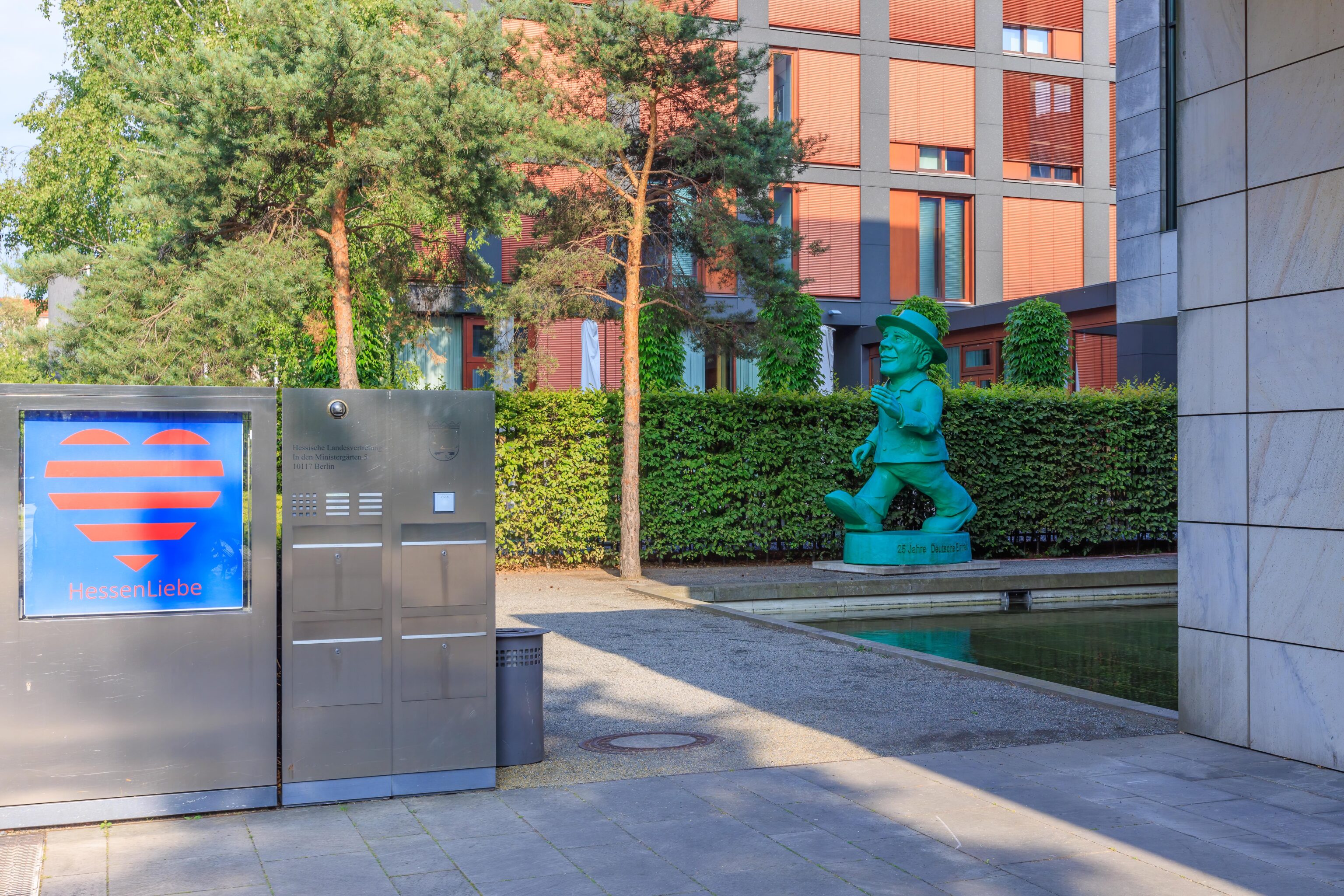
This building is labelled on Google Maps as Vertretung des Landes Hessen beim Bund (Representation of the state of Hesse to the federal government). Hessen is the state that includes the city of Frankfurt am Main. We noticed the green sculpture that is tucked away by the hedge. Berlin Love has a page about this sculpture! It is an Ampelmann that was created for the 25th anniversary of unified Germany.
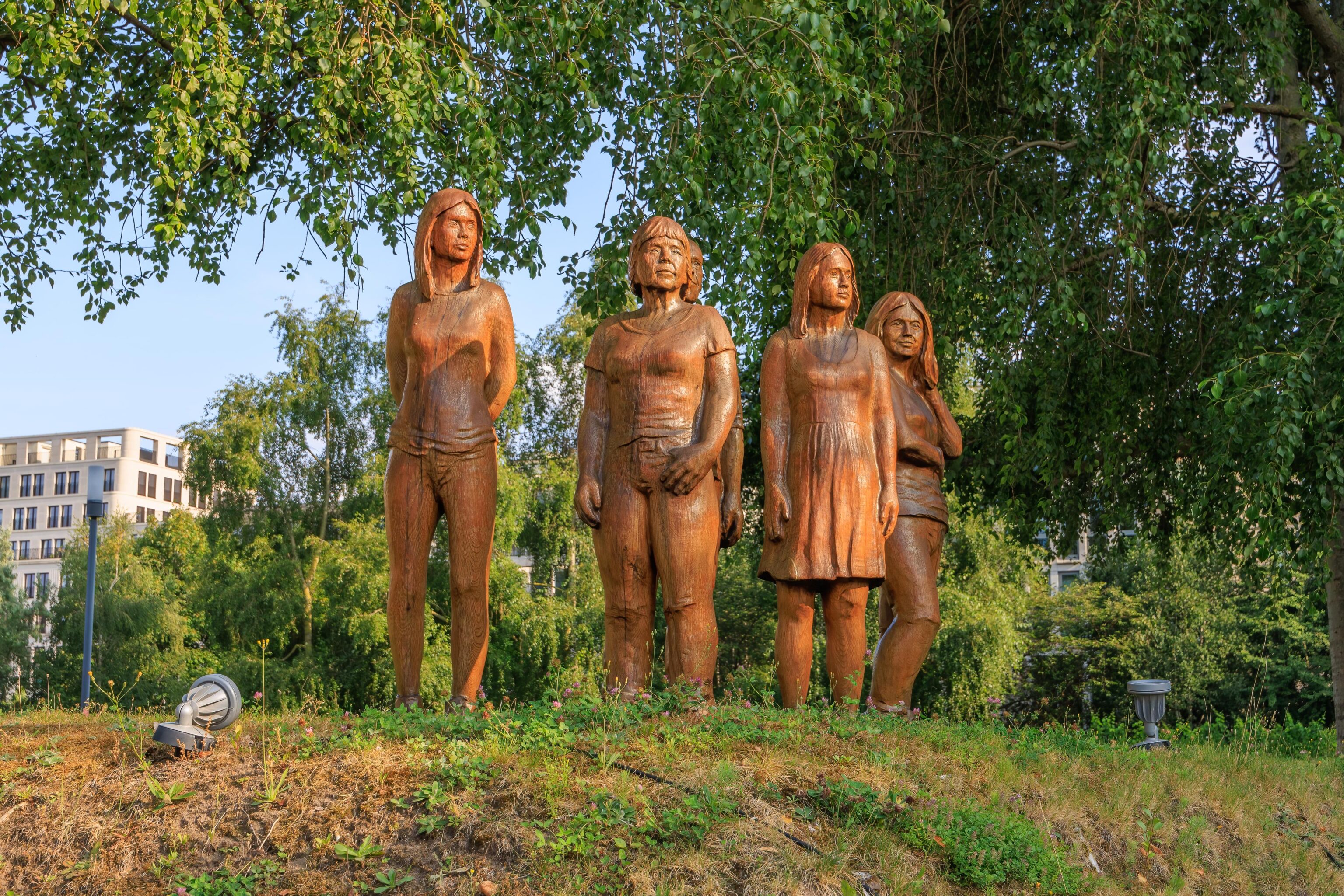
These five wood carved statues are on a small hill at the very west end of the Hessen property. The fifth one is a bit hard to see as it is almost completely obscured behind the second statue from the left. There is a small sign nearby that reads, in German:
Eichenholzskulpturen für die Hessische Landesvertretung
This translates to:
Oak wood sculptures for the Hessian State Representation
Berliner Woche has an article about these four statues. The article, by Klaus Tolkmitt, reads (via Google Translate):
During a walk between Potsdamer Platz and the Brandenburg Gate, at the level of the Hessian State Representation on the corner of Ebertstraße and In den Ministergarten, a sculpture standing on a hill catches your eye. In 2017, the Hessian artist Stephan Guber created the project: "We - cosmopolitan, individual, respectful" with five life-size human oak wood sculptures and arranged them into a group. Guber worked for two years on the installation, which was given an “exposed place” on the site with the remains of the Reich Chancellery bunker. In addition, the area was in the middle of the death strip during the division of Germany. "We" is a circle of people in which one's own person is included - but "we" is also the circle that closes and excludes others as not belonging, namely "you". It depends on the vantage point from which someone not only observes but also speaks. Stephan Guber takes up these themes by creating five very different human sculptures that form a group because of their distinct individuality. They enter into a subtle dialogue with themselves, with each other, but also with the viewer through their positioning, posture, facial expressions and gaze. Text and photo: Klaus Tolkmitt
At this intersection by the statues, we crossed the street and started walking south. We soon arrived at Potsdamer Platz.
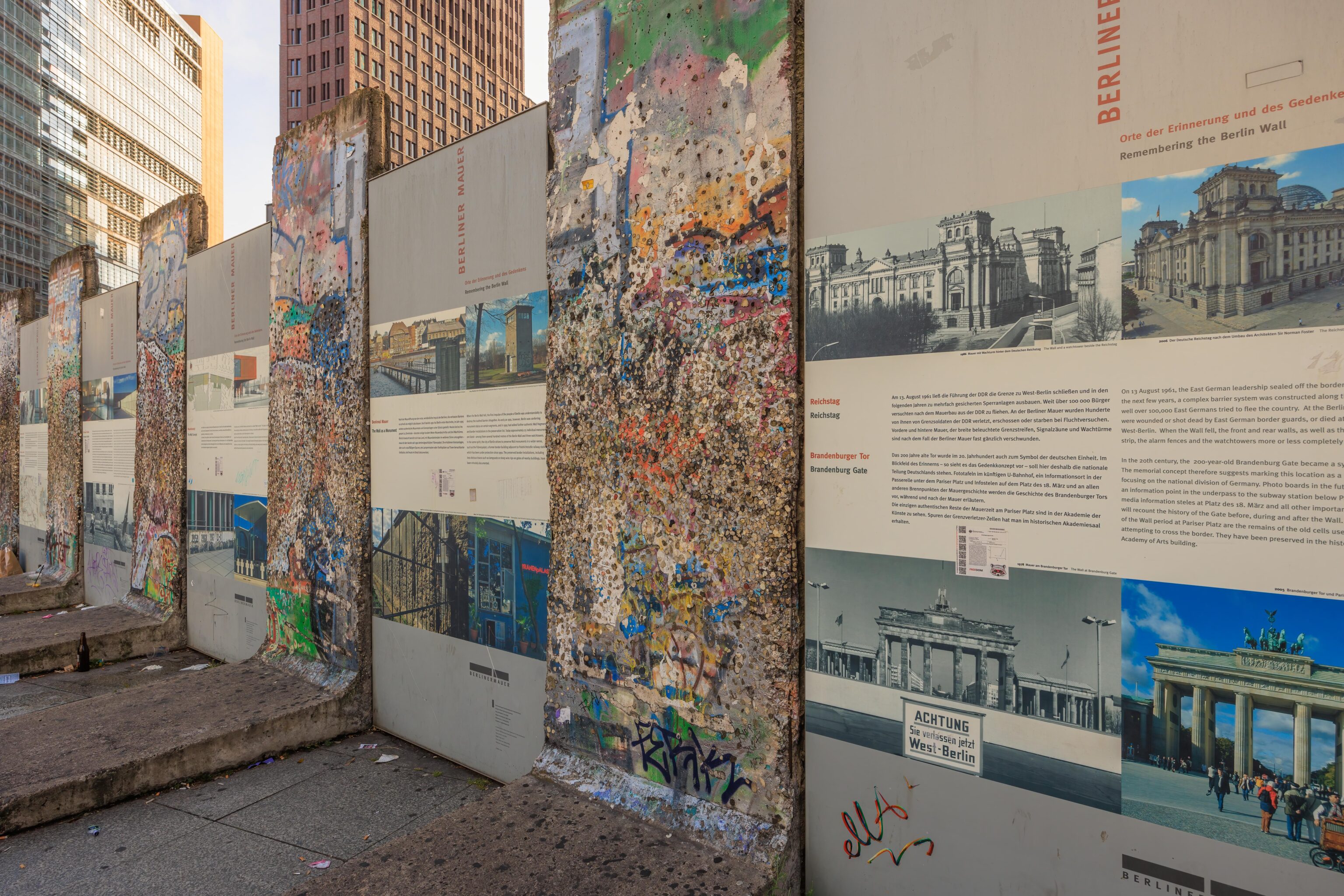
Every place we visited after arriving at Unter den Linden was on the East German side of the Berlin Wall. The wall ran through Potsdamer Platz. Today, the wall is gone here. But wall sections have been put up along with some informational displays.
The ground below the signs looks a bit unclean. There is a reason for that…
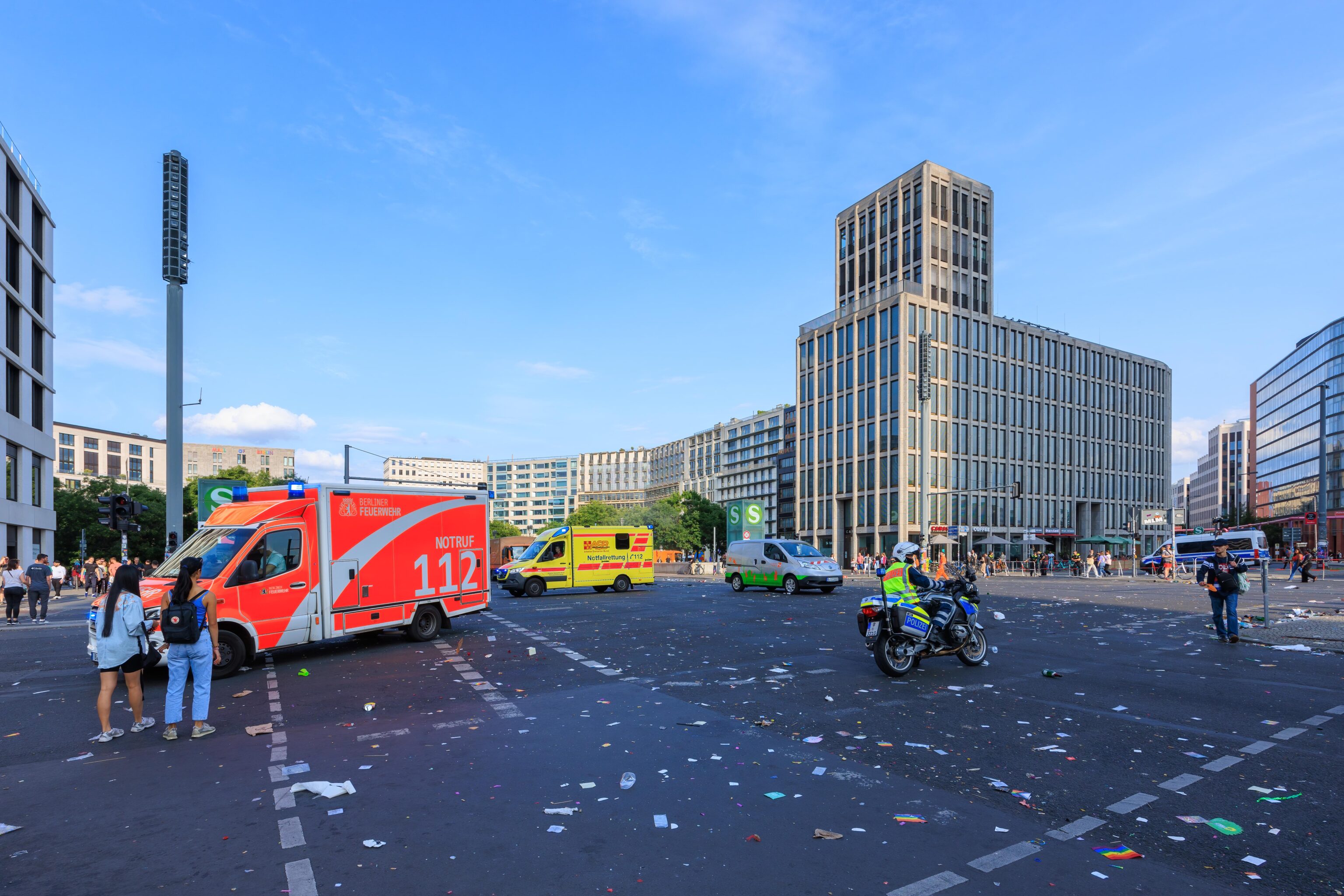
The whole area was kind of a mess! There were smashed glass bottles everywhere along with trash on the ground. A bit clean up effort was underway. There was an event here for Christopher Street Day. It looks like we got here after it had ended.
After getting a wurst from a wurst stand, we caught the U-Bahn from the station here. Well, we actually went down to the S-Bahn station, found out that it doesn’t seem to have an underground connection to the U-Bahn, and headed back up to go to the proper entrance.
Stadtmitte
We took the U-Bahn two stops to Stadtmitte, just south of our hotel. We made it to Rausch Schokoladenhaus (Rausch Chocolate House) just before they closed for the day. It is a three level store with a cafe on the highest floor. We went to the cafe and were seated, though could only order items that could be prepared quickly. We settled on an eiskaffe and eisschokolade. Both were good.
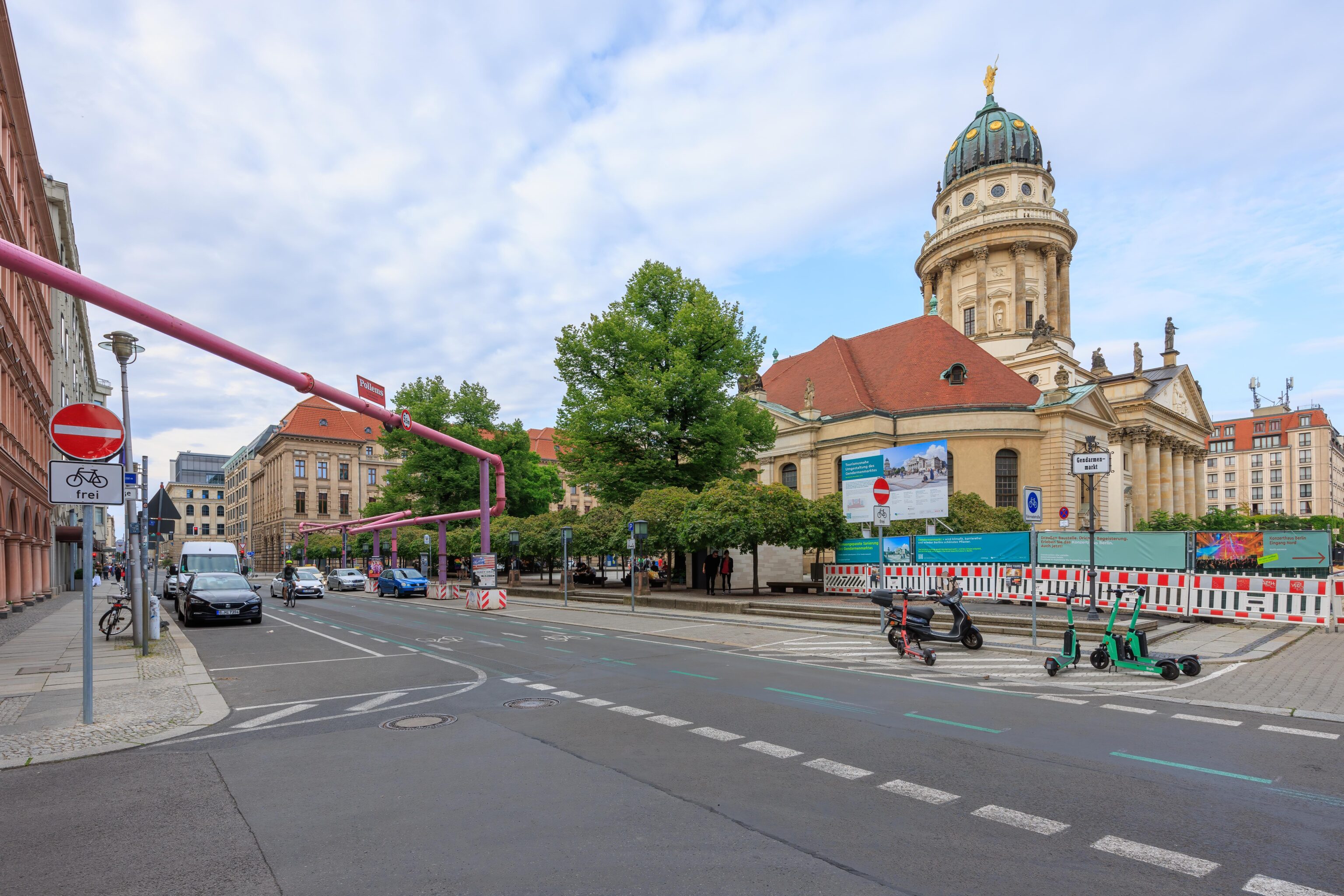
Afterwards, we started to walk back to our hotel. It was one stop away via U-Bahn or about 5 blocks on foot. One unusual sight in Berlin is these above ground pipes. They come in various colors, including pink.
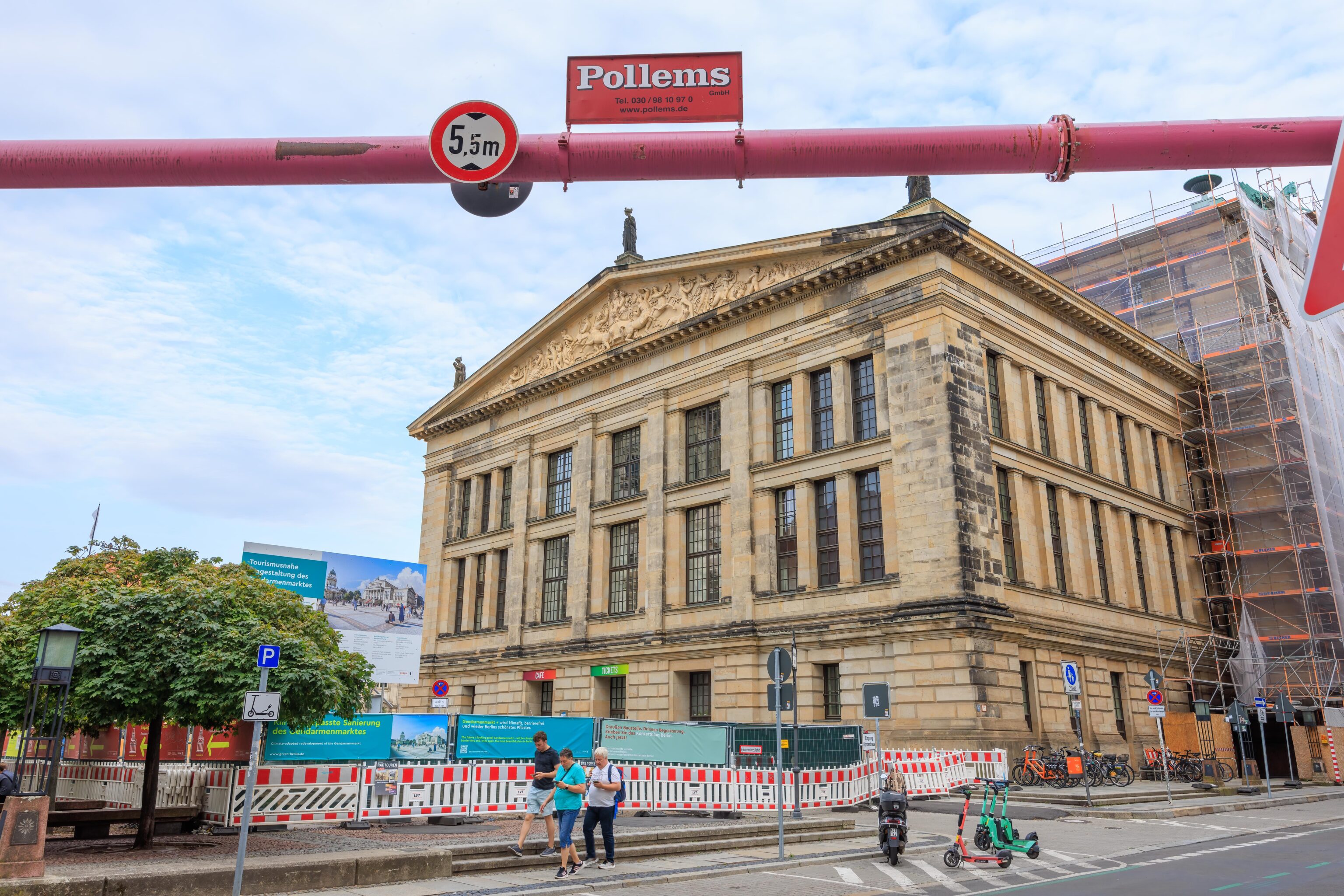
Berlin has a very high water table. As a result, whenever there is construction or other activity that requires digging, the water must be drained. This is done by pumping it into above ground pipes to take the water away, ultimately to the Spree either directly or via a canal. More Than Green has a nice short article about this system. Vive Berlin has a slightly longer article that is also a good read.
The pink ones are placed by a company named Pollems. Their website has some text about what they do, though it is in German. The relevant service that they provide (translated via Google Translate) is:
Temporary pipelines with pipe bridge constructions and discharge structures to divert the collected pumped water into discharge shafts or receiving waters
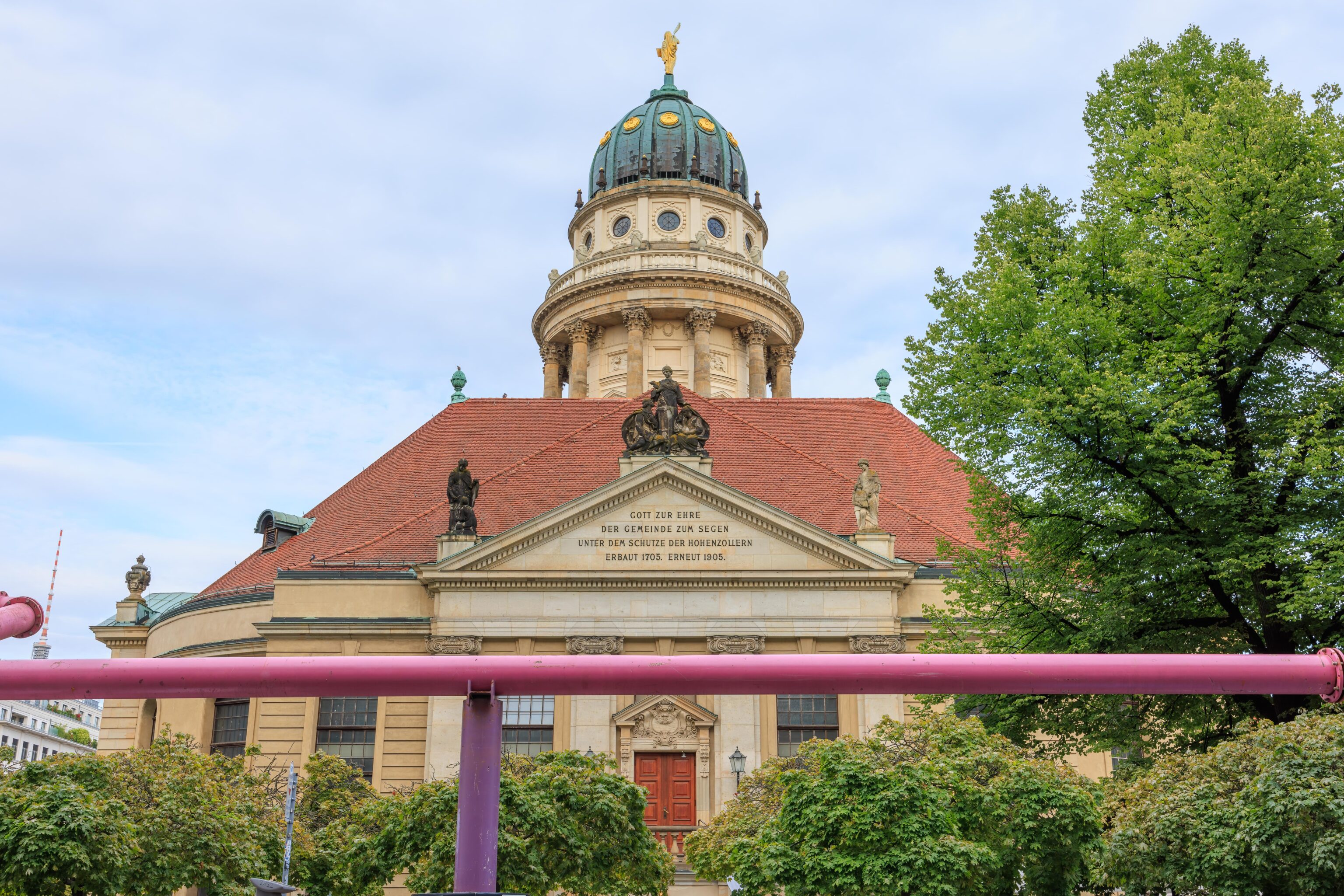
This building, which was in the background two photos ago, is the Französischer Dom (French Cathedral). It was already closed for the day when we walked by. This church is on the north side of the Gendarmenmarkt. Neue Kirche (New Church), also known as the Deutscher Dom (German Church), is on the south side. It shares the same dome design as the Französischer Dom which is rather confusing! Also oddly, why is the French building misidentified in English as a cathedral but the German one is not?
The Westin Grand Berlin
We soon returned to The Westin Grand Berlin and got our room keys. We booked a Deluxe room but were upgraded to a Suite. It ended up being a fantastic upgrade!
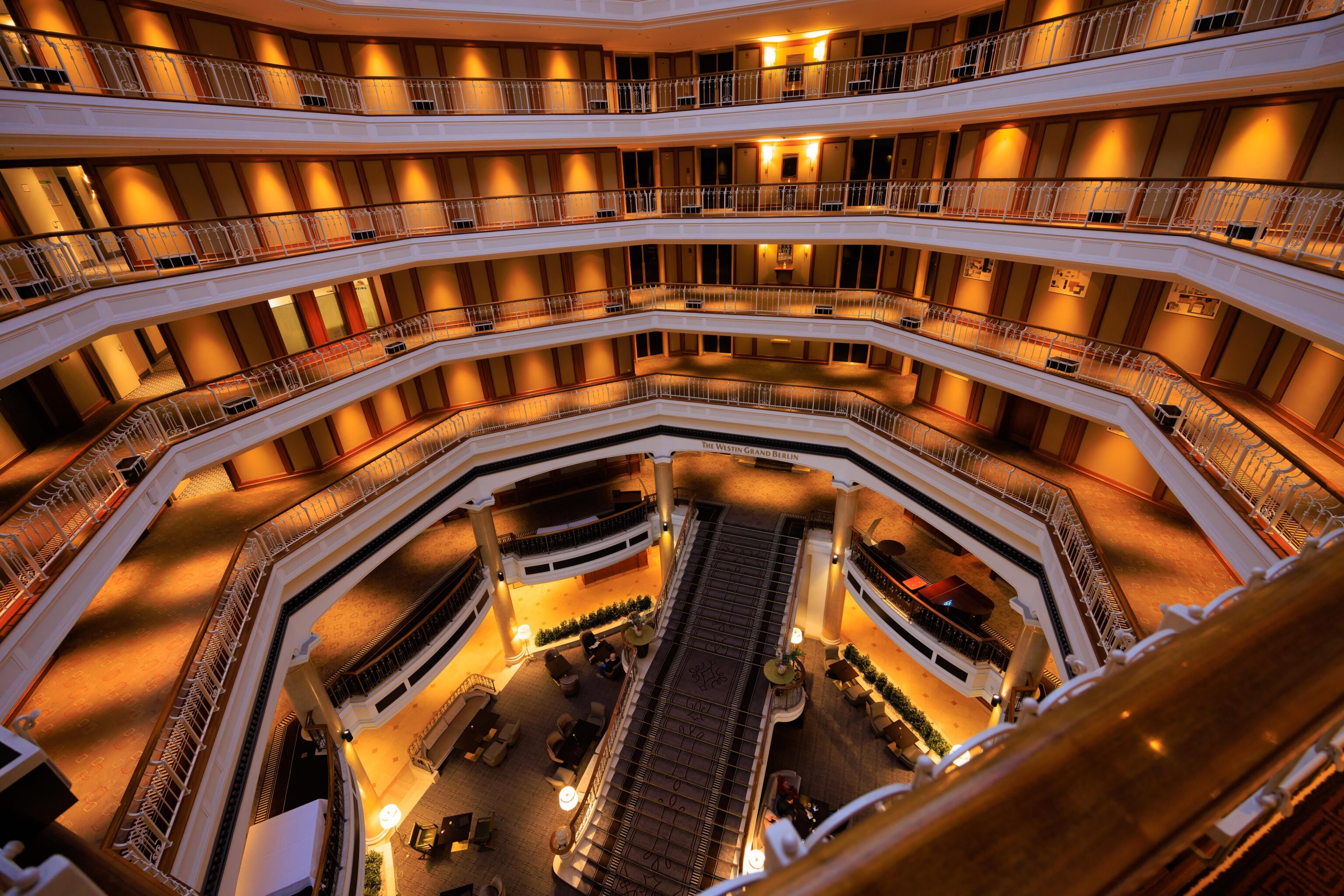
The interior layout of the hotel is a bit unconventional. It has a fair sized atrium above the lobby entrance area. But the rooms are not really laid out around the atrium. The rooms are in an L shape with the atrium occupying some of the center space. The rooms also extend in two directions well beyond the atrium area. There also seems to be a center courtyard area, though we didn’t see it as our room was not in that part of the building.
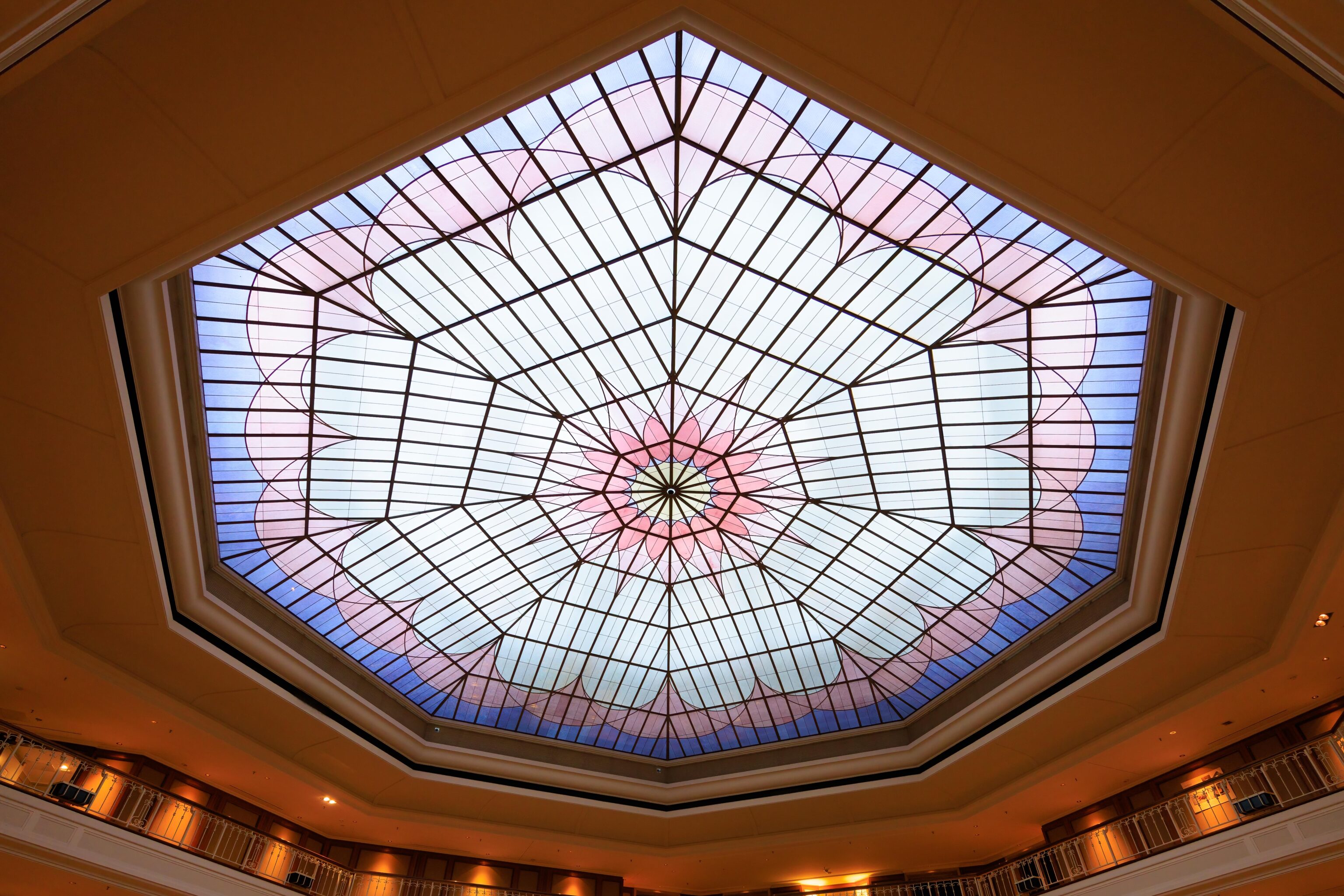
The top of the atrium is quite pretty!
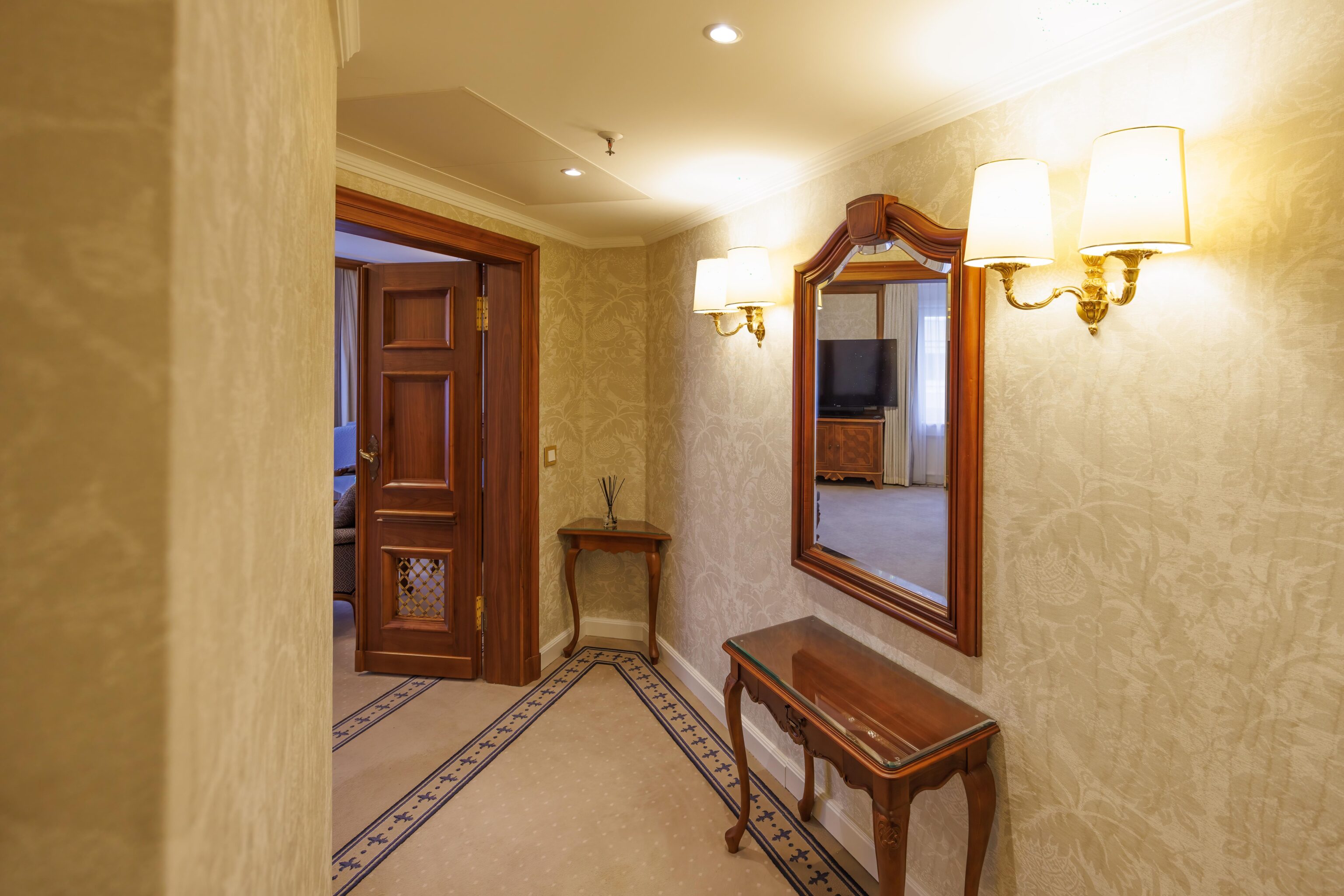
While our previous room at the Le Méridien Grand Hotel Nuremberg was a Junior Suite, basically just a bigger room, this one was a true suite. There was a small entrance area which had French doors leading to the living room.
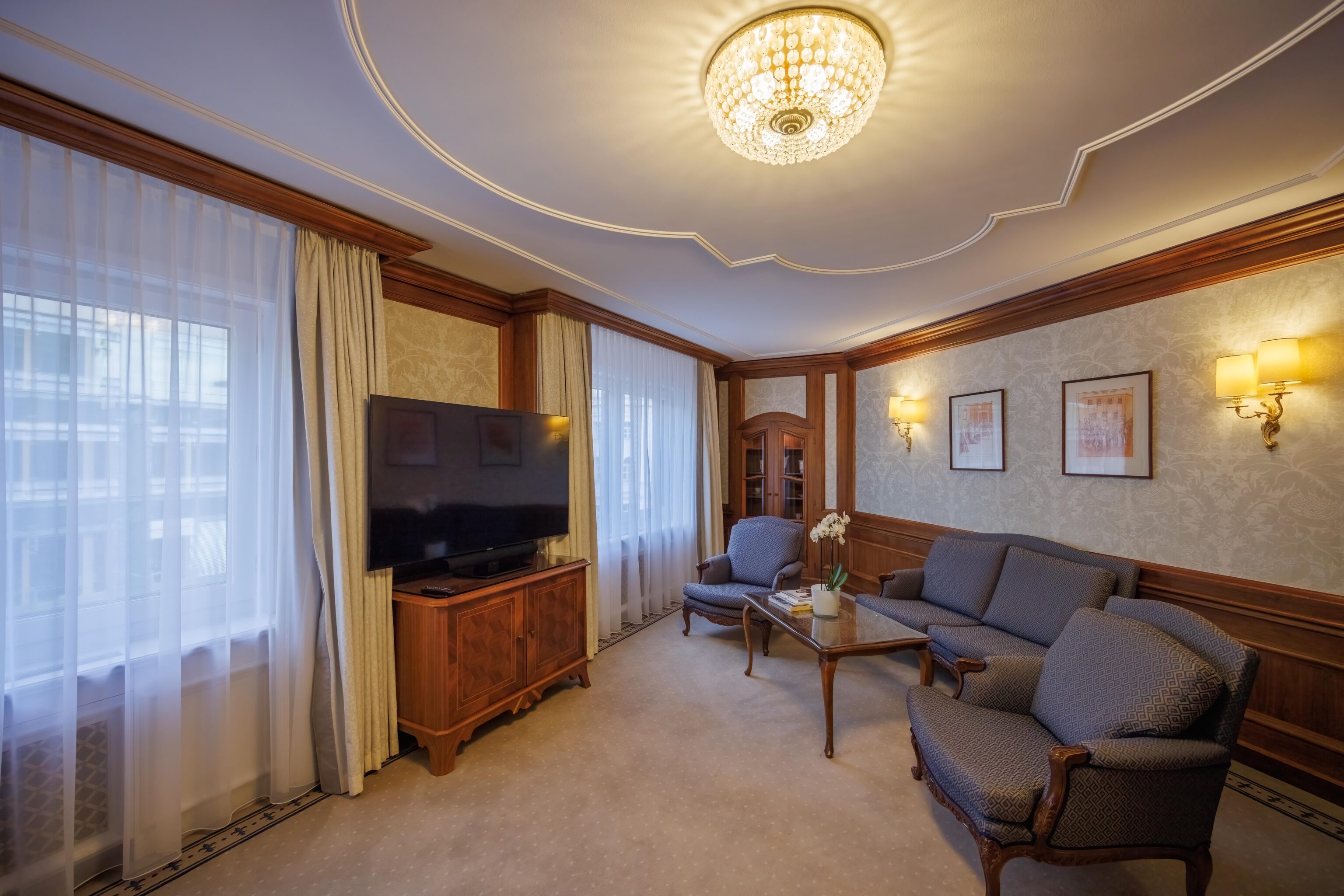
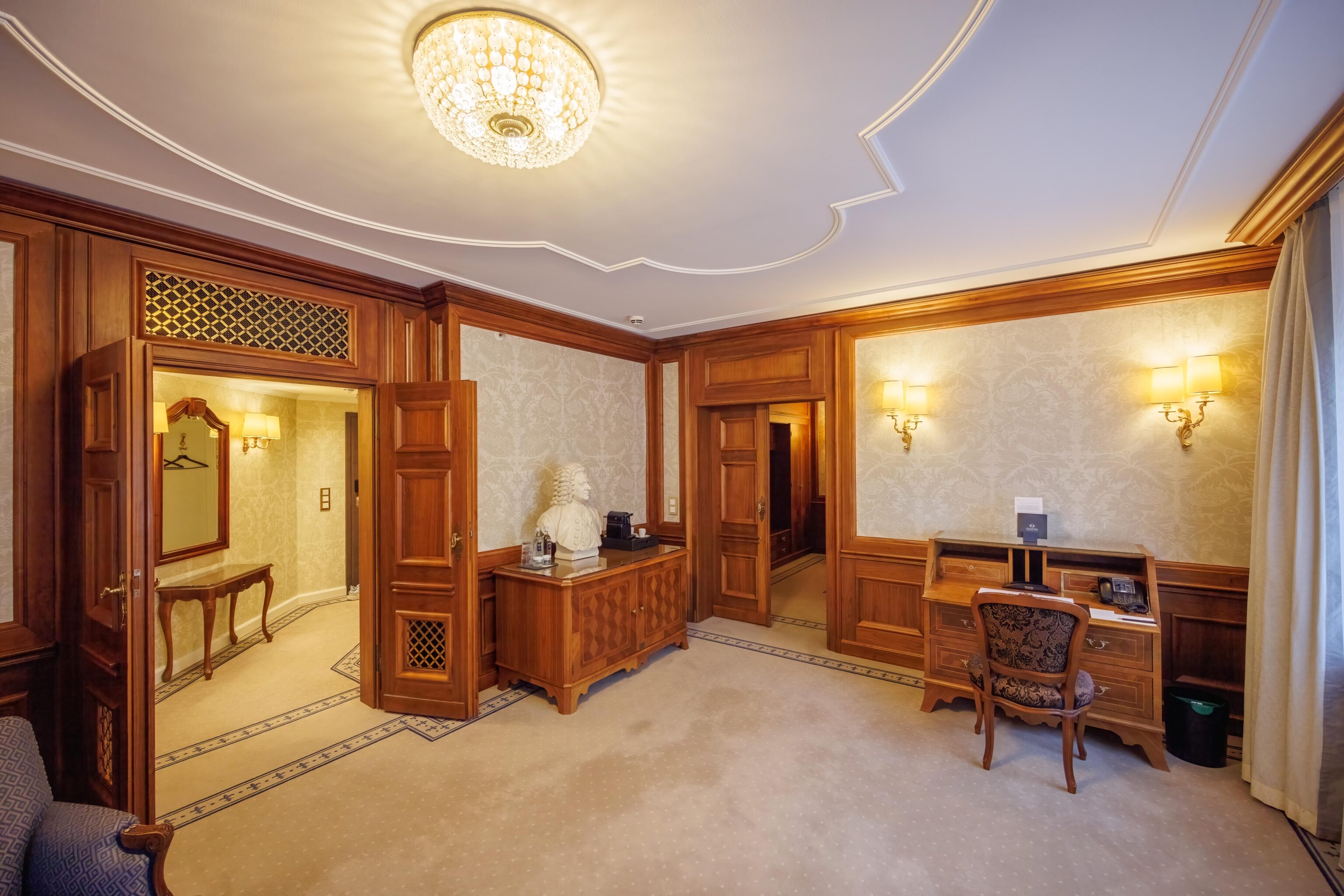
The living room was large, bigger than most standard hotel rooms, even compared to the US where we tend to have larger rooms.
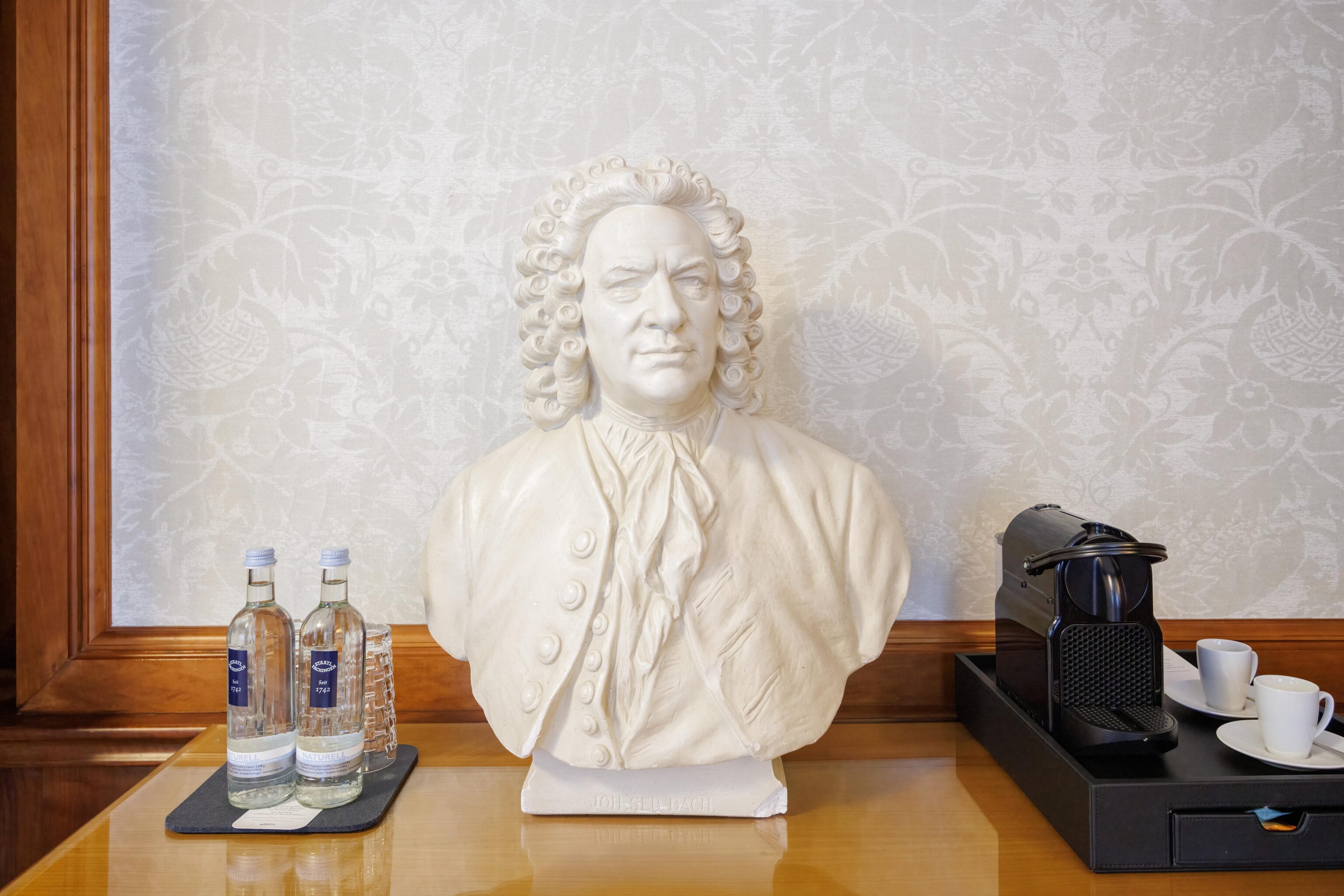
One interesting feature of the room is this bust. It is of the legendary German composer Johann Sebastian Bach. Presumably, all the suites are named after famous Germans. Ours was the Bach Suite. We were next to the Goethe Suite. Presumably, there is a bust of Johann Wolfgang von Goethe in that room, though we don’t know for sure.
Also of interest is in the display cabinet in the far corner of the room. There are various plates and mugs in there. Taking a closer look at the plates, we found out something interesting.
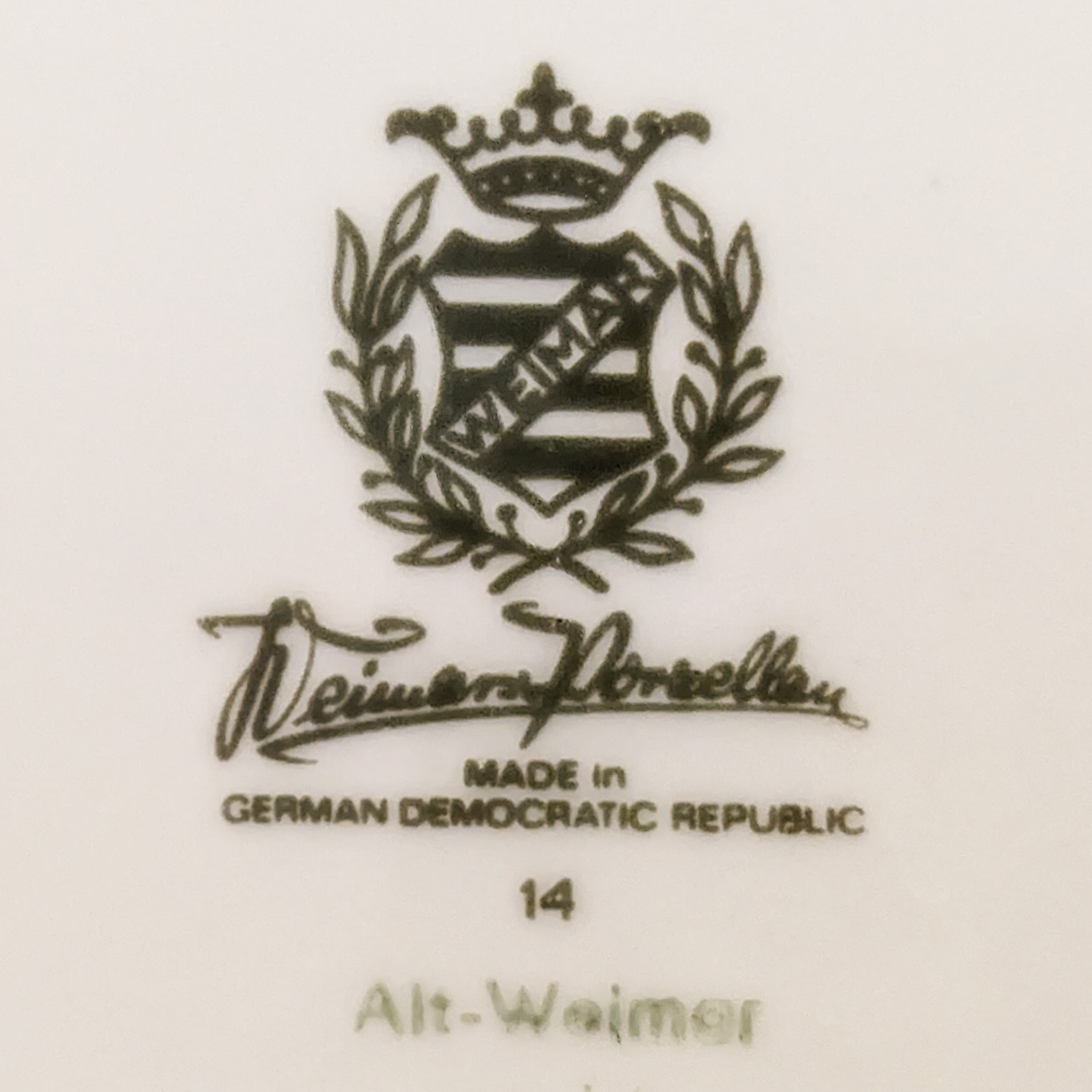
The plates were made in the German Democratic Republic, more commonly known in the US at least as East Germany! There is a Wikipedia article about Weimar Porzellan which appears to be the manufacturer. The article mentions the company being nationalized by the Soviets prior to the formation of the DDR/GDR.
The hotel first opened in 1987 as an East German state owned hotel catering to foreign tourists to get foreign currency. Maybe the plates have been around since then? The hotel’s Wikipedia article has a good summary:
The hotel was opened as the Grand Hotel Berlin on August 1, 1987 by East German leader Erich Honecker as part of the city-wide celebrations of the 750th anniversary of the founding of Berlin. It was only open to foreign guests, as it did not accept East German Marks, only Western hard currencies.
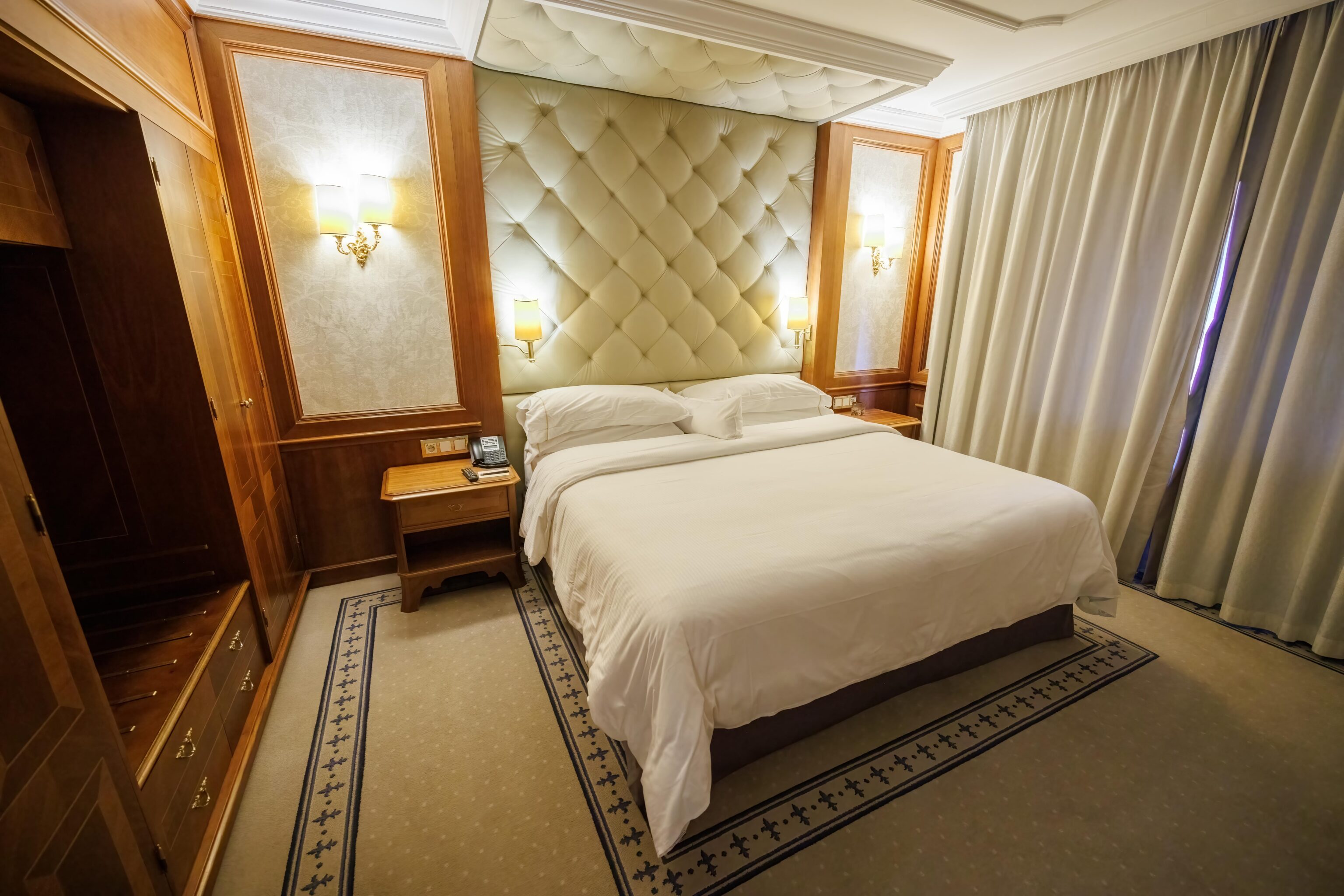
The bedroom was a good size for a suite with a comfortable bed.
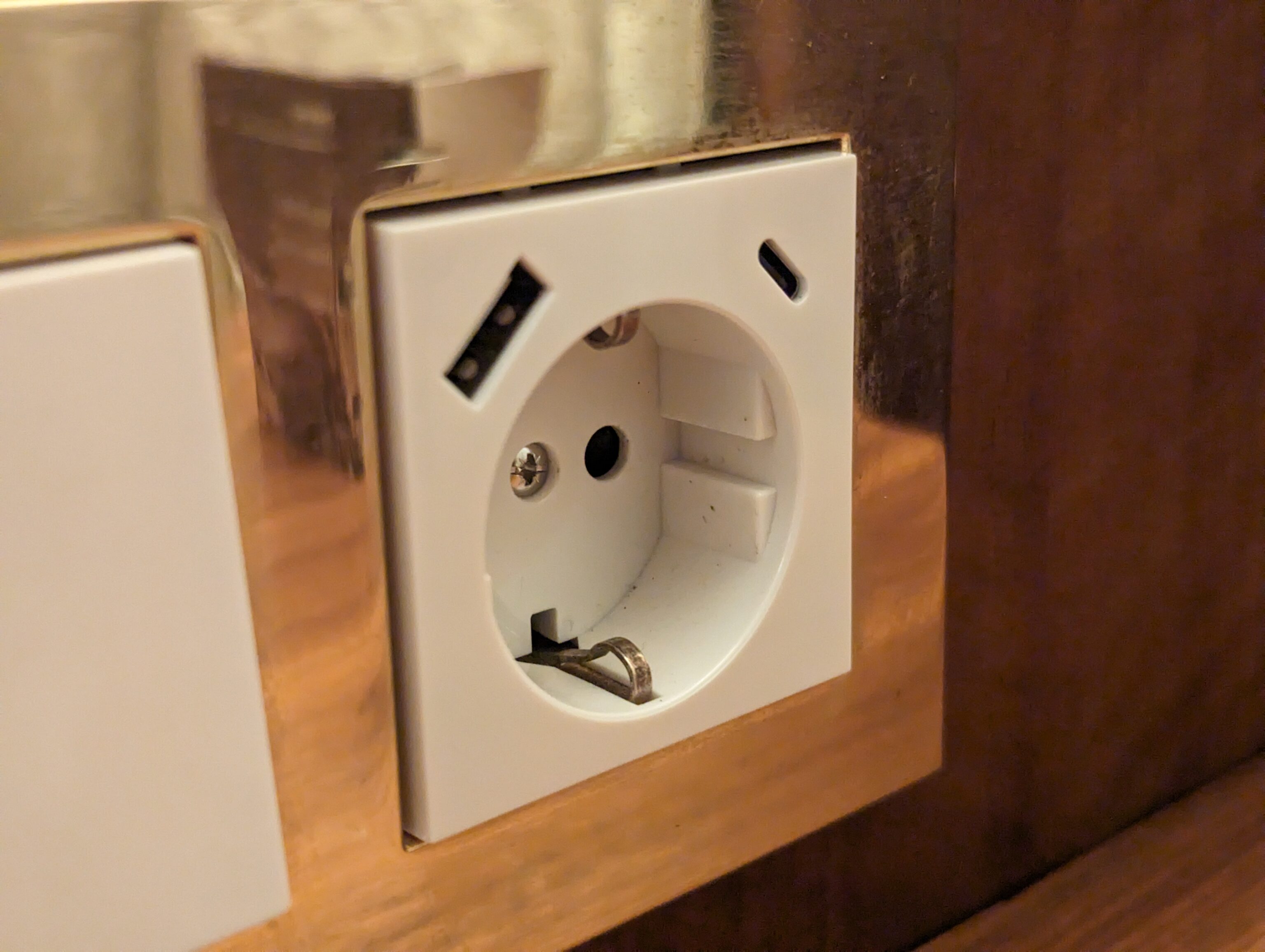
One unexpected feature was the presence of USB-C on the electrical outlets! The decor in the hotel definitely does not give the impression of anything being modern. And yet, USB-C is something that is almost completely lacking in hotels, even recent renovations and new builds.
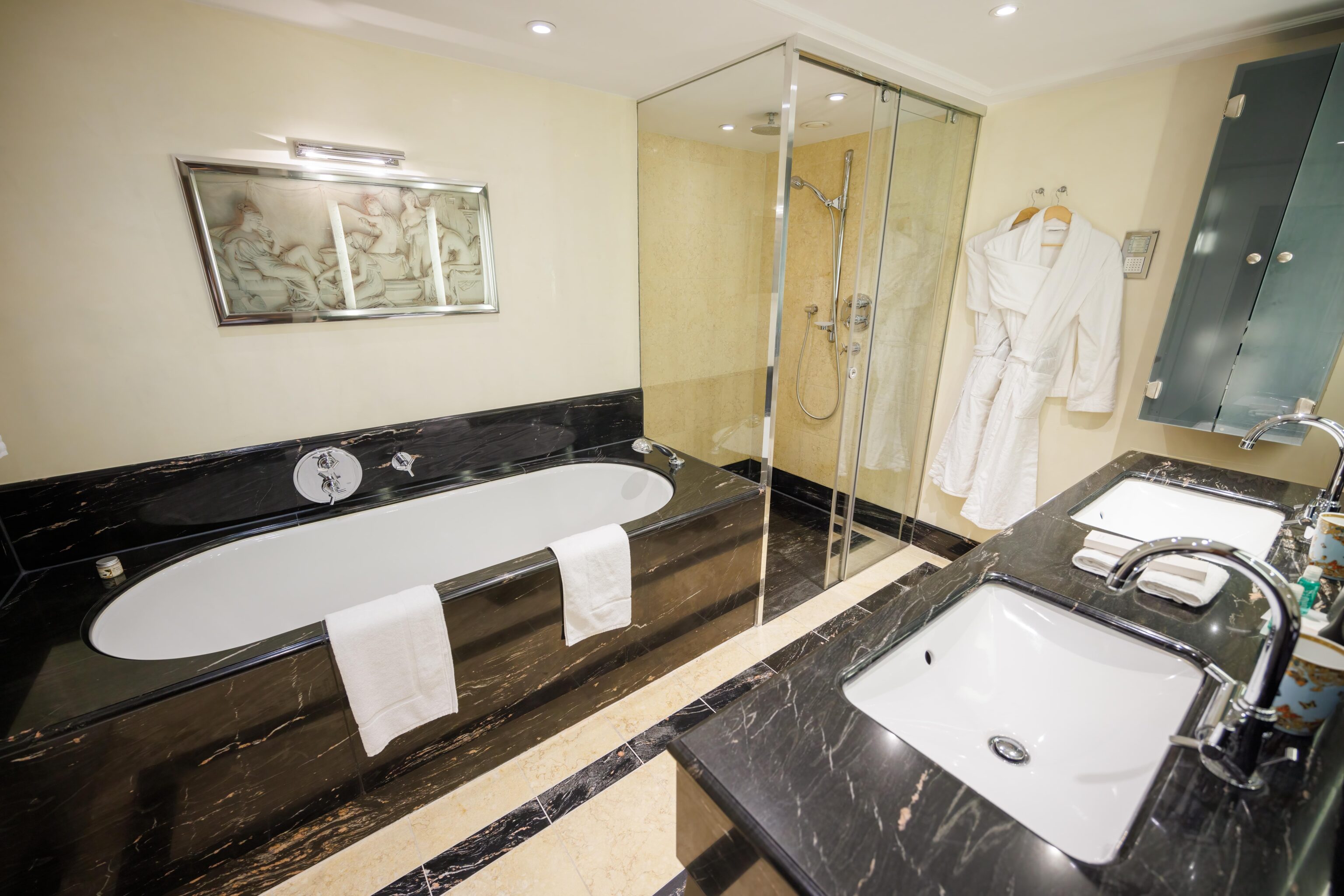
The bathroom was very nice with a big tub and decently sized shower as well as twin sinks.
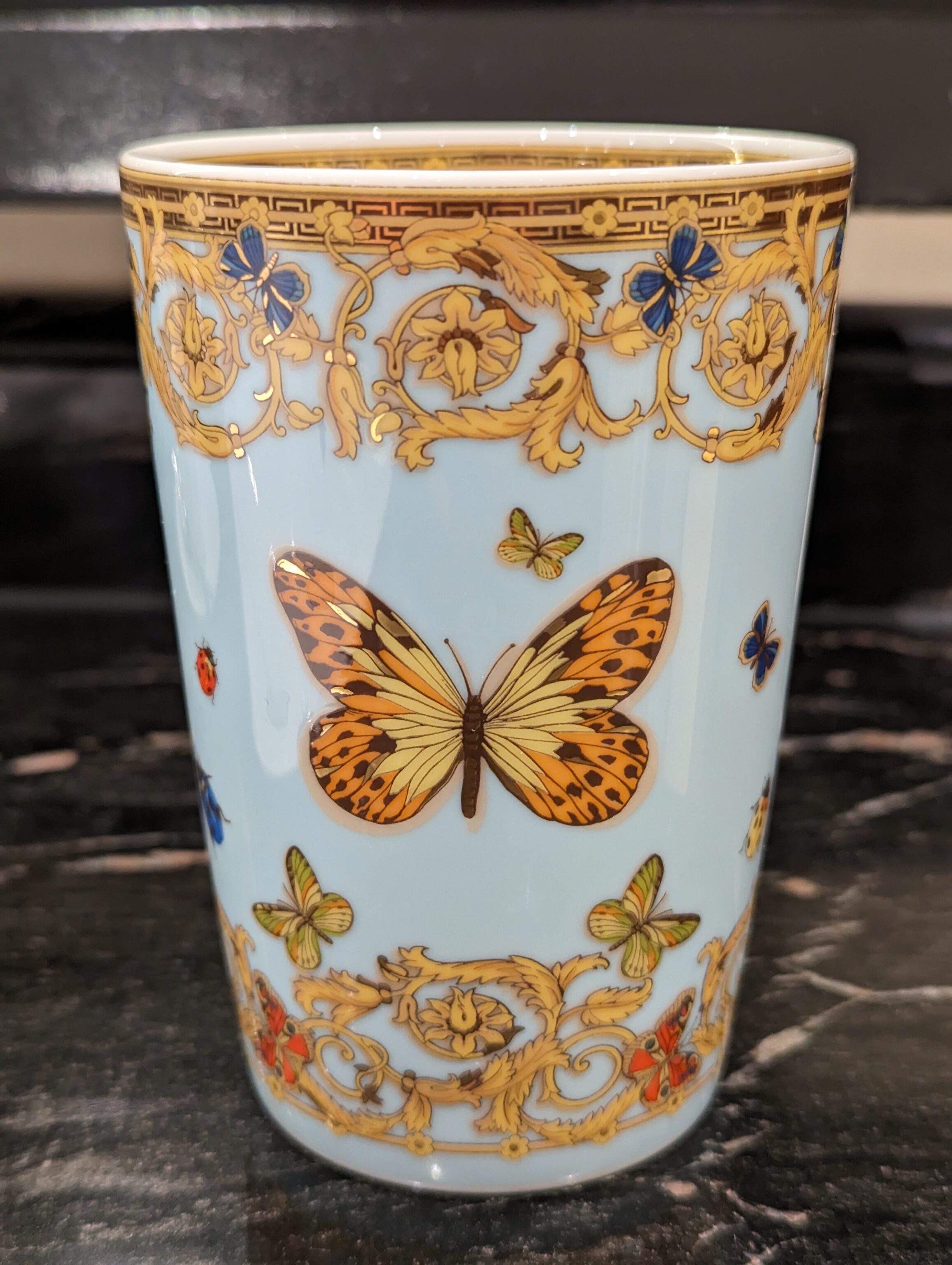
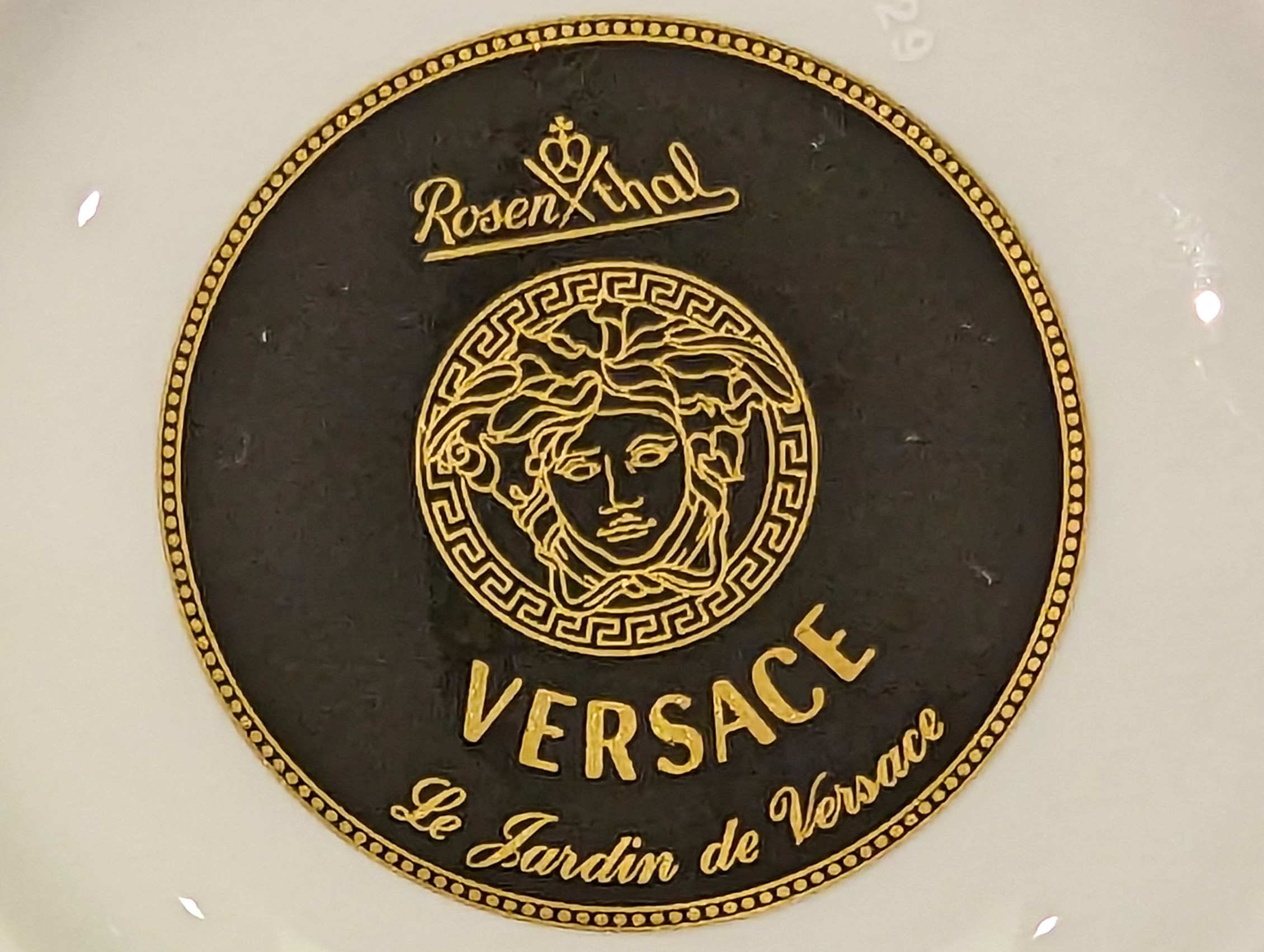
The cups in the bathroom are made by Rosenthal, a German porcelain manufacturer. These Versace branded Le Jardin de Versace cups retail for €109. They sell for $175 in the United States.
The company that made the East German plates, Weimar Porzellan, is currently owned by Turpin Rosenthal who is the grandson of the founder of Rosenthal.
